
Predictive Analytics: The Power to Predict Who Will Click, Buy, Lie, or Die
by
Eric Siegel
Published 19 Feb 2013
To assemble Watson, IBM crated in a mammoth configuration of hardware, about 10 refrigerators’ worth. Watson didn’t go to Jeopardy!; Jeopardy! came to Watson, setting up a temporary game show studio within IBM’s T. J. Watson Research Center. Double Jeopardy!—Would Watson Win? Watson was not sure to win. During sparring games against human champions, Watson had tweaked its way up to a 71 percent win record. It didn’t always win, and these trial runs didn’t pit it against the lethal competition it was preparing to face on the televised match: all-time leading Jeopardy! champions Ken Jennings and Brad Rutter. Reproduced with permission. The Jeopardy! match was to gain full-scale media publicity, exposing IBM’s analytical prowess or failure.
…
Robert Jewell, IBM, “Putting IBM Watson to Work,” Predictive Analytics World Boston Conference, October 2, 2012, Boston, MA. www.predictiveanalyticsworld.com/boston/2012/agenda.php#day2–1kn. Clive Thompson, “What Is IBM’s Watson?” New York Times, June 16, 2010. www.nytimes.com/2010/06/20/magazine/20Computer-t.html. “Smartest Machine on Earth,” Nova, PBS, originally aired May 2, 2012. www.pbs.org/wgbh/nova/tech/smartest-machine-on-earth.html. Roger Craig, the PA practitioner and Jeopardy! winner: Roger Craig, “Data Science Meets the Quiz Show Jeopardy!” Predictive Analytics World Chicago Conference, June 26, 2012, Chicago, IL. www.predictiveanalyticsworld.com/chicago/2012/agenda.php#day2–11. Chris Jones, “If You Could Master All the Data in the World. . .,” Esquire, January 25, 2012. www.esquire.com/features/roger-craig-jeopardy-champ-0212.
…
TREC Proceedings. trec.nist.gov/proceedings/proceedings.html. Alex Trebek on IBM’s investment to build Watson: “Trebek Says IBM Computer Could Answer Wrong on Jeopardy!” Bloomberg Television, February 14, 2012. Online video clip, YouTube, accessed March 23, 2012. www.youtube.com/watch?v=tYguL82wk78. IBM’s estimated spend to develop Watson: Don Tennant, “‘Final Jeopardy’ Author Stephen Baker on the Impact of IBM’s Watson,” ITBusinessEdge, February 14, 2011. www.itbusinessedge.com/cm/community/features/interviews/blog/final-jeopardy-author-stephen-baker-on-the-impact-of-ibms-watson/. How Watson works: IBM, “IBM Watson: Ushering in a new era of computing,” IBM Innovations, April 11, 2012. www-03.ibm.com/innovation/us/watson/.
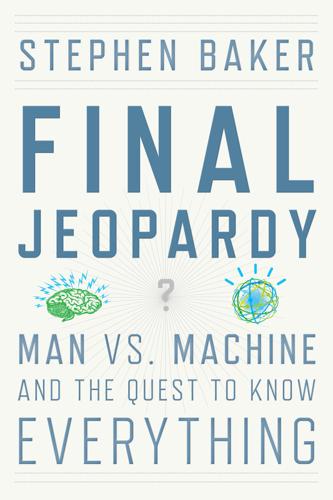
Final Jeopardy: Man vs. Machine and the Quest to Know Everything
by
Stephen Baker
Published 17 Feb 2011
As soon as his shows had aired in mid-September (and he was free to discuss his victories), he e-mailed Ferrucci, asking for a chance to IBM and spar with Watson. Ferrucci’s response, while cordial, was noncommittal. Jeopardy, not IBM, was in charge of selecting Watson’s sparring partners. Before going on Jeopardy, Craig had long relied on traditional strategies. He’d read books on the game, including the 1998 How to Get on Jeopardy—And Win, by Michael DuPee. He’d also gone to Google Scholar, the search engine’s repository of academic works, and downloaded papers on Final Jeopardy betting. Craig was steeped in the history and lore of the games, as well as various strategies, many of them named for players who had made them famous.
…
But this, it turned out, wasn’t a bad thing at all. Ratings soared. Jeopardy had hatched its first celebrity. His name was Ken Jennings. Nothing about the man suggested quiz show dominance. Unlike basketball, where a phenom like LeBron James emerged in high school, amid monster dunks, as the Next Big Thing, a Jeopardy champion like Jennings could surprise even himself. A computer programmer from Salt Lake City, Jennings had competed in quiz bowl events during high school and college. A turn on Jeopardy would be a kick. So in the summer of 2003, he and a friend drove from Salt Lake City to the Jeopardy studios in Culver City and took the qualifying exam.
…
And for her love, support, and help in maintaining a sense of balance, I give thanks to my wife, Jalaire. She’d see the forty Jeopardy shows stored on TiVo and say, “Let’s watch something else.” Notes [>] It was a September morning: Like Yahoo! and a handful of other businesses, the official name of the quiz show in this story ends in an exclamation point: Jeopardy! Initially, I tried using that spelling, but I thought it made reading harder. People see a word like this! and they think it ends a sentence. Since I use the name Jeopardy more than two hundred times in the book, I decided to eliminate that distraction. My apologies to the Jeopardy! faithful, many of whom are sticklers for this kind of detail. [>] pressing the button: A few months before the final match, I was talking to the Jeopardy champion Ken Jennings in Los Angeles.
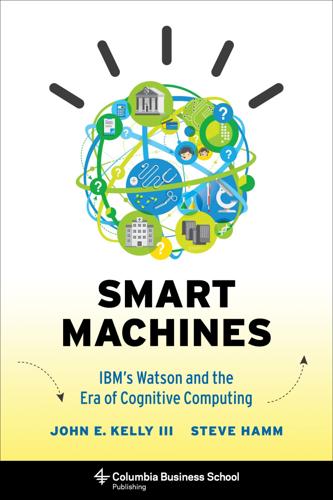
Smart Machines: IBM's Watson and the Era of Cognitive Computing (Columbia Business School Publishing)
by
John E. Kelly Iii
Published 23 Sep 2013
And, just as importantly, we hope to inspire university and high school students to pursue careers in science, technology, engineering, and mathematics. Together, we can drive the exploration and invention that will shape society, the economy, and business for the next fifty years. 1 A NEW ERA OF COMPUTING IBM’s Watson computer created a sensation when it bested two past grand champions on the TV quiz show Jeopardy! Tens of millions of people suddenly understood how “smart” a computer could be. This was no mere parlor trick; the scientists who designed Watson built upon decades of research in the fields of artificial intelligence and natural-language processing and produced a series of breakthroughs.
…
We depend on them to produce the surprising advances that knock the world off kilter and, ultimately, have the potential to make it a better place. We will need many of them to make the transition to the era of cognitive systems. In the end, this era is not about machines but about the people who design and use them. 2 BUILDING LEARNING SYSTEMS In November 2009, when IBM’s Watson was under development for its showdown on Jeopardy!, the machine made one laughable mistake after another in test matches. In one particularly funny instance, it was prompted to identify what the “Al” in the company name Alcoa stands for. It fired back, “What is Al Capone?” Everybody in the room cracked up. The machine had confused the first two letters of aluminum with the name of a famous gangster.1 No harm was done.
…
SMART MACHINES SMART MACHINES IBM’s Watson and the Era of Cognitive Computing JOHN E. KELLY III STEVE HAMM Columbia Business School Publishing COLUMBIA UNIVERSITY PRESS Publishers Since 1893 New York Chichester, West Sussex cup.columbia.edu Copyright © 2013 IBM Corporation All rights reserved E-ISBN 978-0-231-53727-8 Library of Congress Cataloging-in-Publication Data Kelly, John E., III (John Edward), 1954– IBM’s Watson and the era of cognitive computing / John E. Kelly III and Steve Hamm. pages cm Includes bibliographical references. ISBN 978-0-231-16856-4 (cloth : alk. paper) — ISBN 978-0-231-53727-8 (e-book) 1.

Thinking Machines: The Inside Story of Artificial Intelligence and Our Race to Build the Future
by
Luke Dormehl
Published 10 Aug 2016
In this case, it’s one that has never tasted a single morsel of food. This culinary prodigy, in fact, has no taste buds, no nose, nor any sensual experience of food or drink.’ Perhaps surprisingly, Chef Watson is the project IBM settled on after Watson beat Ken Jennings at Jeopardy! As it became evident that Watson was capable of parsing the complex question-as-answer conundrums of Jeopardy! in a way that could defeat even the most skilled of humans, employees at IBM Research decided the next logical challenge was to go beyond answers and develop a system capable of being creative. The suggestions rolled in – covering bases like art, literature and music.
…
But Rob High and the other IBM employees I spoke to were keen to stress that Chef Watson isn’t the end goal for IBM’s Artificial Intelligence. Like getting one of the world’s most powerful AIs to compete on a game show, at its root, Chef Watson is a metaphor – a proof of concept to show off the way Watson can use its enormous database of natural-language knowledge to work in a variety of areas. Creativity isn’t just about preparing new dishes, but coming up with ways to aid humans across industries. For instance, one area IBM is working in is medicine, with Watson helping oncologists choose more personalised, creative paths for curing cancer. Another area is the legal profession, with Watson helping to find case law, which may help shape more creative arguments on the part of lawyers.
…
And all the time Jennings kept winning, smashing every previous record in Jeopardy! history. From being a no-name software engineer from Salt Lake City, suddenly he had a Hollywood agent and a book deal. One day Jennings’ agent phoned to say he had received offers to appear on both Sesame Street and The Tonight Show. ‘It was all totally surreal,’ Jennings says. ‘It had never happened in my lifetime that Americans cared so much about who was on a quiz show.’ Jennings’ streak eventually came to an end following a record seventy-four consecutive shows. He was sad to lose, but Jeopardy! had done him wonders. He was smart, he was in-demand, and – thanks to his winnings – he was rich.

Artificial Intelligence: A Guide for Thinking Humans
by
Melanie Mitchell
Published 14 Oct 2019
Everyone in the restaurant was focused on a television showing an episode of Jeopardy! in which the mega-champion Ken Jennings was competing. This gave Lickel the idea that IBM should develop a computer program that could play Jeopardy! well enough to win against human champions. IBM could then showcase the program in a highly publicized televised tournament.5 This idea helped give rise to a many-year effort, led by natural-language researcher David Ferrucci, which resulted in Watson, an AI system named after IBM’s first chairman, Thomas J. Watson. Jeopardy! is a hugely popular TV game show that first aired in 1964. The game features three contestants, who take turns choosing from a list of categories (for example, “U.S.
…
YouTube started providing impressively accurate automated subtitles for videos, and Skype offered simultaneous translation between languages in video calls. Suddenly Facebook could recognize your face eerily well in uploaded photos, and the photo-sharing website Flickr began automatically labeling photos with text describing their content. In 2011, IBM’s Watson program roundly defeated human champions on television’s Jeopardy! game show, adroitly interpreting pun-laden clues and prompting its challenger Ken Jennings to “welcome our new computer overlords.” Just five years later, millions of internet viewers were introduced to the complex game of Go, a longtime grand challenge for AI, when a program called AlphaGo stunningly defeated one of the world’s best players in four out of five games.
…
While computers can accurately transcribe our requests, the “final frontier,” if you will, is to get them to understand the meaning of our questions. The Story of Watson Prior to Siri, Alexa, and the like, the most famous question-answering program in the AI landscape was IBM’s Watson. You may remember back in 2011, when Watson thrillingly beat two human champions on the game show Jeopardy! Not long after Deep Blue’s 1997 win against the world chess champion Garry Kasparov, executives at IBM were pushing for another high-profile project that, unlike Deep Blue, could actually lead to a useful product for IBM customers. A question-answering system—indeed, inspired in part by the Star Trek computer—perfectly fit the bill.
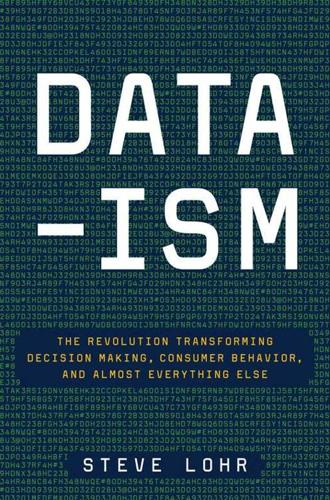
Data-Ism: The Revolution Transforming Decision Making, Consumer Behavior, and Almost Everything Else
by
Steve Lohr
Published 10 Mar 2015
The current debate, Berner adds, revives an old one in economics, pointing to a 1947 article, “Measurement Without Theory,” by Tjalling Koopmans, a Dutch-American economist who later won a Nobel Prize. The Koopmans article was a critique of the hard-line “empiricist” approach to the study of business cycles back then. Few people have wielded the power of data with so dramatic effect as David Ferrucci. He led the IBM research team that created Watson the Jeopardy! winner. That contest ended with Ken Jennings, the all-time champion on the TV quiz show, writing on his video screen, in a gesture of genial surrender, “I, for one, welcome our new computer overlords.” The human face of Watson, to the extent that there was one, was Ferrucci, a goateed computer scientist who was always articulate and at ease in front of a camera or microphone.
…
But in a practical sense, it also means that seemingly quantitative changes become qualitative, opening the door to new possibilities and doing new things. In computing, you start by calculating the flight trajectory of artillery shells, the task assigned the ENIAC (Electronic Numerical Integrator and Computer) in 1946. And by 2011, you have IBM’s Watson beating the best humans in the question-and-answer game Jeopardy! To a computer, it’s all just the 1’s and 0’s of digital code. Yet the massive quantitative improvement in performance over time drastically changes what can be done. Trained physicists in the data world often compare the quantitative-to-qualitative transformation to a “phase change,” or change of state, as when a gas becomes a liquid or a liquid becomes a solid.
…
In early 2014, Rometty announced that its prototype projects with the Watson technology in health care and other industries were sufficiently encouraging to justify creating a new business division. IBM will invest $1 billion in the Watson business and the unit would grow to 2,000 people. Watson has become a “cloud” software service, delivered Google-style over the Internet from remote data centers. IBM is sharing Watson technology with outside software developers and start-ups, so they can write applications that run on top of Watson. IBM has created a $100 million equity fund to jump-start that third-party development by outsiders.

Rise of the Robots: Technology and the Threat of a Jobless Future
by
Martin Ford
Published 4 May 2015
Once again, I was taken by surprise when IBM introduced Deep Blue’s successor, Watson—a machine that took on a far more difficult challenge: the television game show Jeopardy! Chess is a game with rigidly defined rules; it is the sort of thing we might expect a computer to be good at. Jeopardy! is something else entirely: a game that draws on an almost limitless body of knowledge and requires a sophisticated ability to parse language, including even jokes and puns. Watson’s success at Jeopardy! is not only impressive, it is highly practical, and in fact, IBM is already positioning Watson to play a significant role in fields like medicine and customer service.
…
WorkFusion has found that, as the system’s machine learning algorithms incrementally automate the process further, costs typically drop by about 50 percent after one year and still another 25 percent after a second year of operation.13 Cognitive Computing and IBM Watson In the fall of 2004, IBM executive Charles Lickel had dinner with a small team of researchers at a steakhouse near Poughkeepsie, New York. Members of the group were taken aback when, at precisely seven o’clock, people suddenly began standing up from their tables and crowding around a television in the bar area. It turned out that Ken Jennings, who had already won more than fifty straight matches on the TV game show Jeopardy!, was once again attempting to extend his historic winning streak. Lickel noticed that the restaurant’s patrons were so engaged that they abandoned their dinners, returning to finish their steaks only after the match concluded.14 That incident, at least according to many recollections, marked the genesis of the idea to build a computer capable of playing—and beating the very best human champions at—Jeopardy!
…
This incident is recounted in Steven Baker, Final Jeopardy: Man vs. Machine and the Quest to Know Everything (New York: Houghton Mifflin Harcourt, 2011), p. 20. The story of the steakhouse dinner is also told in John E. Kelly III, Smart Machines: IBM’s Watson and the Era of Cognitive Computing (New York: Columbia University Press, 2013), p. 27. However, Baker’s book indicates that some IBM employees believe the idea to build a Jeopardy!-playing computer predates the dinner. 15. Rob High, “The Era of Cognitive Systems: An Inside Look at IBM Watson and How it Works,” IBM Redbooks, 2012, p. 2, http://www.redbooks.ibm.com/redpapers/pdfs/redp4955.pdf. 16.
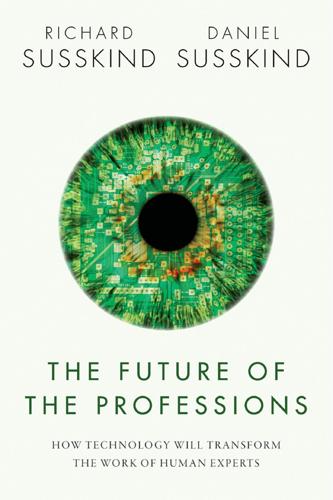
The Future of the Professions: How Technology Will Transform the Work of Human Experts
by
Richard Susskind
and
Daniel Susskind
Published 24 Aug 2015
In the words of Patrick Winston, a leading voice for decades in the world of artificial intelligence, ‘there are lots of ways of being smart that aren't smart like us’.46 IBM’s Watson In the same spirit, IBM’s system Watson, which we regard as a landmark development in artificial intelligence, was not designed to solve problems in the way that human beings do.47 Watson was developed in part to demonstrate that machines could indeed attain exceptional levels of apparently intelligent performance. Named after the founder of IBM, the system was developed to compete on Jeopardy!—a TV quiz show in the United States. This represented IBM’s latest contribution to the branch of AI that in the 1980s was called ‘game-playing’.
…
In section 4.6 we point to a variety of existing techniques and technologies that are already achieving remarkable levels of performance in a wide range of tasks. Perhaps the most dramatic is IBM’s Watson, the computer system that was catapulted to fame by its appearance in 2011 on Jeopardy!, a TV quiz show, on which, in a live broadcast, it beat the two best-ever human contestants (see section 4.6). Much has been said and written about this feat, but nothing perhaps as witty and insightful as a headline in the Wall Street Journal to an opinion piece by the philosopher John Searle. It read: ‘Watson Doesn’t Know It Won on “Jeopardy!”2 We could add that Watson, after its great triumph, had no apparent inclination to laugh or cry, to go for a celebratory drink, to share the moment with a close friend, to chat about what it felt like, or to commiserate with its vanquished opponents.
…
In contemplating the potential of future machines to outperform human beings, what really matters is not how the systems operate but whether, in terms of the outcome, the end product is superior. In other words, whether machines will replace human professionals is not about the capacity of systems to perform tasks as people do. It is about whether systems can outperform human beings—full stop. And so, when IBM’s Watson beat the best-ever human champions on a TV quiz show, what mattered was not whether Watson had cognitive states in common with its flesh-and-blood opponents, but whether its score was higher. To be more precise, then, the fundamental question to be asked and answered is whether machines and systems can undertake tasks that for human beings require cognitive, affective, manual, and moral capabilities, even if they discharge these tasks by quite different means.

The Second Machine Age: Work, Progress, and Prosperity in a Time of Brilliant Technologies
by
Erik Brynjolfsson
and
Andrew McAfee
Published 20 Jan 2014
In an initial trial, approximately 90 percent of GeoFluent users reported that it was good enough for business purposes.14 Human Superiority in Jeopardy! Computers are now combining pattern matching with complex communication to quite literally beat people at their own games. In 2011, the February 14 and 15 episodes of the TV game show Jeopardy! included a contestant that was not a human being. It was a supercomputer called Watson, developed by IBM specifically to play the game (and named in honor of legendary IBM CEO Thomas Watson, Sr.). Jeopardy! debuted in 1964 and in 2012 was the fifth most popular syndicated TV program in America.15 On a typical day almost 7 million people watch host Alex Trebek ask trivia questions on various topics as contestants vie to be the first to answer them correctly.* The show’s longevity and popularity stem from its being easy to understand yet extremely hard to play well.
…
In other words, we believe that employers now and for some time to come will, when looking for talent, follow the advice attributed to the Enlightenment sage Voltaire: “Judge a man by his questions, not his answers.”6 Ideation, creativity, and innovation are often described as ‘thinking outside the box,’ and this characterization indicates another large and reasonably sustainable advantage of human over digital labor. Computers and robots remain lousy at doing anything outside the frame of their programming. Watson, for example, is an amazing Jeopardy! player, but would be defeated by a child at Wheel of Fortune, The Price is Right, or any other TV game show unless it was substantially reprogrammed by its human creators. Watson is not going to get there on its own. Instead of conquering other game shows, however, the IBM team behind Watson is turning its attention to other fields such as medicine. Here again, it will be limited by its frame. Make no mistake: we believe that Watson will ultimately make an excellent doctor.
…
title=Blogger_(service)&oldid=560541931 (accessed June 27, 2013). 8. “Top Sites,” Alexa: The Web Information Company, http://www.alexa.com/topsites (accessed September 8, 2012). 9. “IBM Watson Vanquishes Human Jeopardy Foes,” PCWorld, February 16, 2011, http://www.pcworld.com/article/219893/ibm_watson_vanquishes_human_jeopardy_foes.html. 10. “IBM’s Watson Memorized the Entire ‘Urban Dictionary,’ Then His Overlords Had to Delete It,” The Atlantic, January 10, 2013, http://www.theatlantic.com/technology/archive/2013/01/ibms-watson-memorized-the-entire-urban-dictionary-then-his-overlords-had-to-delete-it/267047/. 11. Kevin J. O’Brien, “Talk to Me, One Machine Said to the Other,” New York Times, July 29, 2012, http://www.nytimes.com/2012/07/30/technology/talk-to-me-one-machine-said-to-the-other.html. 12.
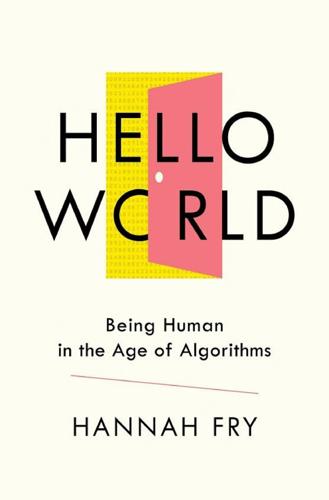
Hello World: Being Human in the Age of Algorithms
by
Hannah Fry
Published 17 Sep 2018
In my view, the best algorithms are the ones that take the human into account at every stage. The ones that recognize our habit of over-trusting the output of a machine, while embracing their own flaws and wearing their uncertainty proudly front and centre. This was one of the best features of the IBM Watson Jeopardy!-winning machine. While the format of the quiz show meant it had to commit to a single answer, the algorithm also presented a series of alternatives it had considered in the process, along with a score indicating how confident it was in each being correct. Perhaps if likelihood of recidivism scores included something similar, judges might find it easier to question the information the algorithm was offering.
…
One that offers an accurate diagnosis and perfectly tailored treatment plan? In short, how about something a little like IBM’s Watson? Elementary, my dear In 2004, Charles Lickel was tucking into a steak dinner with some colleagues in a New York restaurant. Partway through the meal, the dining area began to empty. Intrigued, Charles followed the crowd of diners and found them huddled around a television, eagerly watching the popular game show Jeopardy!. The famous Jeopardy! champion Ken Jennings had a chance to hold on to his record-breaking six-month winning streak and the diners didn’t want to miss it.34 Charles Lickel was the vice-president of software at IBM.
…
Taylor Kubota, ‘Deep learning algorithm does as well as dermatologists in identifying skin cancer’, Stanford News, 25 Jan. 2017, https://news.stanford.edu/2017/01/25/artificial-intelligence-used-identify-skin-cancer/. 34. Jo Best, ‘IBM Watson: the inside story of how the Jeopardy-winning supercomputer was born, and what it wants to do next’, Tech Republic, n.d., https://www.techrepublic.com/article/ibm-watson-the-inside-story-of-how-the-jeopardy-winning-supercomputer-was-born-and-what-it-wants-to-do-next/. 35. Jennings Brown, ‘Why everyone is hating on IBM Watson, including the people who helped make it’, Gizmodo, 14 Aug. 2017, https://www.gizmodo.com.au/2017/08/why-everyone-is-hating-on-watsonincluding-the-people-who-helped-make-it/. 36. https://www.theregister.co.uk/2017/02/20/watson_cancerbusting_trial_on_hold_after_damning_audit_report/ 37.
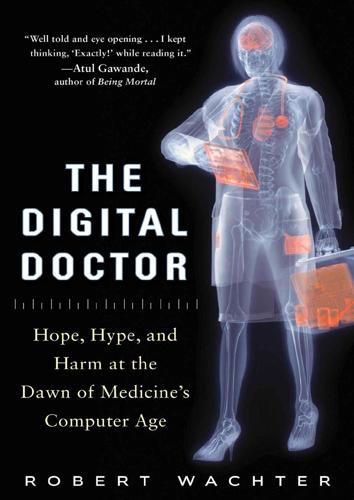
The Digital Doctor: Hope, Hype, and Harm at the Dawn of Medicine’s Computer Age
by
Robert Wachter
Published 7 Apr 2015
If the driverless car weren’t enough of a challenge to human superiority, who could have watched IBM’s Watson supercomputer defeat the Jeopardy Hall of Famers in 2011 and not fretted about the future of physicians, or any highly skilled workers, for that matter? “Just as factory jobs were eliminated in the twentieth century by new assemblyline robots,” wrote all-time (human) Jeopardy champion Ken Jennings soon after the lopsided match ended, “Brad [Rutter, the other defeated champ] and I were the first knowledge-industry workers put out of work by the new generation of ‘thinking’ machines. ‘Quiz show contestant’ may be the first job made redundant by Watson, but I’m sure it won’t be the last.”
…
Chapter 10 David and Goliath There is a science in what we do, yes, but also habit, intuition, and sometimes plain old guessing. —Atul Gawande, Complications: A Surgeon’s Notes on an Imperfect Science When IBM announced that Watson’s first post-Jeopardy focus would be healthcare, the media immediately ran with the Man Versus Machine meme, dubbing the computer “Dr. Watson.” “Meet Dr. Watson: Jeopardy Winning Supercomputer Heads into Healthcare,” proclaimed one headline. “Paging Dr. Watson: IBM’s Medical Advisor for the Future,” read another. IBMers immediately steered clear of the “Dr. Watson” narrative, with its implied cockiness and gauntlet throwing.
…
,” Artificial Intelligence in Medicine 5:93–106 (1993). 102 He calls today’s medical IT programs “Version 0” Khosla, “20-Percent Doctor Included.” 103 These cases illustrate a perennial debate in AI See, for example, M. van Emden, “Scruffies and Neats in Artificial Intelligence: A Programmer’s Place,” September 11, 2011, available at http://vanemden.wordpress.com/2011/09/11/scruffies-and-neats-inartificial-intelligence/. 103 When he was asked about the difference between human thinking E. Brown, “IBM’s ‘Watson’ in Layman’s Terms by Dr. Eric W. Brown,” available at https://www.youtube.com/watch?v=gRVjFhEnLRQ. Chapter 10: David and Goliath 105 “There is a science in what we do” A. Gawande, Complications: A Surgeon’s Notes on an Imperfect Science (New York: Metropolitan Books, 2002). 105 dubbing the computer “Dr. Watson” The “Meet Dr. Watson” headline is from S. Kliff, “Meet Dr. Watson: ‘Jeopardy’-Winning Super Computer Heads into Health Care,” Washington Post, September 12, 2011; the “Paging Dr.
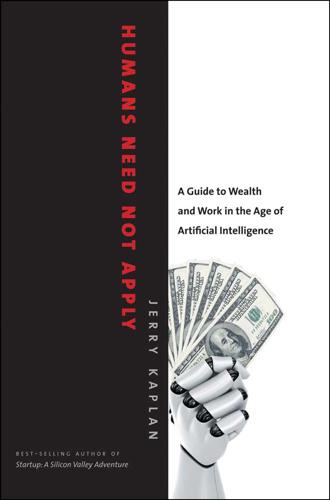
Humans Need Not Apply: A Guide to Wealth and Work in the Age of Artificial Intelligence
by
Jerry Kaplan
Published 3 Aug 2015
Ronda Hauben, “From the ARPANET to the Internet,” last modified June 23, 1998, http://www.columbia.edu/~rh120/other/tcpdigest_paper.txt. 11. For the proverbially impaired, here’s the original: “Give a man a fish and you feed him for a day; teach a man to fish and you feed him for a lifetime.” 12. Joab Jackson, “IBM Watson Vanquishes Human Jeopardy Foes,” PC World, February 16, 2011, http://www.pcworld.com/article/219893/ibm_watson_vanquishes_human_jeopardy_foes.html. 2. TEACHING ROBOTS TO HEEL 1. For a firsthand narrative of some of these events by the inventor himself, see Vic Scheinman’s interview at Robotics History: Narratives and Networks, accessed November 25, 2014, http://roboticshistory.indiana.edu/content/vic-scheinman. 2.
…
I’m happy to report that IBM long ago came around to accepting the potential of AI and to recognizing its value to its corporate mission. In 2011, the company demonstrated its in-house expertise with a spectacular victory over the world’s champion Jeopardy! player, Ken Jennings. IBM is now parlaying this victory into a broad research agenda and has, characteristically, coined its own term for the effort: cognitive computing. Indeed, it is reorganizing the entire company around this initiative. It’s worth noting that IBM’s program, named Watson, had access to 200 million pages of content consuming four terabytes of memory.12 As of this writing, three years later, you can purchase four terabytes of disk storage from Amazon for about $150.
…
For me, the practice of medicine today conjures the image of a Hieronymus Bosch painting, with tiny, pitchfork-wielding devils inflicting their own unique forms of pain. As a patient, you would ideally prefer to be treated by a superdoc who is expert in all the specialties and is up to date on all of the latest medical information and best practices. But of course no such human exists. Enter IBM’s Watson program. Fresh off its Jeopardy! victory over champions Brad Rutter and Ken Jennings, Watson was immediately redeployed to tackle this new challenge. In 2011, IBM and WellPoint, the nation’s largest healthcare benefits manager, entered into a collaboration to apply Watson technology to help improve patient care.
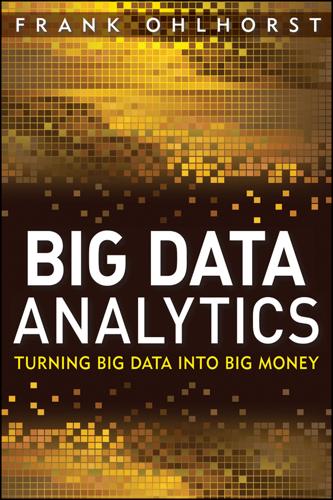
Big Data Analytics: Turning Big Data Into Big Money
by
Frank J. Ohlhorst
Published 28 Nov 2012
Beyond tomorrow probably holds surprises that no one has even imagined yet. As technology marches ahead, so will the usefulness of Big Data. A case in point is IBM’s Watson, an artificial intelligence computer system capable of answering questions posed in natural language. In 2011, as a test of its abilities, Watson competed on the quiz show Jeopardy!, in the show’s only human-versus-machine match to date. In a two-game, combined-point match, broadcast in three episodes aired February 14–16, Watson beat Brad Rutter, the biggest all-time money winner on Jeopardy!, and Ken Jennings, the record holder for the longest championship streak (74 wins). Watson had access to 200 million pages of structured and unstructured content consuming four terabytes of disk storage, including the full text of Wikipedia, but was not connected to the Internet during the game.
…
Watson demonstrated that there are new ways to deal with Big Data and new ways to measure results, perhaps exemplifying where Big Data may be headed. So what’s next for Watson? IBM has stated publicly that Watson was a client-driven initiative, and the company intends to push Watson in directions that best serve customer needs. IBM is now working with financial giant Citi to explore how the Watson technology could improve and simplify the banking experience. Watson’s applicability doesn’t end with banking, however; IBM has also teamed up with health insurer WellPoint to turn Watson into a machine that can support the doctors of the world. According to IBM, Watson is best suited for use cases involving critical decision making based on large volumes of unstructured data.
…
Furthering the value proposition of Watson and Big Data, IBM has also stated that five new research documents come out of Wall Street every minute, and medical information is doubling every five years. IBM views the future of Big Data a little differently than other vendors do, most likely based on its Watson research. In IBM’s future, Watson becomes a service—as IBM calls it, Watson-as-a-Service—which will be delivered as a private or hybrid cloud service. Watson aside, the health care industry seems ripe as a source of prediction for how Big Data will evolve. Examples abound for the benefits of Big Data and the medical field; however, getting there is another story altogether.

Machine, Platform, Crowd: Harnessing Our Digital Future
by
Andrew McAfee
and
Erik Brynjolfsson
Published 26 Jun 2017
It’s the time when science fiction technologies—the stuff of movies, books, and the controlled environments of elite research labs—started to appear in the real world. In 2010, Google unexpectedly announced that a fleet of completely autonomous cars had been driving on US roads without mishap. In 2011, IBM’s Watson supercomputer beat two human champions at the TV quiz show Jeopardy! By the third quarter of 2012, there were more than a billion users of smartphones, devices that combined the communication and sensor capabilities of countless sci-fi films. And of course, the three advances described at the start of this chapter happened in the past few years.
…
§ Fast Company journalist Mark Wilson loved the “Bengali Butternut” barbecue sauce that Watson came up with (Mark Wilson, “I Tasted BBQ Sauce Made by IBM’s Watson, and Loved It,” Fast Company, May 23, 2014, https://www.fastcodesign.com/3027687/i-tasted-bbq-sauce-made-by-ibms-watson-and-loved-it), but called its “Austrian Chocolate Burrito” the worst he’d ever had (Mark Wilson, “IBM’s Watson Designed the Worst Burrito I’ve Ever Had,” Fast Company, April 20, 2015, https://www.fastcodesign.com/3045147/ibms-watson-designed-the-worst-burrito-ive-ever-had). ¶ A mechanical fillet is a smooth transition from one area of a part to another—for example, a rounded corner between two surfaces that meet at a right angle
…
However, the process of eliciting knowledge in interviews would consume a lot of time, would take people away from their job, and probably wouldn’t work very well. The people doing the less routine back-office work are, in all likelihood, not able to accurately and completely tell someone else how to do their job. The Japanese insurer Fukoku Mutual Life is taking a different approach. In December of 2016, it announced an effort to use IBM’s Watson AI technology to at least partially automate the work of human health insurance claim processors. The system will begin by extracting relevant information from documents supplied by hospitals and other health providers, using it to fill in the proper codes for insurance reimbursement, then presenting this information to people.
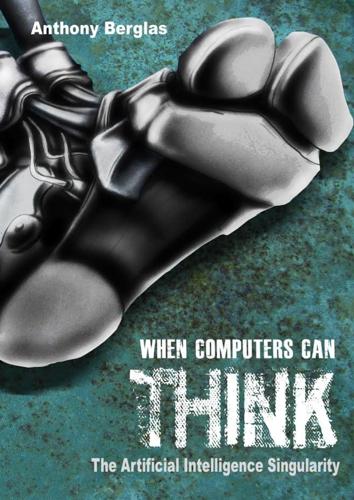
When Computers Can Think: The Artificial Intelligence Singularity
by
Anthony Berglas
,
William Black
,
Samantha Thalind
,
Max Scratchmann
and
Michelle Estes
Published 28 Feb 2015
Today chess programs running on ordinary personal computers are essentially unbeatable. Chess will be discussed in detail later in the book, but in many ways it presents a constrained mathematical problem that is amenable to automated computation. A far more impressive result is the victory of IBM’s Watson program on the Jeopardy! game show. Jeopardy! set, showing Watson’s guesses. Fair Use. Wikipedia. Jeopardy! requires contestants to answer questions in natural language that cover a wide range of general knowledge topics. In 2011 Watson competed against two former prize winners and received first prize of $1 million. These is a sample of questions that Watson could answer:Wanted for a 12-year crime spree of eating King Hrothgar’s warriors; officer Beowulf has been assigned the case : Grendel Milorad Cavic almost upset this man’s perfect 2008 Olympics, losing to him by one hundredth of a second : Michael Phelps It’s just a bloody nose!
…
It is a testament to human cognition that people can learn to play these games with such competence. And it is perhaps an even greater testament that a novice looking at the Go ladder above will quickly see the pattern without being told. Watson and Jeopardy! Jeopardy! game with Watson. Fair Use Wikipedia On the 14th February, 2011 the IBM Watson computer won the Jeopardy! game show against two of the previously most successful contestants on the show, Ken Jennings and Brad Rutter. The wide ranging questions were given in unconstrained natural language, and had to be answered in real time according to the rules of the game.
…
The crudest level of understanding is to simply note that the document contains certain words and phrases. This can be used to index documents and so identify which ones might be relevant to some topic. That is exactly what internet search engines do. Systems like IBM’s Watson go much further by partially parsing sentences and interpreting their meaning with reference to a large ontology of phrases and synonyms. That is what enabled it to win the Jeopardy! game show. This technology will become much more advanced over the following decade or two. It will enable search engines to go beyond simply retrieving documents to become active research assistants that can make simple deductions based on large numbers of documents, even though they would not really understand them.
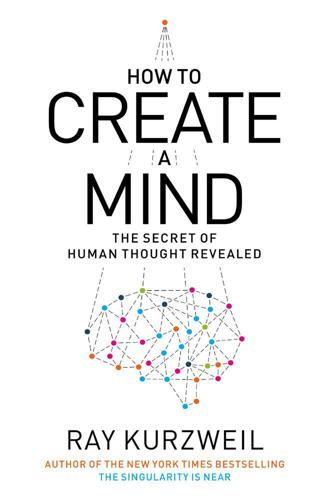
How to Create a Mind: The Secret of Human Thought Revealed
by
Ray Kurzweil
Published 13 Nov 2012
Intelligent algorithms automatically detect credit card fraud, fly and land airplanes, guide intelligent weapons systems, help design products with intelligent computer-aided design, keep track of just-in-time inventory levels, assemble products in robotic factories, and play games such as chess and even the subtle game of Go at master levels. Millions of people witnessed the IBM computer named Watson play the natural-language game of Jeopardy! and obtain a higher score than the best two human players in the world combined. It should be noted that not only did Watson read and “understand” the subtle language in the Jeopardy! query (which includes such phenomena as puns and metaphors), but it obtained the knowledge it needed to come up with a response from understanding hundreds of millions of pages of natural-language documents including Wikipedia and other encyclopedias on its own.
…
As mentioned above, Watson represents a particularly impressive example of the approach of combining hand-coded rules with hierarchical statistical learning. IBM combined a number of leading natural-language programs to create a system that could play the natural-language game of Jeopardy! On February 14–16, 2011, Watson competed with the two leading human players: Brad Rutter, who had won more money than anyone else on the quiz show, and Ken Jennings, who had previously held the Jeopardy! championship for the record time of seventy-five days. By way of context, I had predicted in my first book, The Age of Intelligent Machines, written in the mid-1980s, that a computer would take the world chess championship by 1998.
…
Note that the linear programming that Grötschel cites above as having benefited from an improvement in performance of 43 million to 1 is the mathematical technique that is used to optimally assign resources in a hierarchical memory system such as HHMM that I discussed earlier. I cite many other similar examples like this in The Singularity Is Near.6 Regarding AI, Allen is quick to dismiss IBM’s Watson, an opinion shared by many other critics. Many of these detractors don’t know anything about Watson other than the fact that it is software running on a computer (albeit a parallel one with 720 processor cores). Allen writes that systems such as Watson “remain brittle, their performance boundaries are rigidly set by their internal assumptions and defining algorithms, they cannot generalize, and they frequently give nonsensical answers outside of their specific areas.”
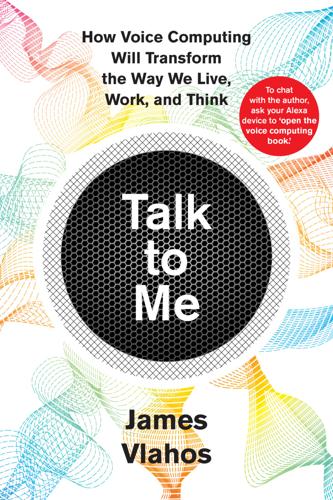
Talk to Me: How Voice Computing Will Transform the Way We Live, Work, and Think
by
James Vlahos
Published 1 Mar 2019
What’s more, many types of information—populations, sporting statistics, celebrity news, emerging technologies—are moving targets, which means that ontologies quickly become dated. So many researchers are trying to move beyond knowledge graphs. They instead deploy systems that hunt for answers in sources of unstructured data: web pages, scanned documents, and digitized books. IBM’s Watson program, which could access 200 million pages of content, famously demonstrated this approach in 2011 when it bested two human competitors to win at the television quiz show Jeopardy! Watson’s success stemmed from clever programming and computational brute force. To bolster its confidence that it was coming up with the right answer, the system sought confirmation from multiple sources.
…
In 2017 the Saatchi & Saatchi LA agency was tasked with creating a campaign for the Toyota Mirai, a futuristic vehicle powered by hydrogen fuel cells. The agency enlisted the help of Watson, IBM’s supercomputer. Human copywriters sketched out fifty different scripts that touted various features of the car. IBM then trained Watson on these scripts so it could churn out thousands of short pieces of copy on its own. Toyota then used many of them as taglines that ran with short videos posted to Facebook. The Watson-crafted zingers included “Yes, it’s for fans of possibility,” “Yes, the future is available now,” and “Yes, it will turn heads on the moon.”
…
, Branded3, April 24, 2017, https://goo.gl/FEabdG. 204 Typed queries are typically one to three words: “The Humanization of Search,” Microsoft report, 2016, https://goo.gl/SDmGgL. 205 For instance, at the time of Freebase’s acquisition: Xin Luna Dong et al., “Knowledge Vault: A Web-Scale Approach to Probabilistic Knowledge Fusion,” Proceedings of the 20th ACM SIGKDD International Conference on Knowledge Discovery and Data Mining (August 24, 2014): 601–10, https://goo.gl/JYEYUB. 205 IBM’s Watson program: David Ferrucci et al., “Building Watson: An Overview of the DeepQA Project,” AI Magazine 31, no. 3 (Fall 2010), https://goo.gl/RVopVR. 206 Both companies had scored as well as the average human: Allison Linn, “Microsoft creates AI that can read a document and answer questions about it as well as a person,” The AI Blog, January 15, 2018, https://goo.gl/tBKHTu. 206 A much more difficult: Danqi Chen et al., “Reading Wikipedia to Answer Open-Domain Questions,” arXiv:1704.00051v2, March 31, 2017, https://goo.gl/uudGiA. 206 In July 2015 Google was serving up instant answers: Eric Enge, “Featured Snippets: New Insights, New Opportunities,” Stone Temple, May 24, 2017, https://goo.gl/sviB0b. 207 The internet is being upended: discussion in this section additionally informed by author interviews with Adam Marchick, the cofounder and CEO of Alpine.AI, May 21, 2018; James McQuivey, principal analyst, Forrester Research, May 30, 2018; and Greg Hedges, former vice president for emerging experiences, Rain, July 11, 2018. 207 “A searcher’s everyday quest”: Christi Olson, “A brief evolution of Search: out of the search box and into our lives,” Marketing Land, June 27, 2016, https://goo.gl/5kwWZr. 207 For instance, of the $110.9 billion: “Google’s ad revenue from 2001 to 2017,” chart posted on Statista, 2018, https://goo.gl/ncu7da. 207 In 2018 Google and Facebook: Daniel Liberto, “Facebook, Google Digital Ad Market Share Drops as Amazon Climbs,” Investopedia, March 20, 2018, https://goo.gl/LB4nc1. 208 “Start thinking about the types of questions you get”: Sherry Bonelli, “How to optimize for voice search,” Search Engine Land, May 1, 2017, https://goo.gl/B5DpPy. 209 “There’s going to be a battle for shelf space”: Christopher Heine, “Here’s What You Need to Know About Voice AI, the Next Frontier of Brand Marketing,” Adweek, August 6, 2017, https://goo.gl/HdGVcM. 209 In 2017 the market research firm L2: Marty Swant, “Alexa Is More Likely to Recommend Amazon Prime Products, According to New Research,” Adweek, July 7, 2017, https://goo.gl/RbQ77p. 210 They click through from Google search results: Nic Newman, “Digital News Project 2018: Journalism, Media, and Technology Trends and Predictions 2018,” published by the Reuters Institute, 2018, https://is.gd/QYI3po. 210 In one of them, Slovakia: Alexis Madrigal, “When the Facebook Traffic Goes Away,” The Atlantic, October 24, 2017, https://goo.gl/A3Xk4s. 211 “They have billions of dollars in profit every year”: Brian Warner, email to author, August 5, 2018. 211 In a 2018 blog post: Danny Sullivan, “A reintroduction to Google’s featured snippets,” The Keyword, January 30, 2018, https://goo.gl/Kqdmsh. 211 “As websites, we expect to compete”: Asher Elran, “Should You Change Your SEO Strategy Because of Google Hummingbird?”
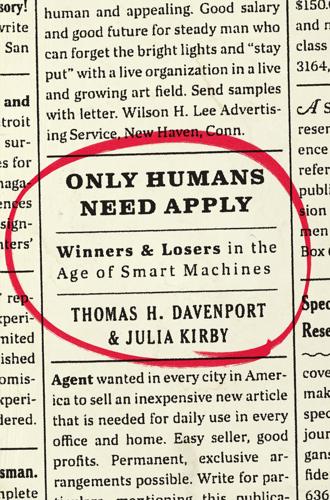
Only Humans Need Apply: Winners and Losers in the Age of Smart Machines
by
Thomas H. Davenport
and
Julia Kirby
Published 23 May 2016
But with that strong caveat noted, it’s important to keep feeding the knowledge base that will help you make connections between problems your organization has and the solutions that are out there. For example, it’s been a very recent development that computers have learned to read and make inferences from fast, vast digestion of textual content. If you weren’t part of the AI community, you might have first learned of this when IBM’s Watson won Jeopardy! To come up with each response, Watson (specifically its “Discovery Advisor”) read whole encyclopedias and untold Internet pages. How could you use that power? At the Baylor College of Medicine in Dallas, they used it to read through more than 70,000 scientific articles, looking for accounts of any protein that could modify p53, a protein that regulates cancer growth.
…
Doris Day and Melafind, 137–38 insurance underwriting in, 83–84 jobs at risk of automation, 19 medical researchers, 181–82 radiology, 16–18, 19, 24, 25, 41, 166 robotic surgery, 40, 51 Stepping Narrowly in, 157 therapy and robots, 123–24 Watson and cancer research, 46, 53–54 Henry, John, 1, 9, 29 Hernandez, Nelson, 75 Herrell, Shane, 104, 132, 140–42, 146 Holland, 241–42 Holmes, Kimberly, 131 Hoover, Dave, 170 HOPE (Hands On Preservation Experience), 240 Hopkins, Gerard Manley, 36 Houtermans, Fritz, 170 Howe, Michael, 163 “How Schools Kill Creativity” (Robinson), 115 Humana, 83–84 humaniqueness, 112 Humans Are Underrated (Colvin), 127, 244 Humans Need Not Apply (Kaplan), 240, 250 Human Use of Human Beings, The (Wiener), 26, 64 humor, 30, 111, 117, 124–25, 129 Joke Analysis and Production Engine (JAPE), 125 Hyperco, 154 IBM, 194, 203 “Bluemix” cognitive cloud, 45 hiring plans by, 176–77 IBM Watson, 20, 44, 55, 72, 92 Baylor College of Medicine use, 212 broadening applications of, 194 components of, 45 confidence bar, 55, 193 customizing of, 187, 188 gastronomy function, 122–23, 128 hiring related to, 176–77, 178 IP Australia applications, 250 Jeopardy! challenge, 44, 55, 212 “learning” by, 53 marketing of, 44, 155 MD Anderson Cancer Center use, 53, 155, 209–10 Memorial Sloan Kettering Cancer Center use, 46, 209, 215 natural language processing, 34, 44, 212 in other robotic brains, 56 as physician advisor, 15 “Q&A” capability, 45, 218 Watson Health, 176, 209, 215 ideation, 27, 28 i4j (Innovation for Jobs), 248 Industrial Revolution, 228, 230–31, 233 innovation, 5, 27, 84, 170, 179, 228, 229, 246, 247 augmentation and, 206, 251 technology-based, 96, 98, 203, 215, 216 In-Q-Tel, 186 insurance industry adding new sources of data, 197 augmentation in, 203–4 automated actuaries, 128 automated processing of claims (“auto- adjudication”), 48 computerized technologies, 21–22 example, Mike Krans, 134–35 Stepping In to automation, 102–3 transparency of automated systems, 192–93 underwriting augmented, 77–84, 218–19 underwriting automated, 94, 103–4, 105, 136, 139–40, 192–93 interior designers, 111 Internet achieving mastery of a specialty, 165 devices connected to, 43 Engelbart and, 64 niche markets and specialties, 161–62 Pew survey, 226 Internet of Things, 43, 80, 213 Interstellar (film), 125 Intuitive Surgical, 40 IP Australia, 250 IPsoft, 44, 45, 183–85, 195, 216, 217 “Amelia,” 44–45, 183–85, 217 Ito, Joi, 235, 247 Jabil Circuit, 50 Jackson Lewis P.C., 142 Japan, 24, 160, 247 Jobs, Steve, 63–64, 112, 158, 159 Jokes Every Man Should Know (Steinberg), 124–25 journalism, 22, 95–98, 103, 104, 121 Kabbage, 197 Kahneman, Daniel, 236 Kaplan, Jerry, 240, 250 Kay, Alan, 164 Kechley, Aaron, 193, 195–96 Kelley, Kevin, 139–40 Kensho Technologies, 20 Kessler, Andy, 84 Key, Ed, 122 Keynes, John Maynard, 69, 238 Khan Academy, 141 KIGEN, 59 Killinger, Kerry, 90 Kim, Kyung-Hee, 115 Kitaura, Francisco, 59 KMG International, 217 Knewton, 20 knowledge workers, 5, 6, 8, 29–30, 66, 74, 84, 97, 115, 204, 217, 233.
…
Using machines will deepen the empathy, or heighten the creativity, or refine the taste that people bring to the table. A good example is the new capability of IBM’s Watson to find novel combinations of food ingredients that add up to palatable dishes. Chefs, of course, are very creative people—and computers don’t even eat. But gastronomy is also, on one level, just chemistry. Lav Varshney, a computer scientist at IBM, explains that Watson entered the world of haute cuisine when a database of already highly rated recipes was fed into it. The next step was, akin to the marketing-message software, to “remix them, substitute things, do all kinds of other modifications and generate millions of new ideas for recipes.”24 But it wouldn’t be feasible to prepare all of those and foist the results onto courageous taste testers.

The Perfect Bet: How Science and Math Are Taking the Luck Out of Gambling
by
Adam Kucharski
Published 23 Feb 2016
CHAPTER 7 165Thanks to their ability to dissect: Background on Watson comes from: Rashid, Fahmida. “IBM’s Watson Ties for Lead on Jeopardy but Makes Some Doozies.” EWeek, February 14, 2011. http://www.eweek.com/c/a/IT-Infrastructure/IBMs-Watson-Ties-for-Lead-on-Jeopardy-but-Makes-Some-Doozies-237890; and Best, Jo. “IBM Watson: How the Jeopardy-Winning Supercomputer Was Born, and What It Wants to Do Next.” TechRepublic. http://www.techrepublic.com/article/ibm-watson-the-inside-story-of-how-the-jeopardy-winning-supercomputer-was-born-and-what-it-wants-to-do-next/. 166IBM collected some of the results: Basulto, Dominic. “How IBM Watson Helped Me to Create a Tastier Burrito Than Chipotle.”
…
Ask the human to perform a calculation, and he’d be much slower, not to mention more error prone, than the computer. Even so, there are still some situations that bots struggle with. When playing Jeopardy! Watson found the short clues the most difficult. If the host read out a single category and a name—such as “first ladies” and Ronald Reagan—Watson would take too long to search through its database to find the correct response (which is “Who is Nancy Reagan?”). Whereas Watson would beat a human contestant in a race to solve a long, complicated clue, the human would prevail if there were only a few words to go by. In quiz shows, it seems that brevity is the enemy of machines. The same is true of poker. Bots need time to study their opponents, learning their betting style so it can be exploited.
…
Once you add opponent modeling to it, it will kill everyone.” 7 THE MODEL OPPONENT WHEN IT CAME TO THE GAME SHOW JEOPARDY! KEN JENNINGS and Brad Rutter were the best. It was 2011, and Rutter had netted the most prize money, while Jennings had gone a record seventy-four appearances without defeat. Thanks to their ability to dissect the show’s famous general knowledge clues, they had won over $5 million between them. On Valentine’s Day that year, Jennings and Rutter returned for a special edition of the show. They would face a new opponent, named Watson, who had never appeared on Jeopardy! before. Over the course of three episodes, Jennings, Rutter, and Watson answered questions on literature, history, music, and sports.
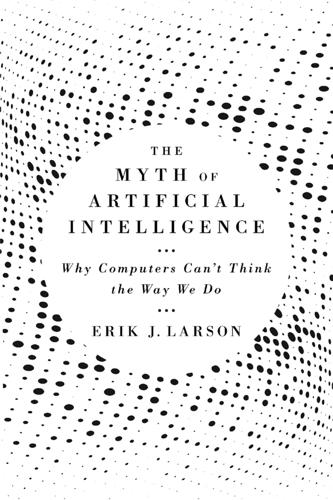
The Myth of Artificial Intelligence: Why Computers Can't Think the Way We Do
by
Erik J. Larson
Published 5 Apr 2021
As luck would have it, one popular game in particular was already in the news: Jeopardy! The television quiz show Jeopardy! is a kind of gamified version of a simplified Turing test (or so it seems). It’s a broad test of knowledge of facts, with the “conversation” reversed so that an answer is given to contestants, who then must conjure the correct question. For example, to the prompt “Developed by IBM, it beat Kasparov at chess,” the correct response would be “What is Deep Blue?” In 2004, Jeopardy! ratings were soaring because of a human, Ken Jennings, the returning world champion who had won a record-breaking seventy-four Jeopardy! contests in a row.
…
TURING’S INTELLIGENCE ERROR AND NARROW AI The problem-solving view of intelligence helps explain the production of invariably narrow applications of AI throughout its history. Game playing, for instance, has been a source of constant inspiration for the development of advanced AI techniques, but games are simplifications of life that reward simplified views of intelligence. A chess program plays chess, but does rather poorly driving a car. IBM’s Watson system plays Jeopardy!, but not chess or Go, and massive programming or “porting” efforts are required to use the Watson platform to perform other data mining and natural language processing functions, as with recent (and largely unsuccessful) forays into health care. Treating intelligence as problem-solving thus gives us narrow applications.
…
DeepQA became an effective feedback loop involving dozens of expert humans gradually fine-tuning the Watson system to play world-class Jeopardy! (Perhaps less appreciated, the resulting system became narrow—a consequence itself of this engineering strategy aimed at game-play specifics.) Inspired by the “society of minds” idea, DeepQA did include innovations in natural language processing (NLP). Older QA systems like PIQUANT relied on processing pipelines that were similar to IBM Watson: first analyze the question, then search and retrieve possible answers, then score the retrieved answers, returning the best. Yet PIQUANT and other earlier-generation systems share a common flaw; they can get locked into incorrect answers by mistakes made in early parts of analysis.
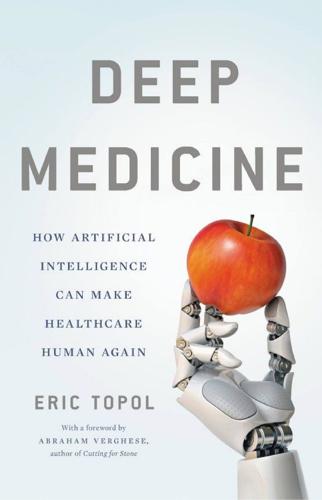
Deep Medicine: How Artificial Intelligence Can Make Healthcare Human Again
by
Eric Topol
Published 1 Jan 2019
Patel, et al., “Enhancing Next-Generation Sequencing-Guided Cancer Care Through Cognitive Computing.” 31. Mukherjee, S., “A.I. Versus M.D.: What Happens When Diagnosis Is Automated?,” New Yorker. 2017. 32. Ross and Swetlitz, “IBM Pitched Its Watson Supercomputer as a Revolution in Cancer Care.” 33. Herper, M., “MD Anderson Benches IBM Watson in Setback for Artificial Intelligence in Medicine,” Forbes. 2017. 34. Ross and Swetlitz, “IBM Pitched Its Watson Supercomputer as a Revolution in Cancer Care.” 35. Muoio, D., “IBM Watson Manager, Academics Describe Challenges, Potential of Health Care AI,” MobiHealthNews. 2017. 36. Harari, Y. N., Homo Deus. 2016. New York: HarperCollins, p. 448. 37.
…
That massive database of 15 million labeled images would help catapult DNN into prominence as a tool for computer vision. In parallel, natural-language processing for speech recognition based on DNN at Microsoft and Google was moving into full swing. More squarely in the public eye was man versus machine in 2011, when IBM Watson beat the human Jeopardy! champions. Despite the relatively primitive AI that was used, which had nothing to do with deep learning networks and which relied on speedy access to Wikipedia’s content, IBM masterfully marketed it as a triumph of AI. The ensuing decade has seen remarkable machine performance. Deep learning got turbocharged in 2012 with the publication of research by Hinton and his University of Toronto colleagues that showed remarkable progress in image recognition at scale.19 Progress in unlabeled image recognition was notable in 2012, when Google Brain’s team, led by Andrew Ng and Jeff Dean, developed a system based on one hundred computers and 10 million images that could recognize cats in YouTube videos.
…
It was a bit comical in 2017 to see IBM Watson’s ads claiming that with the system a doctor could read 5,000 studies a day and still see patients. Neither Watson nor any other AI algorithms can support that, at least not yet. What Watson is actually dealing with are only abstracts, the brief encapsulations that appear at the beginning of most published papers. Even then, these data are unstructured, so there’s no way that simple ingestion of all the text automatically translates into an augmented knowledge base. This might be surprising, given that Watson’s ability to outdo humans in Jeopardy! suggests it would have the ability to outsmart doctors, too, and make quick work of the medical literature.
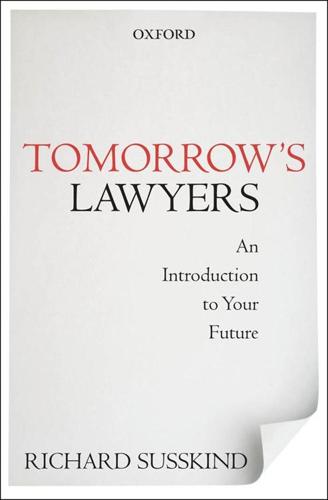
Tomorrow's Lawyers: An Introduction to Your Future
by
Richard Susskind
Published 10 Jan 2013
The disruption here is that crucial legal insights, correlations, and even algorithms might come to play a central role in legal practice and legal risk management and yet they will not be generated through the work of mainstream lawyers (unless they choose to collaborate with big data scientists). AI-Based Problem-Solving If IBM’s Watson (an artificially intelligent computer system designed to compete on the US TV quiz show Jeopardy!) is able publicly to beat the two finest human competitors, then the days of online problem-solving by computer are not very far away. And when we enter that era, and we apply the same techniques and technologies in law, then we will have AI-based legal problem-solving.
…
We need, as lawyers, to be open-minded because we are living in an era of unprecedented technological change. Consider recent progress in artificial intelligence (AI) and, in particular, the achievements of Watson, IBM’s AI-based system that competed—in a live broadcast in 2011—on the US television general knowledge quiz show Jeopardy! Watson beat the show’s two finest ever human contestants. This is a phenomenal technological feat, combining advanced natural language understanding, machine learning, information retrieval, knowledge processing, speech synthesis, and more. While the remarkable Google retrieves information for us that might be relevant, Watson shows how AI-based systems, in years to come, will actually speak with us and solve our problems.
…
This thinking led me in 1996, in my book The Future of Law, to predict a shift in legal paradigm, by which I meant that many or most of our fundamental assumptions about legal service and legal process would be challenged and displaced by IT and the Internet. It was a 20-year prediction, so I can be called fully to account in 2016. I do not think I will be far out—when I look at IBM’s Watson (see Chapter 1) and think of similar technology in law, or reflect on information retrieval systems that are already outperforming human beings engaged in document review, then I feel we are on the brink of a monumental shift. Crucially, I concluded in 1996 that legal service would move from being a one-to-one, consultative, print-based advisory service to a one-to-many, packaged, Internet-based information service.
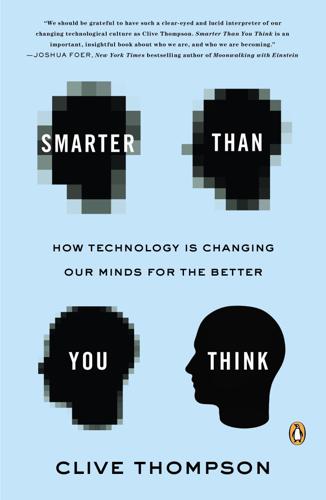
Smarter Than You Think: How Technology Is Changing Our Minds for the Better
by
Clive Thompson
Published 11 Sep 2013
As Cory Doctorow points out: Cory Doctorow, “We Need a Serious Critique of Net Activism,” The Guardian, January 25, 2011, accessed March 26, 2013, www.guardian.co.uk/technology/2011/jan/25/net-activism-delusion. Chapter 10: Epilogue The Jeopardy! clue popped up on the screen: Parts of my writing here on Watson appeared previously in my story “What Is I.B.M.’s Watson?” The New York Times Magazine, June 16, 2010, accessed March 26, 2013, www.nytimes.com/2010/06/20/magazine/20Computer-t.html. Indeed, some clever experiments by Harvard’s Teresa Amabile and others: Teresa M. Amabile, “Brilliant but Cruel: Perceptions of Negative Evaluators,” Journal of Experimental Social Psychology 19, no. 2 (March 1983): 146–56; Bryan Gibson and Elizabeth Oberlander, “Wanting to Appear Smart: Hypercriticism as an Indirect Impression Management Strategy,” Self and Identity 7, no. 4 (2008): 380–92.
…
Amabile, “Brilliant but Cruel: Perceptions of Negative Evaluators,” Journal of Experimental Social Psychology 19, no. 2 (March 1983): 146–56; Bryan Gibson and Elizabeth Oberlander, “Wanting to Appear Smart: Hypercriticism as an Indirect Impression Management Strategy,” Self and Identity 7, no. 4 (2008): 380–92. “the smartest medical student we have ever had”: Joanna Stern, “IBM’s Watson Supercomputer Gets Job as Oncologist at Memorial Sloan-Kettering Cancer Center,” ABC News, March 22, 2012, accessed March 26, 2013, abcnews.go.com/Technology/ibms-watson-supercomputer-job-memorial-sloan-kettering-cancer/story?id=15979580#.UVQxTKt5MhM. A Pew study found that 22 percent of all TV watchers: Aaron Smith and Jan Lauren Boyles, “The Rise of the ‘Connected Viewer’” (Pew Internet & American Life Project, July 17, 2012), 2, accessed March 26, 2013, pewinternet.org/Reports/2012/Connected-viewers.aspx.
…
A Pew study found that 22 percent of all TV watchers: Aaron Smith and Jan Lauren Boyles, “The Rise of the ‘Connected Viewer’” (Pew Internet & American Life Project, July 17, 2012), 2, accessed March 26, 2013, pewinternet.org/Reports/2012/Connected-viewers.aspx. rebuslike short forms of expression: I owe this idea to Crystal’s Txtng, 39. Andy Hickl, an AI inventor: Thompson, “What Is I.B.M.’s Watson?” As one of the commenters at the site explained: “Reader’s Comments: What Is IBM’s Watson?” accessed March 26, 2013, community.nytimes.com/comments/www.nytimes.com/2010/06/20/magazine/20Computer-t.html?sort=recommended. to a 2004 discussion-board thread: “Favorite Movie Quotes,” accessed March 26, 2013, www.clemsontalk.com/vb/archive/index.php/t-2926.html.

Augmented: Life in the Smart Lane
by
Brett King
Published 5 May 2016
You might recall a few years ago that IBM fielded a computer to compete in the game show Jeopardy! against two of its longtime champions. Watson, as the computer is known, won the game show convincingly, defeating the two previously undefeated human challengers Jennings and Rutter.14 More recently, IBM Watson was board approved by the NY Genome Centre to act as a medical diagnostician.15 As far as we are aware, this is the first time a specific machine intelligence (MI) has been certified academically or professionally to practise medicine. It will certainly not be the last time. What was the driver behind the medical certification? The team behind IBM Watson wondered whether Watson could learn to hypothesise on problems like diagnosing cancer or finding genetic markers for hereditary conditions if they gave it the right data.
…
The fact is that human advisers are going to have significant disadvantages competing with their so-called robo-adviser challengers. Here are the most significant disadvantages: The Big Data Theory: AIs Will Analyse much more Data The example used earlier in chapter 3 is that of IBM Watson either competing against humans in the game show Jeopardy! or providing advice to doctors and nurses in the field of cancer research and treatment. Watson has been provided with millions of documents including medical journals, case studies, dictionaries, encyclopedias, literary works, newswire articles and other databases.
…
Horvitz, “Toward enhanced pharmacovigilance using patient-generated data on the Internet,” Journal of Clinical Pharmacology & Therapeutics 96, no. 2 (August 2014): 239–46. 12 “All Things Considered,” NPR Radio, aired 8 April 2015. 13 Slang for “Internet” 14 John Markoff, “Computer wins on ‘Jeopardy!’: Trivial, It’s Not!” New York Times, 16 February 2011, http://www.nytimes.com/2011/02/17/science/17jeopardy-watson.html. 15 Irana Ivanova, “IBM’s Watson joins Genome Center to cure cancer,” Crain’s New York Business, 19 March 2014, http://www.crainsnewyork.com/article/20140319/HEALTH_CARE/140319845/ibmswatson-joins-genome-center-to-cure-cancer. 16 p53 is often called a “tumour suppressor protein structure” because of its role in defending the body against the formation of cancer cells. 17 Ian Steadman, “IBM’s Watson is better at diagnosing cancer than human doctors,” Wired, 11 February 2013, http://www.wired.co.uk/news/archive/2013-02/11/ibm-watson-medical-doctor. 18 “IBM and Partners to Transform Person Health with Watson and Open Cloud,” IBM Press Release, 13 April 2015, https://www-03.ibm.com/press/us/en/pressrelease/46580.wss. 19 Friction here refers to the user workload required to use the software.
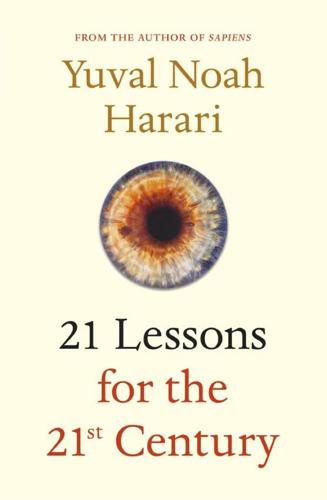
21 Lessons for the 21st Century
by
Yuval Noah Harari
Published 29 Aug 2018
Similarly, human–computer centaur teams are likely to be characterised by a constant tug of war between the humans and the computers, instead of settling down to a lifelong partnership. Teams made exclusively of humans – such as Sherlock Holmes and Dr Watson – usually develop permanent hierarchies and routines that last decades. But a human detective who teams up with IBM’s Watson computer system (which became famous after winning the US TV quiz show Jeopardy! in 2011) will find that every routine is an invitation for disruption, and every hierarchy an invitation for revolution. Yesterday’s sidekick might morph into tomorrow’s superintendent, and all protocols and manuals will have to be rewritten every year.17 A closer look at the world of chess might indicate where things are heading in the long run.
…
.: Arash Bahrammirzaee, ‘A comparative Survey of Artificial Intelligence Applications in Finance: Artificial Neural Networks, Expert System and Hybrid Intelligent Systems’, Neural Computing and Applications 19:8 (2010), 1165–95; analysis of complex data in medical systems and production of diagnosis and treatment: Marjorie Glass Zauderer et al., ‘Piloting IBM Watson Oncology within Memorial Sloan Kettering’s Regional Network’, Journal of Clinical Oncology 32:15 (2014), e17653; creation of original texts in natural language from massive amounts of data: Jean-Sébastien Vayre et al., ‘Communication Mediated through Natural Language Generation in Big Data Environments: The Case of Nomao’, Journal of Computer and Communication 5 (2017), 125–48; facial recognition: Florian Schroff, Dmitry Kalenichenko and James Philbin, ‘FaceNet: A Unified Embedding for Face Recognition and Clustering’, IEEE Conference on Computer Vision and Pattern Recognition (CVPR) (2015), 815–23; and driving: Cristiano Premebida, ‘A Lidar and Vision-based Approach for Pedestrian and Vehicle Detection and Tracking’, 2007 IEEE Intelligent Transportation Systems Conference (2007). 3 Daniel Kahneman, Thinking, Fast and Slow (New York: Farrar, Straus & Giroux, 2011); Dan Ariely, Predictably Irrational (New York: Harper, 2009); Brian D.
…
Spreitzer, Lindsey Cameron and Lyndon Garrett, ‘Alternative Work Arrangements: Two Images of the New World of Work’, Annual Review of Organizational Psychology and Organizational Behavior 4 (2017), 473–99; Sarah A. Donovan, David H. Bradley and Jon O. Shimabukuru, ‘What Does the Gig Economy Mean for Workers?’, Congressional Research Service, Washington DC, 2016; ‘More Workers Are in Alternative Employment Arrangements’, Pew Research Center, 28 September 2016. 17 David Ferrucci et al.,‘Watson: Beyond Jeopardy!’, Artificial Intelligence 199–200 (2013), 93–105. 18 ‘Google’s AlphaZero Destroys Stockfish in 100-Game Match’, Chess.com, 6 December 2017; David Silver et al., ‘Mastering Chess and Shogi by Self-Play with a General Reinforcement Learning Algorithm’, arXiv (2017), https://arxiv.org/pdf/1712.01815.pdf; see also Sarah Knapton, ‘Entire Human Chess Knowledge Learned and Surpassed by DeepMind’s AlphaZero in Four Hours’, Telegraph, 6 December 2017. 19 Cowen, Average is Over, op. cit.; Tyler Cowen, ‘What are humans still good for?

The Creativity Code: How AI Is Learning to Write, Paint and Think
by
Marcus Du Sautoy
Published 7 Mar 2019
If that is true, it will be a real challenge for machine learning to pick up language just by being exposed to a huge database of language use. ‘This is Jeopardy!’ One of the most impressive displays of algorithmic negotiation of the vagaries of natural language came some years ago, a little over ten years after IBM’s super computer DeepBlue successfully took the crown from the reigning chess champion Garry Kasparov. In 2011 IBM turned its attention to a very different sort of competition from chess or Go: it decided to take a shot at the American game show Jeopardy!. Jeopardy! is basically a general-knowledge quiz show. Given that a computer can simply trawl through Wikipedia, that doesn’t seem like much of a test for an algorithm.
…
They are like an algorithmic catwalk allowing a company to show off its coding prowess. IBM Watson has already changed our perception of what computers may do – it beat the best Jeopardy! champions, and it is being used for medical diagnoses. What sets Watson apart? What makes it different? This capability to take into unstructured data is a big strength for Watson. We train it. Additionally just dumping the text in Watson, humans actually form the system to understand what is most important and reliable inside the text. Watson pulled in all of Wikipedia prior to its Jeopardy! appearance, and stored that data offline. Humans can tell Watson to trust one source of info more than another.
…
Jennings had gone seventy-four games in a row unbeaten, while Rutter had earned over four million dollars during his time on the show. Both had cut their teeth on quiz teams at school and university, although Rutter had always been regarded as something of a slacker academically. Jeopardy! generally features three competitors, so the two human champions agreed to take on the algorithm that IBM produced. IBM named its algorithm Watson, not after Sherlock Holmes’s sidekick but the first CEO of the company, Thomas J. Watson. Over two days in January 2011 Rutter and Jennings battled valiantly against Watson and each other. The filming had to be staged at IBM’s research lab in Yorktown Heights in New York State because it was impossible to relocate the computer hardware to a TV studio.

Mastering Structured Data on the Semantic Web: From HTML5 Microdata to Linked Open Data
by
Leslie Sikos
Published 10 Jul 2015
Twitter Card Annotation in the Markup <meta name="twitter:card" content="summary" /> <meta name="twitter:site" content="@lesliesikos" /> <meta name="twitter:creator" content="@lesliesikos" /> <meta property="og:url" content="http://www.lesliesikos.com/linked-data-platform-1-0 standardized/" /> <meta property="og:title" content="Linked Data Platform 1.0 Standardized" /> <meta property="og:description" content="The Linked Data Platform 1.0 is now a W3C Recommendation, covering a set of rules for HTTP operations on Web resources, including RDF-based Linked Data, to provide an architecture for read-write Linked Data on the Semantic Web." /> <meta property="og:image" content="http://www.lesliesikos.com/img/LOD.svg" /> 211 Chapter 8 ■ Big Data Applications IBM Watson IBM Watson’s DeepQA system is a question-answering system originally designed to compete with contestants of the Jeopardy! quiz show, where three contestants compete against one another in answering open-domain questions. While the system famously won the contest against human grand champions, it has applications well beyond Jeopardy!, namely, natural language content analysis in both questions and knowledge sources in general [3]. Watson’s cognitive computing algorithms are used in health care, to provide insight and decision support, and give personalized and instant responses to any inquiry or service issue in customer service.
…
Watson’s cognitive computing algorithms are used in health care, to provide insight and decision support, and give personalized and instant responses to any inquiry or service issue in customer service. Developers can use the IBM Watson Developers Cloud, a collection of REST APIs and SDKs for cognitive computing tasks, such as natural language classification, concept expansion, machine translation, relationship extraction, speech to text, and visual recognition. Among other technologies, Watson uses triplestores such as Sesame, ontologies, and inference. The information resources of DeepQA consist of unstructured, semistructured, and structured data, of which the last one plays an important role, mainly by implementing RDF in IBM’s DB2 database platform [4].
…
Google (2015) Introducing the Knowledge Graph. www.google.co.uk/ insidesearch/features/search/knowledge.html. Accessed 9 March 2015. 2. Twitter (2015) Getting Started with Cards. https://dev.twitter.com/cards/. Accessed 12 March 2015. 3. Gliozzo, A., Patwardhan, S., Biran, O., McKeown, K. (2013) Semantic Technologies in IBM Watson. www.cs.columbia.edu/nlp/papers/2013/ watson_class_acl_tnlp_2013.pdf. Accessed 23 April 2015. 4. Gucer, V. (2013) IBM is embracing Semantic technologies in its products. In: 5 Things To Know About Semantic Technologies. www.ibm.com/developerworks/ community/blogs/5things/entry/5_things_to_know_about_the_semantic_ technologies?

The Glass Cage: Automation and Us
by
Nicholas Carr
Published 28 Sep 2014
But even if we assume, contrary to the extravagant promises of big-data evangelists, that there are limits to the applicability and usefulness of correlation-based predictions and other forms of statistical analysis, it seems clear that computers are a long way from bumping up against those limits. When, in early 2011, the IBM supercomputer Watson took the crown as the reigning champion of Jeopardy!, thrashing two of the quiz show’s top players, we got a preview of where computers’ analytical talents are heading. Watson’s ability to decipher clues was astonishing, but by the standards of contemporary artificial-intelligence programming, the computer was not performing an exceptional feat.
…
Macfarlane, 36–37 Great Britain, 22–23, 35, 157 Great Depression, 25–26, 27, 29, 38 grid cells, 134 Groopman, Jerome, 97–98, 105 Gross, Mark, 167 Gundotra, Vic, 203 gunnery crews, 35–36, 41 guns, 35–38, 41, 185 habit formation, 88–89 Hambrick, David, 83 hands, 143, 144, 145, 216 happiness, 14–16, 137, 203 hardware, 7–8, 52, 118 Harris, Don, 52–53, 63 Hartzband, Pamela, 97–98 Harvard Psychological Laboratory, 87 Hayles, Katherine, 12–13 Health Affairs, 99 Health and Human Services Department, U.S., 94, 95 health care, 33, 173 computers and, 93–106, 113–15, 120, 123, 153–54, 155 costs of, 96, 99 diagnosis in, 10, 12, 70–71, 105, 113–15, 120, 123, 154, 155 see also doctors; hospitals Health Information Technology Adoption Initiative, 93–94 Heidegger, Martin, 148 Hendren, Sara, 130–31 Heyns, Christof, 188–89, 192 hippocampus, 133–37 Hippocrates, 158 history, 124, 127, 159–60, 174, 227 Hoff, Timothy, 100–102 Hoover, Herbert, 26 hospitals, 94–98, 102, 123, 155, 173 How Doctors Think (Groopman), 105 How We Think (Hayles), 13 Hughes, Thomas, 172, 196 human beings: boundaries between computers and, 10–12 change and, 39, 40 killing of, 184 need for, 153–57 robots as replications of, 36 technology-first automation vs., 153–76 Human Condition, The (Arendt), 108, 227–28 humanism, 159–61, 164, 165 Human Use of Human Beings, The (Wiener), 37, 38 Huth, John Edward, 216–17 iBeacon, 136 IBM, 27, 118–20, 195 IBM Systems Journal, 194–95 identity, 205–6 IEX, 171 Illingworth, Leslie, 19, 33 imagination, 25, 121, 124, 142, 143, 215 inattentional blindness, 130 industrial planners, 37 Industrial Revolution, 21, 24, 28, 32, 36, 106, 159, 195 Infiniti, 8 information, 68–74, 76–80, 166 automation complacency and bias and, 68–72 health, 93–106, 113 information overload, 90–92 information underload, 90–91 information workers, 117–18 infrastructure, 195–99 Ingold, Tim, 132 integrated development environments (IDEs), 78 Intel, 203 intelligence, 137, 151 automation of, 118–20 human vs. artificial, 11, 118–20 interdependent networks, 155 internet, 12–13, 33n, 176, 188 internet of things, 195 Introduction to Mathematics, An, (Whitehead), 65 intuition, 105–6, 120 Inuit hunters, 125–27, 131, 217–20 invention, 161, 174, 214 iPads, 136, 153, 203 iPhones, 13, 136 Ironstone Group, 116 “Is Drawing Dead?” (symposium), 144 Jacquard loom, 36 Jainism, 185 Jefferson, Thomas, 160, 222 Jeopardy! (quiz show), 118–19, 121 Jobless Future, The (Aronowitz and DiFazio), 27–28 jobs, 14–17, 27–33, 85, 193 automation’s altering of, 67, 112–20 blue-collar, 28, 109 creating, 31, 32, 33 growth of, 28, 30, 32 loss of, 20, 21, 25, 27, 28, 30, 31, 40, 59, 115–18, 227 middle class, 27, 31, 32, 33n white-collar, 28, 30, 32, 40, 109 Jobs, Steve, 194 Jones, Michael, 132, 136–37, 151 Kasparov, Garry, 12 Katsuyama, Brad, 171 Kay, Rory, 58 Kelly, Kevin, 153, 225, 226 Kennedy, John, 27, 33 Kessler, Andy, 153 Keynes, John Maynard, 26–27, 66, 224, 227 Khosla, Vinod, 153–54 killing, robots and, 184, 185, 187–93 “Kitty Hawk” (Frost), 215 Klein, Gary, 123 Knight Capital Group, 156 know-how, 74, 76, 115, 122–23 knowledge, 74, 76, 77, 79, 80–81, 84, 85, 111, 121, 123, 131, 148, 153, 206, 214, 215 design, 144 explicit (declarative), 9, 10–11, 83 geographic, 128 medicine and, 100, 113, 123 tacit (procedural), 9–11, 83, 105, 113, 144 knowledge workers, 17, 148 Kool, Richard, 228–29 Korzybski, Alfred, 220 Kroft, Steve, 29 Krueger, Alan, 30–31 Krugman, Paul, 32–33 Kurzweil, Ray, 181, 200 labor, 227 abridging of, 23–25, 28–31, 37, 96 costs of, 18, 20, 31, 175 deskilling of, 106–12 division of, 106–7, 165 intellectualization of, 118 in “Mowing,” 211–14 strife, 37, 175 see also jobs; work Labor and Monopoly Capital (Braverman), 109–10 Labor Department, U.S., 66 labor unions, 25, 37, 59 Langewiesche, William, 50–51, 170 language, 82, 121, 150 Latour, Bruno, 204, 208 lawn mowers, robotic, 185 lawyers, law, 12, 116–17, 120, 123, 166 learning, 72–73, 77, 82, 84, 88–90, 175 animal studies and, 88–89 medical, 100–102 Lee, John, 163–64, 166, 169 LeFevre, Judith, 14, 15, 18 leisure, 16, 25, 27, 227 work vs., 14–16, 18 lethal autonomous robots (LARs), 188–93 Levasseur, Émile, 24–25 Leveson, Nancy, 155–56 Levesque, Hector, 121 Levinson, Stephen, 101 Levy, Frank, 9, 10 Lewandowsky, Stephan, 74 Lex Machina, 116–17 Licklider, J.
…
The FAA had collected evidence, from crash investigations, incident reports, and cockpit studies, indicating that pilots had become too dependent on autopilots and other computerized systems. Overuse of flight automation, the agency warned, could “lead to degradation of the pilot’s ability to quickly recover the aircraft from an undesired state.” It could, in blunter terms, put a plane and its passengers in jeopardy. The alert concluded with a recommendation that airlines, as a matter of operational policy, instruct pilots to spend less time flying on autopilot and more time flying by hand.1 This is a book about automation, about the use of computers and software to do things we used to do ourselves. It’s not about the technology or the economics of automation, nor is it about the future of robots and cyborgs and gadgetry, though all those things enter into the story.

Rule of the Robots: How Artificial Intelligence Will Transform Everything
by
Martin Ford
Published 13 Sep 2021
It’s easy to imagine a future where a powerful diagnostic AI system dramatically increases the productivity of doctors while creating an environment in which even an inexperienced or mediocre physician navigates patient encounters with what amounts to a virtual team of elite specialists looking over his or her shoulder providing continuous advice. We are definitely not there yet, and one of the earliest attempts to move along this path offers a cautionary tale. Immediately after Watson’s triumph in the 2011 Jeopardy! challenge, IBM moved aggressively to repurpose the technology for healthcare and other industries and built a new billion-dollar business unit around Watson. IBM’s vision was that Watson would assimilate knowledge from a wide variety of sources; it would inhale a torrent of information from textbooks, clinical notes, diagnostic and genetic test results and scientific papers, and then leverage a superhuman ability to connect the dots in ways that would elude even the most capable expert.
…
Hassabis says that “we know seeing novel things releases dopamine in the brain” and if the brain is wired so that “finding information and structure [is] rewarding in itself, then that’s a highly useful motivation.”23 In other words, the engine powering our continuous drive to understand the world around us could be a reinforcement learning algorithm linked to the production of dopamine. An entirely different approach to building more general machine intelligence is being pursued by David Ferrucci, the CEO and founder of the AI startup company Elemental Cognition. Ferrucci is best known for leading the team that created IBM’s Watson, the system that defeated Ken Jennings and other top Jeopardy! contestants in 2011. After Watson’s triumph, Ferrucci left IBM and joined the Wall Street hedge fund Bridgewater and Associates, where he reportedly worked on using artificial intelligence to make sense of the macroeconomy and helped build Bridgewater founder Ray Dalio’s management and investment philosophies into algorithms deployed throughout the firm.
…
IBM triumphed again in 2011 with the advent of Watson, a machine that easily defeated the world’s top contestants on the TV game show Jeopardy! In many ways this was a far more impressive feat because it required an understanding of natural language that included even the ability to navigate jokes and puns. Unlike Deep Blue, Watson was a system that could go beyond the confines of a board game with rigidly defined rules and deal with a seemingly limitless body of information. Watson won at Jeopardy! by simultaneously deploying a swarm of smart algorithms that coursed through reams of data, often drawn from Wikipedia articles, to determine the correct responses as it played the game.

Future Crimes: Everything Is Connected, Everyone Is Vulnerable and What We Can Do About It
by
Marc Goodman
Published 24 Feb 2015
Follow that out further to, say, 2045, we will have multiplied the intelligence, the human biological machine intelligence of our civilization a billion-fold. RAY KURZWEIL In 2011, we all watched with awe when IBM’s Watson supercomputer beat the world champions on the television game show Jeopardy! Using artificial intelligence and natural language processing, Watson digested over 200 million pages of structured and unstructured data, which it processed at a rate of eighty teraflops—that’s eighty trillion operations per second. In doing so, it handily defeated Ken Jennings, a human Jeopardy! contestant who had won seventy-four games in a row. Jennings was gracious in his defeat, noting, “I, for one, welcome our new computer overlords.”
…
Just three years after Watson beat Jennings, the supercomputer achieved a 2,400 percent improvement in performance and shrank by 90 percent, “from the size of a master bedroom to three stacked pizza boxes.” Watson has also now shifted careers, using its vast cognitive powers not for quiz shows but for medicine. The M. D. Anderson Cancer Center is using Watson to help doctors match patients with clinical trials, and at the Sloan Kettering Institute, Watson is voraciously reading 1.5 million patient records and hundreds of thousands of oncology journal articles in an effort to help clinicians come up with the best diagnoses and treatments. IBM has even launched the Watson Business Group with a $1 billion investment earmarked to get companies, nonprofits, and governments to take advantage of Watson’s capabilities.
…
FBI Issues Warrant for $100M Cybercrime Mastermind,” Mail Online, June 2, 2014. 10 The unparalleled levels: McAfee, Center for Strategic and International Studies, Net Losses: Estimating the Global Cost of Cybercrime, June 2014. 11 There is another way: Jenny Awford, “Student Accused of Murder ‘Asked Siri Where to Hide Body,’ Say Police,” Mail Online, Aug. 13, 2014. 12 Just three years: “IBM Watson,” IBM Web site, http://www-03.ibm.com/press/us/en/presskit/27297.wss. 13 The M. D. Anderson Cancer Center: “IBM Watson Hard at Work,” Memorial Sloan Kettering Cancer Center, Feb. 8, 2013; Larry Greenemeier, “Will IBM’s Watson Usher in a New Era of Cognitive Computing,” Scientific American, Nov. 13, 2013. 14 Ray Kurzweil has popularized: Ray Kurzweil, The Singularity Is Near: When Humans Transcend Biology (New York: Penguin Books, 2006), 7. 15 In 2014, Google purchased: Catherine Shu, “Google Acquires Artificial Intelligence Startup DeepMind,” TechCrunch, Jan. 26, 2014. 16 “Whereas the short-term impact”: Stephen Hawking et al., “Stephen Hawking: ‘Transcendence Looks at the Implications of Artificial Intelligence—but Are We Taking AI Seriously Enough?

The Driver in the Driverless Car: How Our Technology Choices Will Create the Future
by
Vivek Wadhwa
and
Alex Salkever
Published 2 Apr 2017
The fact is that, no matter what the experts say, no one really knows how A.I. will evolve in the long term. How A.I. Will Affect Our Lives—And Take Our Jobs Let’s begin with our bodies. The same type of artificial-intelligence technology that IBM used to defeat champions on the TV show Jeopardy, called Watson, will soon monitor our health data, predict disease, and advise on how to stay fit. Already, IBM Watson has learned about all the advances in oncology and is better at diagnosing cancer than human doctors are.2 Watson and its competitors will soon learn about every other field of medicine and will provide us with better, and better-informed, advice than our doctors do.
…
Gustavo Diaz-Jerez, “Composing with melomics: Delving into the computational world for musical inspiration,” LMJ December 2011; 21:13– 14, http://www.mitpressjournals.org/doi/abs/10.1162/LMJ_a_00053 (accessed 21 October 2016). 2. Ian Steadman, “IBM’s Watson is better at diagnosing cancer than human doctors,” WIRED 11 February 2013, http://www.wired.co.uk/article/ibm-watson-medical-doctor (accessed 21 October 2016). 3. Vinod Khosla, “Technology will replace 80% of what doctors do,” Fortune 4 December 2012, http://fortune.com/2012/12/04/technology-will-replace-80-of-what-doctors-do (accessed 21 October 2016). 4.
…
Continuous monitoring of health data by artificial intelligence– based applications will enable the prevention of disease, especially lifestyle diseases such as diabetes and cardiovascular illness. Patients able to operate health systems equipped with a smartly designed user interface will also be able to use IBM Watson or other A.I. systems for personal diagnoses, cutting the doctor entirely out of the loop for initial detection and diagnoses (though we certainly will still need doctors to guide us through more-advanced care choices). So the cost of delivering high-quality care will surely plummet, and acute medical treatments in expensive hospitals rife with nasty resistant bugs will give way to preventive care occurring in our communities and, ultimately, our homes.
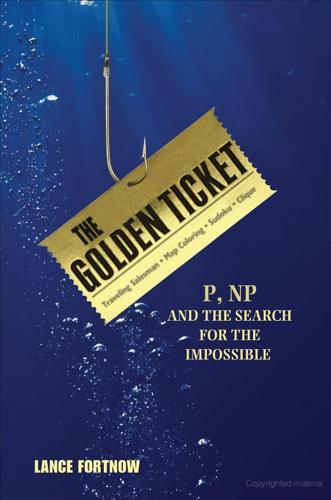
The Golden Ticket: P, NP, and the Search for the Impossible
by
Lance Fortnow
Published 30 Mar 2013
Now these chips do more than one computation at a time, working together in parallel, to solve problems faster by doing more than one thing at a time. Let’s look at one machine in particular, IBM’s Watson, which played and won on the game show Jeopardy on episodes first broadcast in February 2011. Watson consisted of ninety IBM POWER 750 servers, each with four POWER7 processors. A POWER7 processor actually has eight processors (called cores) so it can run eight simultaneous computations at once. That’s thirty-two cores per server for a total of 2,880 cores in the entire Watson system. Watson does 2,880 simultaneous computations so it can interpret the Jeopardy “answer” and determine whether to buzz in that fraction of a section before its opponents.
…
See P Einstein, Albert, 21 ellipsoid algorithm, 69–70 employment, effect of P = NP on, 27 Enigma machine, 124–26, 125 entertainment, automated creation of, 25 Entscheidungsproblem, 49 Erdős, Paul, 32, 32n Euler, Leonhard, 38–39 Eulerian paths, 39, 39 Exclusive-OR gates, 114, 116 exponential order, versus algebraic order, 76–77 Facebook: encryption on, 128–29; largest clique on, 8–9 face recognition, 22–23 factoring, 67–69, 127–28, 129, 146–47 fantasy sports, 18 Fermat’s Last Theorem, 7, 110 “A Few Words on Secret Writing” (Poe), 124 Feynman, Richard, 143 Fields Medal, 12 films, automated creation of, 25 finite automaton, 75 Floyd-Warshall algorithm, 33 four-color theorem, 42–44, 43, 46, 92–96, 93, 94, 95, 96 Frenemy: cliques in, 36–37, 45, 52, 52–53; description of, 29; grouping in, 44, 44–45, 46; map of, 96, 96; matchmaking in, 33–36, 34, 35; painting houses in, 42–44, 46; Pass the Rod game in, 37–41, 45–46; six degrees rule in, 30–33 friendship diagram: approximation for, 104; in graph isomorphism, 66, 66–67; logical expressions as, 55 Fukushima power station, 161 fully homomorphic cryptography, 138–39 functions, of maximal complexity, 79–80 game protocols, 136–38 gates, in circuits, 113, 113–18, 114, 115, 116 general relativity theory, 21 genetics research, in Soviet Union, 81 Gentry, Craig, 139 Georgia Tech, 25 GE Research Labs, 76 Gödel, Kurt, 6, 9, 49, 85–86, 111, 111n Gödel Prize, 86 Goemans, Michel, 45 “The Gold Bug” (Poe), 124 golden ticket, finding, 1–2 Google: algorithms of, 159; name of, 34; processing power of, 2 googol, 34 GPS, calculations of, 7–8 graph isomorphism, 66, 66–67 grouping, 44, 44–45 Grover, Luv, 146 Guthrie, Francis, 42 hackers, methods of, 141 Haken, Wolfgang, 42 halting problem, 74 Hamilton, William Rowan, 40 Hamiltonian paths, 41, 45–46 hand, controlling, 5–6, 165 handwriting recognition, 21–23, 22 hard functions, generation of, 80 Hartmanis, Juris, 76, 109 Hawking, Stephen, x Hellman, Martin, 126, 127 heuristics, 92–97 Hilbert, David, 49 https, 128–29 Hubble telescope, 158 Hull, Tom, 51 human body, teleporting, 153 human factors, in dealing with innovation, 161 human genome, mapping, 47–48, 158 IBM T. J. Watson Research Center, 78 Icosian game, 40–41, 41, 50 identity spoofing, 136 identity theft, 106–7 IEEE Foundations of Computer Science conference, 148 innovation, dealing with, 160–61 integrated circuits, 113, 113–14 Intel microprocessors, 90–91 interior point algorithm, 70 International Conference on Theory and Applications of Satisfiability, 96 Internet: quantum cryptography over, 149; security on, 128–29; size of, 2, 34; tracking over, 159–60 “The Intrinsic Computational Difficulty of Functions” (Cobham), 76, 77 Jeopardy!, 156–57 job scheduling problem, 56–57, 87 Johnson, Pete, 24 Journal of the Association of Computing Machinery, 118–19 Karmarkar, Narendra, 70 Karp, Richard, 6–7, 55–58, 77–78 Kasner, Edward, 34 Katrina (hurricane), 161 Kempe, Alfred, 42 Kepler, Johannes, 20 Khachiyan, Leonid, 69–70 Khot, Subhash, 104 al-Khwārizmī, Muhammad ibn Mūsā, 32 kidney exchange problem, 64–65 Kiev University, 84 Kleene, Stephen, 75 Knuth, Donald, 58 Kolmogorov, Andrey, 79, 80–83, 84, 167 Kolmogorov complexity, 83 Komsomol, 85 language, sentences in, 75, 75–76 language translation, 18, 23 Large Hadron Collider, 158 law enforcement, and P = NP, 25–26 laws of motion, 20–21 Levin, Leonid, 6, 79, 83–85 LHC Computing Grid, 158 Liapunov, Alexy, 79 liar’s paradox, 110–13 linear programming, 69–70, 70 linguistics, context-free grammar in, 75, 75–76 logical functions: circuit complexity of, 79–80; for cliques, 53–54; as friendship diagram, 55; satisfiable, 54, 79 Loren, Sophia, and Kevin Bacon, 31–32 Los Alamos National Lab, 149 machine learning, 22, 22–23, 159 Major League Baseball, 16–19 map coloring: explanation of problem, 42–43, 43; heuristic for, 92–96, 93, 94, 95, 96; as NP, 46 market equilibrium, 49 marketing, P = NP and, 27 Martian rule, 86–87 Marxism, and probability theory, 81 Massachusetts Institute of Technology, 85 matchmaking, 33–36, 34, 35, 117–18 mathematics, NP problems in, 49–50 math puzzles, usefulness of, 4–5 Matsuoka, Yoky, 5–6, 165 max-cut problem, 45, 46 McCulloch, Warren, 75 McLean, Malcolm, 160 medicine, and P = NP, 14–15 Merkle, Roger, 127 messenger RNA (mRNA), 47–48 Meyer, Albert, 85 microprocessors: capabilities of, 90–92; parallel, 155, 156–57; speed of, 156 microwave attack, 107 Milgram, Stanley, 30–31 Millennium Problems, 7, 14 min-cut problem, 44, 44–45 Minesweeper, 61–62, 62 minimum energy states, 48 MMORPG (massively multiplayer online role-playing game), 66, 66–67 Moore, Gordon, 156 Moore’s law, 91, 92, 156 Moscow State University, 80, 84 Mulmuley, Ketan, 121 music, automated creation of, 24–25 Nash, John, 49 National Center for Supercomputing Applications (NCSA), 13–14 natural proofs, 118 NC (Nick’s Class) problems, 157–58 Neumann, John von, 6, 85–86 neural nets, creation of, 75 Nevada, neighbors of, 42–43, 43 Newton, Isaac, 20–21 New York to Chicago, possible routes, 7–8 Nobel Prize, for Nash, 49 NOT gates, 79, 114, 114, 116–17 Novikov, Pyotr, 79 Novosibirsk State University, 83–84 NP (nondeterministic polynomial time): in biology, 47–48; circuit size in, 116; in economics, 49; examples of, 46; in mathematics, 49–50; meaning of, ix, 4; in physics, 48, 48; reduction to satisfiability, 54–55 NP-complete problems: accepting unsolvability of, 107–8; approximation for, 99–104, 100, 101, 102, 103; brute force approach to, 90–92, 91; categorizing, 59; changing the problem, 105–7; commonality of, 162; examples of, 59–65; and factoring, 140–41; heuristics for, 92–97; Levin’s work with, 84–85; naming of, 58; problems of unknown status, 65–70; quantum algorithms for, 146–47; small solutions for, 97, 97–99, 98; Sudoku as, 135–36 NP = NC, 157–58 number theory, 68 observation: entanglement and, 147; in outcome, 144 Occam’s razor, 19–23 100 factorial (100!)
…
Later developments in randomized and quantum computation will show that perhaps we cannot have a fixed notion of efficient computation. Then in 1971 came Steve Cook’s paper that defined NP, the problems we can verify efficiently, the P versus NP problem, and the first NP-complete problem. A year later Richard Karp gave his paper showing that a number of important problems were NP-complete. In 1972 the IBM T. J. Watson Research Center hosted the Symposium on the Complexity of Computer Computations, a meeting mostly remembered for Karp’s presentation of his paper. The organizers of the meeting held a panel discussion at the end of the symposium on the future of the field. One of the questions asked was, “How is the theory developing from originally being a scattering of a few results on lower bounds and some algorithms into a more unified theory?”

The Patient Will See You Now: The Future of Medicine Is in Your Hands
by
Eric Topol
Published 6 Jan 2015
Techniques from machine learning and artificial intelligence are what powered the triumph of the IBM Watson supercomputer over humans on Jeopardy. This relied upon quickly answering complex questions that would not be amenable to a Google search.30–32 IBM Watson was taught through hundreds of thousands of questions from prior Jeopardy shows, armed with all the information in Wikipedia, and programmed to do predictive modeling. There’s no prediction of the future here, just prediction that IBM Watson has the correct answer. Underlying its predictive capabilities was quite a portfolio of machine learning systems, including Bayesian nets, Markov chains, support vector machine algorithms, and genetic algorithms.33 I won’t go into any more depth; my brain is not smart enough to understand it all, and fortunately it’s not particularly relevant to where we are going here.
…
“Move Over, Siri,” The Economist, November 30, 2013, http://www.economist.com/news/technology-quarterly/21590760-predictive-intelligence-new-breed-personal-assistant-software-tries/print. 30. “A Cure for the Big Blues,” The Economist, January 11, 2014, http://www.economist.com/node/21593489/print. 31. S. E. Ante, “IBM Struggles to Turn Watson Computer into Big Business,” Wall Street Journal, January 7, 2014, http://online.wsj.com/news/articles/SB10001424052702304887104579306881917668654. 32. J. Hempel, “IBM’s Massive Bet on Watson,” CNN Money, September 19, 2013, http://money.cnn.com/2013/09/19/technology/ibm-watson.pr.fortune/index.html?pw_log=in. 33. A. Bari, M. Chaouchi, and T. Jong, Predictive Analytics for Dummies (Hoboken, NJ: John Wiley & Sons, 2014), 129. 34.
…
Online symptom checkers66 are getting increasing electronic traffic and attention on the Internet to help people “self” (computer-assisted) diagnose, but they don’t predict an illness. At best, from a cluster of symptoms that a person inputs, a differential diagnosis is offered with the right one on the list. That’s useful and practical, but not predicting anything. Likewise, the Biovideo developers—who are building an app for the IBM Watson supercomputer so that “a mother with a sick child at 4 am will be able to use IBM Watson to ask what is wrong with her baby and get a 100 per cent accurate response”67a—may create something useful, but that something is not about prediction. We have a very serious problem with misdiagnosis—diagnosis of a patient with the wrong disease or the correct one too late—affecting 12 million Americans per year.67b,67c We can look to technology and contextual computing to help alleviate this struggle.

The Singularity Is Nearer: When We Merge with AI
by
Ray Kurzweil
Published 25 Jun 2024
Thus, beating Kasparov could be written off as just a fancy trick of math. By contrast, some observers confidently predicted, computers would never master the kinds of ambiguous natural-language tasks that are needed to solve crossword puzzles or compete on the long-running quiz show Jeopardy![155] But crosswords fell within two years,[156] and less than twelve years after that, IBM’s Watson went on Jeopardy! and handily defeated the two greatest human players, Ken Jennings and Brad Rutter.[157] These matches demonstrate a very important idea about AI and the Turing test. Based on Watson’s ability to process game clues, buzz in, and confidently call out correct responses with his synthesized voice, “he” presented a very convincing illusion that he was thinking in a way that was very similar to how Ken and Brad were thinking.
…
BACK TO NOTE REFERENCE 156 For a representative video clip from the matches and analyses of Watson and the competition, see OReilly, “Jeopardy! IBM Challenge Day 3 (HD) Ken Jennings vs. WATSON vs. Brad Rutter (02-16-11),” Vimeo video, June 19, 2017, https://vimeo.com/222234104; Sam Gustin, “Behind IBM’s Plan to Beat Humans at Their Own Game,” Wired, February 14, 2011, https://www.wired.com/2011/02/watson-jeopardy; John Markoff, “Computer Wins on ‘Jeopardy!’: Trivial, It’s Not,” New York Times, February 16, 2011, https://www.nytimes.com/2011/02/17/science/17jeopardy-watson.html. BACK TO NOTE REFERENCE 157 “Show #6088—Wednesday, February 16, 2011,” J!
…
Social media and smartphones have gone from virtually nonexistent to all-day companions that now connect a majority of the world’s population. Algorithmic innovations and the emergence of big data have allowed AI to achieve startling breakthroughs sooner than even experts expected—from mastering games like Jeopardy! and Go to driving automobiles, writing essays, passing bar exams, and diagnosing cancer. Now, powerful and flexible large language models like GPT-4 and Gemini can translate natural-language instructions into computer code—dramatically reducing the barrier between humans and machines. By the time you read this, tens of millions of people likely will have experienced these capabilities firsthand.
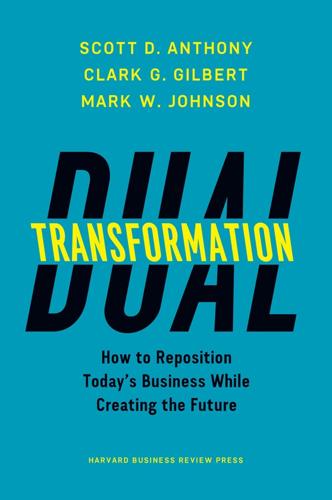
Dual Transformation: How to Reposition Today's Business While Creating the Future
by
Scott D. Anthony
and
Mark W. Johnson
Published 27 Mar 2017
Education will increasingly move from something that is done at a specific point in people’s lives to something that is truly perpetual. Let’s dream a little bigger. What if Netflix and IBM were to pair up to fundamentally disrupt health care? IBM’s Watson platform is best known to many people for its appearance on (and domination of) the popular quiz show Jeopardy. But IBM is working hard to apply Watson’s supercomputing brainpower to complex problems such as addressing difficult-to-diagnose health conditions. Imagine Netflix tuning its discovery and recommendation power to help individuals make all the day-to-day behavior modifications required to live healthier, happier lives?
…
See also transformation B creating goals/boundaries for, 121–123 creating separate new engine for, 12 disruption as opportunity for, 47–50 fitness landscape and, 7–8 gap in, determining, 118–121, 213–214 portfolio management systems and, 80–82 rapid, as warning sign, 108–109 slowing revenue, as warning sign, 107 strategic opportunity areas and, 123–127 Guaranteach, 69 Gupta, Piyush, 151 Hait, William N., 17, 18, 19 Hall, Taddy, 38 The Haloid Photographic Company, 13 Hancock, Jake, 84 Hardless, Edgar, 143 Harvard Business School MBA program, 103, 110–113, 176 Hastings, Reed, 23, 32–36 decision making by, 93–95 education and, 69–70 HBO, 5, 35 HBX, 113 health care industry acquisitions in, 22–23 Aetna, 23, 87, 99–102 constrained market in, 59–61 illusory nonconsumption in, 62–63 Johnson and Johnson, 16–22 medical devices, 203–204 Medtronic, 72–73 Netflix and IBM in, 70 retailization of, 101 Healthy Family, 127 Healthy Heart for All, 73, 74 Hill, Andy, 131 Hill, Linda, 146 Hinckley, Gordon B., 41 Hoffman, Reid, 49 HOPE acronym, 65 Horowitz, Ben, 206 House of Cards, 35 House of Payne, 98 Houston, Drew, 151 the how, changing in transformation A, 36–45 Huffington, Arianna, 27 Huffington Post, 27, 28 Humana, 183 Hundred Flowers Campaign, 117 Hurley, Chad, 97 HyperText Markup Language (HTML), 3 IBM, 8, 54, 132 Watson, 70, 204 ibrutinib, 19 Icahn, Carl, 15 ideas, sharing, 149 identity crises, 168–173, 193–197 IDEO, 61 Imbruvica, 19 industry entrant activity, 104–105, 112 Innosight, 61, 77, 93 Innov8, 143–144 innovation business model, 40–42 in business models, 20 catalysts in, 104–105 creating safe spaces for, 143–145 in established companies, 71–72 for improving today and creating tomorrow, 55 incumbents’ failure in, 14–15 pace of disruptions and, 4–5 physical environment and, 148 predictability and, 137–139 sharing ideas and, 149 simplifying experiments and, 148–149 Innovation: The Attacker’s Advantage (Foster), 71 The Innovator’s Dilemma (Christensen), 14–15, 36, 71 The Innovator’s Extinction (Ulmer), 71–72 The Innovator’s Guide to Growth (Anthony, Johnson, Sinfield, and Altman), 62 Instagram, 48 Institute for Health Sciences, 204 Intel, 78–79 InterActive Corp, 49–50 interface management, 75, 80–87 arbitration in, 86–87 exchange teams in, 82–83 transfer pricing in, 85 internet browsers, 2–3, 47 media transformations from, 2–3 Intuit, 132–133 inverse mentors, 150–151 investment curiosity and funding of, 141 at Deseret, 30 estimating potential of existing, 119 at SingPost, 52–53 by venture capitalists, 103–104 iPhone, 4, 92–93, 104 iPod, 92–93 Israel, Simon, 53, 142 iTunes, 92–93 Janssen, Paul, 16 Janssen Pharmaceuticals, 16–22 business model innovation at, 42 postdisruption job to be done at, 39 Jarden Consumer Solutions (JCS), 130–131 Jasper, 143 Jassy, Andy, 53–54 Jensen, Michael, 177 job loss, 7 at Deseret, 30 at Media General, 157 Jobs, Steve, 4, 8 destruction by, 132 focus of, 116 influenced by Xerox, 13 Motorola and, 92–93 transformation journey of, 181–182 job to be done, 21 determining defensible postdisruption, 36–39 Johnson, Lyndon, 116 Johnson, Mark, 36, 53, 62, 109–110 Johnson & Johnson, 16–22, 177–178 Joyce, Jim, 64 Karim, Jawed, 97 Kay, Alan, 154 Kennedy, John F., 24, 115–116, 117, 132 Kickbox, 148–149 Kickstart Ventures, 143–144 Knewton, 56, 67 Knight, Wayne, 95 Knight Ridder, 97 Kodak, 1–2, 4, 11 Kodak Moments, 1–2 Koonin, Steve, 95 KPO, 51 KSL, 8, 9, 29, 68 Kuhn, Thomas, 68 Lafley, A.G., 124, 137 Lasseter, John, 4 Lazarus, Mark, 95 Lead and Disrupt (O’Reilly and Tushman), 53, 54 leaders and leadership commitment to transformation A implementation by, 43–45 conflict arbitration by, 86–87 conviction to persevere and, 24, 155–179 courage in decision making and, 91–113 on crises of commitment, 186–189 on crises of conflict, 189–193 curiosity in, 24, 135–154 discussion questions for, 210 in dual transformation, 23–24 exchange teams and, 83–84 exposing to new thinking, 145–147 focus and, 24, 115–133 greatest challenge facing current, 5, 11 hands-on involvement by, 44 in maintaining transformations, 162–163 mindsets for success in, 23–24 opportunity of disruption and, 11–12 overestimation of alignment by, 119 profiles of transformation, 182–186 purpose and, 176–178 understanding customer problems and the job to be done, 38–39 The Lean Startup (Ries), 65, 153 LeBlanc, Paul, 58 le Carré, John, 153 Lee, Christopher M., 67–68, 86–87 Lee Hsien Yang, 136 Lee Kuan Yew, 136 LegalZoom, 207 Lenovo, 92 Levitt, Ted, 37, 175 Lew, Allen, 144–145 Lim Ho Kee, 53 Linford, Jon, 84 LinkedIn, 49 Lin Media, 156 local maximums, 6 lunar module frame, 131–132 Lyft, 205 Lynch, Kevin, 32 Major League Baseball, 98–99 Manila Water, 117–128, 184–185 determining goals and boundaries at, 121–123 focus at, 142 growth gap determination at, 118–121 outcomes for, 127–128 strategic opportunity areas of, 123–127 Mao Zedong, 116–117 Marcial, Sharon, 127 margins, 122 “Marketing Myopia” (Levitt), 175 markets identifying constrained, 59–63 opened by disruptions, 5 Marriott, 8 Martin, George R.R., 5 Martin, Roger, 124, 140, 177 McClatchy, 97 McGrath, Rita, 65, 146 Meckling, William, 177 media companies founded after disruption in, 47–50 streaming, 33–36, 93–95 transformations in, 2–3 Media General, 155–157 Medicity, 183 Medtronic, 72–73, 74 Merck, 22 metrics, 42–43 microlenders, 73 Microsoft, 4, 49, 54 Mint, 132 mission statements, 177, 178 mobile phones, 3–5, 91–93 banking and, 151–152 shipping industry and, 202–203 Monte Carlo techniques, 98–99 moonshot, 24, 115–116, 131–132 Morton, Marshall, 155–156 motivation, 175–176 leaders on, 194 Motorola, 4–5, 92 M-PESA, 201 Mulally, Alan, 153–154 Mulcahy, Anne, 14, 86 multisystem operators (MSOs), 96, 98–99 Murdoch, Rupert, 97, 109 Myspace, 48, 97, 109 Narayen, Shantanu, 31–33 National Basketball Association, 98–99 National Science Foundation, 56 Navarrete, Minette, 143–144 Nestlé, 204 Netflix, 23, 97, 104 Amazon Web Services and, 54 business model innovation at, 40, 42, 146 business model of, 106 content creation at, 34–35 decision making at, 93–95, 102 early warning signs at, 108 metrics at, 43 postdisruption job to be done at, 39 transformation A at, 32–36 transformation B at, 69–70 transformation journey at, 181 net present value (NPV), 110 net promoter scores, 78 Netscape, 2–3, 47 News Corp, 48, 97 Newspaper Association of America, 3 newspapers.
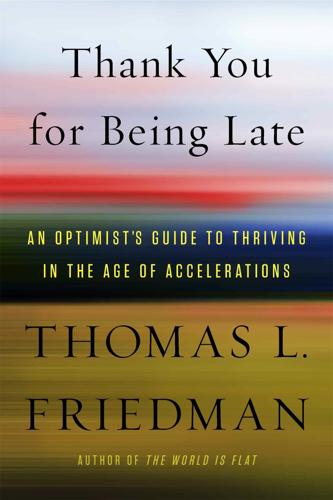
Thank You for Being Late: An Optimist's Guide to Thriving in the Age of Accelerations
by
Thomas L. Friedman
Published 22 Nov 2016
“Watson is no longer contained in a box that is unconnected to the Internet, but rather is now of the Internet,” explained David Yaun, an IBM communications vice president. IBM put together the mini-Watson mockup “to illustrate that we could cram all the computing power of the Jeopardy! Watson into a suitcase today. But Watson itself now is literally part of your supernova—unleashed from a twentieth-century paradigm of a box or a standalone server.” And anyway—Watson’s grandson would never waste his time trying to beat humans on Jeopardy! That is so 2011! Today’s Watson is now busy ingesting all known medical research on subjects such as cancer diagnostics and treatments.
…
It could happen only after Moore’s law entered the second half of the chessboard and gave us sufficient power to digitize almost everything imaginable—words, photos, data, spreadsheets, voice, video, and music—as well as the capacity to load it all into computers and the supernova, the networking ability to move it all around at high speed, and the software capacity to write multiple algorithms that could teach a computer to make sense of unstructured data, just as a human brain might, and thereby enhance every aspect of human decision making. When IBM designed Watson to play Jeopardy!, Kelly explained to me, it knew from studying the show and the human contestants exactly how long it could take to digest the question and buzz in to answer it. Watson would have about a second to understand the question, half a second to decide the answer, and a second to buzz in to answer first.
…
On February 14, 2011, a turning point of sorts in the history of humanity was reached on—of all places—one of America’s longest-running television game shows, Jeopardy! That afternoon one of the contestants, who went by just his last name, Watson, competed against two all-time great Jeopardy! champions, Ken Jennings and Brad Rutter. Mr. Watson did not try to respond to the first clue, but with the second clue he buzzed in first to answer. The clue was: “Iron fitting on the hoof of a horse or a card-dealing box in a casino.” Watson, in perfect Jeopardy! style, responded with the question “What is ‘shoe’?” That response should go down in history with the first words ever uttered on a telephone, on March 10, 1876, when Alexander Graham Bell, the inventor, called his assistant—whose name, ironically, was Thomas Watson—and said, “Mr.

Hit Refresh: The Quest to Rediscover Microsoft's Soul and Imagine a Better Future for Everyone
by
Satya Nadella
,
Greg Shaw
and
Jill Tracie Nichols
Published 25 Sep 2017
The following year Deep Blue went a giant step further when it defeated Russian chess legend Garry Kasparov in an entire six-game match. It was stunning to see a computer win a contest in a domain long regarded as representing the pinnacle of human intelligence. By 2011, IBM Watson had defeated two masters of the game show Jeopardy!, and in 2016 Google DeepMind’s AlphaGo outplayed Lee Se-dol, a South Korean master of Go, the ancient, complex strategy game played with stones on a grid of lines, usually nineteen by nineteen. Make no mistake, these are tremendous science and engineering feats. But the future holds far greater promise than computers beating humans at games.
…
See also United Kingdom British Raj, 16, 186–87 broadband infrastructure, 225 Buddha, Gautama, 9 Burgum, Doug, 47–48 cable TV, 30 Cairo, 214, 218 cameras, 150 Canada, 230 cancer, 142, 159, 214 Candidate, The (film), 75 capabilities, 122–23, 141 capitalism, 237–38 late-stage, 221 Capossela, Chris, 3, 71, 81–82 Carnegie Mellon, 3 Carney, Susan L., 177 Carroll, Pete, 4 Case, Anne, 236 Cavium Networks, 20 CD-ROM, 28 CEO as curator of culture, 100, 241 “disease,” 92 panoramic view of, 118 cerebral palsy, 8–10 Chang, Emily, 129 charter city, 229 Cheng, Lili, 197 chess, 198–99 Chik, Joy, 58 child exploitation, 190 Chile, 223, 230 China, 86, 195, 220, 222, 229, 232, 236 chip design, 25 CIA, 169 Cisco, 174 civil liberties, 172–73 civil rights, 24 civil society, 179 Civil War, 188 clarity, 119 Clayton, Steve, 155 client/server era, 45 climate change, 142, 214 Clinton, Hillary, 230 cloud, 13, 41–47, 49, 51–62, 68, 70, 73, 81, 88, 110, 125, 129, 131, 137, 140, 150, 164, 166, 172, 180–81, 186, 189–92, 216, 219, 223–25, 228 cloud-first mission and, 57–58, 70, 76, 79, 83 public, 42–43, 57 Cloud for Global Good, 240–41 Codapalooza, 104 cognition, 89, 150, 152–53 Cohen, Leonard, 10 collaboration, 88, 102–3, 106–8, 126, 135, 163–64, 166, 200 collaborative robots (co-bots), 204 collective IQ, 142, 143 Colombia, 78 Columbia University, 165 Comin, Diego, 216–17, 226 commitment, shared, 77, 119 Common (hip hop artist), 71 Common Objects in Context challenge, 151 communication, 76–77 Compaq, 29 comparative advantage, 222, 228 competition, internal, 52 competitive zeal, 38–39, 70–71, 102 competitors, 39 partnerships and, 78, 125–38 complexity, 25, 224 computers early, 21–22, 24–26 future platforms, 110–11 programs by, 153–54 computing power, massive, 150–51 Conard, Edward, 220 concepts, 122–23, 141 consistency, 77–78, 182 Constitution Today, The (Amar), 186–87 constraints, 119 construction companies, 153 consumers, 49–50, 222 context, shared, 56–57 Continental Congress, 185 Continuum, 73 Convent of Jesus and Mary (India), 19 Cook, Tim, 177 cook stoves, 43 coolness, 75–76 core business, 142 Cortana, 125, 152, 156–58, 195, 201 Couchbase company, 58 counterintuitive strategy, 56–57 Coupland, Douglas, 74 Courtois, Jean-Philippe, 82 courts, 184–85 Covington and Burling lawyers, 3 Cranium games, 7 creativity, 58, 101, 119, 201, 207, 242 credit rating, 43, 204–5 Creed (film), 44–45 cricket, 18–22, 31, 35–40, 115 Cross-country Historical Adoption of Technology (CHAT), 217 culture bias and, 205 “live site first,” 61 three Cs and, 122–23, 141 transforming, 2, 11, 16, 40, 76–78, 81–82, 84, 90–92, 98–103, 105, 108–10, 113–18, 120, 122–23, 241–42 Culture (Eagleton), 91 Curiosity (Mars rover), 144 customer needs, 42, 59, 73, 80, 83, 88, 99, 101–2, 108, 126, 138 customization, 151 cybersecurity, 171, 190 cyberworld, rules for, 184 data, 60, 151 data analytics, 50 databases, 26 Data General company, 68 data management, 54 data platform, 59 data security, 175–76, 188–89 Deaton, Angus, 236 Deep Blue, 198–99 deep neural networks, 153 Delbene, Kurt, 3, 81–82 Delhi, India, 19, 31, 37 Dell, 63, 87, 127, 129–30 Dell, Michael, 129 democracy, 180 democratization, 4, 13, 69, 127, 148, 151–52 Deng Xiaoping, 229 Depardieu, Gerard, 33 design, 50, 69, 141, 239 desktop software, 27 Detroit, 15, 225, 233 developed economies, 99–100 share of world income, 236 developing economies, 99–100, 217, 225 device management solutions, 58 digital assistants, 142, 156–58, 195–98, 201 digital cable, 28 digital evidence, 191–92 Digital Geneva Convention, 171–72 digital ink, 142 digital literacy, 226–27 digital publishing laws, 185 digital transformation, 70, 126–27, 132, 235 dignity, 205 disabilities, 103, 200 disaster relief, 44 Disney, 150 disruption, 13 distributed systems, 49 diversity, 101–2, 108, 111–17, 205–6, 238, 241 Donne, John, 57 drones, 209, 226 Drucker, Peter, 90 dual users, 79 Dubai, 214, 228 Duke University, 3 Dupzyk, Kevin, 147 D-Wave, 160 Dweck, Carol, 92 dynamic learning, 100 Dynamics, 121 Dynamics 365, 152 dyslexia, 44, 103–4 Eagleton, Terry, 91 earthquakes, 44 EA Sports, 127 economic growth, 211–34 economic inequality, 12, 207–8, 214, 219–21, 225, 227, 236–41 Edge browser, 104 education, 42–44, 78, 97, 104, 106–7, 142, 145, 206–7, 224, 226–28, 234, 236–38 Egypt, 218–19, 223, 225 E-health companies, 222–23 8080 microprocessor, 21 elasticity, 49 electrical engineering (EE), 21–22 elevator and escalator business, 60 Elop, Stephen, 64, 72 email, 27, 169–73, 176 EMC, 129 emotion, 89, 197, 201 emotional intelligence (EQ), 158, 198 empathy, 6–12, 16, 40, 42–43, 93, 101, 133–34, 149, 157, 182, 197, 201, 204, 206, 226, 239, 241 employee resource groups (ERGs), 116–17 employees, 66–68, 75, 138 diversity and, 101, 111–17 empowerment and, 79–80, 126 global summit of, 86–87 hackathon, 10–11 talent development and, 117–18 empowerment, 87–88, 98–99, 106, 108–10, 126 encryption, 161–62, 175, 192–93 energy, generating across company, 119 energy costs, 237 Engelbart, Doug, 142 Engelbart’s Law, 142–43 engineers, 108–9 Enlightiks, 222–23 Enterprise Business, 81 entertainment industry, 126 ethics, 195-210, 239 Europe, 193 Excel, 121 experimental physicists, 162–64 eye-gaze tracking, 10 Facebook, 15, 44, 51, 125, 144, 174, 200, 222 failures, overcoming, 92, 111 Fairfax Financial Holdings, 20 fairness, 236 Federal Bureau of Investigation (FBI), 170, 177–78, 189 Federal Communications Commission (FCC), 28 fear of unknown, 110–11 feedback loop, 53 fertilizer, 164 Feynman, Richard, 160 fiefdoms, 52 field-programmable gate arrays (FPGAs), 161 Fields Medal, 162 firefighters, 43, 56 First Amendment, 185, 190 Flash, 136 focus, 135–36, 138 Foley, Mary Jo, 52 Ford Motor Company, 64 foreign direct investment, 219, 225, 229 Foreign Intelligence Surveillance Act (FISA), 173 Fourth Amendment, 185–88, 190, 193 France, 223, 236 Franco, James, 169 Franklin, Benjamin, 186 Freedman, Michael, 162, 166 free speech, 170–72, 175, 179, 185, 190, 238 Fukushima nuclear plant, 44 G20 nations, 219 Galaxy Explorer, 148 game theory, 123–24 Gandhi, Mohandas Mahatma, 16 Gartner Inc., 145 Gates, Bill, 4, 12, 21, 28, 64, 46, 67–69, 73–75, 87, 91, 127, 146, 183, 203 Gavasker, Sunil, 36 GE, 3, 126–27, 237 Gelernter, David, 143, 183 Geneva Convention, Fourth (1949), 171 Georgia Pacific, 29 Germany, 220, 223, 227–36 Gervais, Michael, 4–5 Gini, Corrado, 219 Gini coefficient, 219–21 GLEAM, 117 Gleason, Steve, 10–11 global competitiveness, 78–79, 100–102, 215 global information, policy and, 191 globalization, 222, 227, 235–37 global maxima, 221–22 goals, 90, 136 Goethe, J.W. von, 155 Go (game), 199 Goldman Sachs, 3 Google, 26, 45, 70–72, 76, 127, 160, 173–74, 200 partnership with, 125, 130–32 Google DeepMind, 199 Google Glass, 145 Gordon, Robert, 234 Gosling, James, 26 government, 138, 160 cybersecurity and, 171–79 economic growth and, 12, 223–24, 226–28 policy and, 189–92, 223–28 surveillance and, 173–76, 181 Grace Hopper, 111–14 graph coloring, 25 graphical user interfaces (GUI), 26–27 graphics-processing unit (GPU), 161 Great Convergence, the (Baldwin), 236 Great Recession (2008), 46, 212 Greece, 43 Green Card (film), 33 Guardians of Peace, 169 Gutenberg Bible, 152 Guthrie, Scott, 3, 58, 60, 82, 171 H1B visa, 32–33 habeas corpus, 188 Haber, Fritz, 165 Haber process, 165 hackathon, 103–5 hackers, 169–70, 177, 189, 193 Hacknado, 104 Halo, 156 Hamaker, Jon, 157 haptics, 148 Harvard Business Review, 118 Harvard College, 3 Harvey Mudd College, 112 Hawking, Stephen, 13 Hazelwood, Charles, 180 head-mounted computers, 144–45 healthcare, 41–42, 44, 142, 155–56, 159, 164, 198, 218, 223, 225, 237 Healthcare.gov website, 3, 81, 238 Heckerman, David, 158 Hewlett Packard, 63, 87, 127, 129 hierarchy, 101 Himalayas, 19 Hindus, 19 HIV/AIDS, 159, 164 Hobijn, Bart, 217 Hoffman, Reid, 232, 233 Hogan, Kathleen, 3, 80–82, 84 Holder, Eric, 173–74 Hollywood, 159 HoloLens, 69, 89, 125, 144–49, 236 home improvement, 149 Hong Kong, 229 Hood, Amy (CFO), 3, 5, 82, 90 Horvitz, Eric, 154, 208 hospitals, 42, 78, 145, 153, 223 Hosseini, Professor, 23 Huang, Xuedong, 151 human capital, 223, 226 humanistic approach, 204 human language recognition, 150–51, 154–55 human performance, augmented by technology, 142–43, 201 human rights, 186 Hussain, Mumtaz, 36, 37 hybrid computing, 89 Hyderabad, 19, 36–37, 92 Hyderabad Public School (HPS), 19–20, 22, 37–38, 136 hyper-scale, cloud-first services, 50 hypertext, 142 IBM, 1, 160, 174, 198 IBM Watson, 199–200 ideas, 16, 42 Illustrator, 136 image processing, 24 images, moving, 109 Imagine Cup competition, 149 Immelt, Jeff, 237 Immigration and Naturalization Act (1965), 24, 32–33 import taxes, 216 inclusiveness, 101–2, 108, 111, 113–17, 202, 206, 238 independent software vendor (ISV), 26 India, 6, 12, 17–22, 35–37, 170, 186–87, 222–23, 236 immigration from, 22–26, 32–33, 114–15 independence and, 16–17, 24 Indian Administrative Service (IAS), 16–17, 31 Indian Constitution, 187 Indian Institutes of Technology (IIT), 21, 24 Indian Premier League, 36 IndiaStack, 222–23 indigenous peoples, 78 Indonesia, 223, 225 industrial policy, 222 Industrial Revolution, 215 Fourth or future, 12, 239 information platforms, 206 information technology, 191 Infosys, 222 infrastructure, 88–89, 152–53, 213 innovation, 1–2, 40, 56, 58, 68, 76, 102, 111, 120, 123, 142, 212, 214, 220, 224, 234 innovator’s dilemma, 141–42 insurance industry, 60 Intel, 21, 45, 160, 161 intellectual property, 230 intelligence, 13, 88–89, 126, 150, 154–55, 160, 169, 173, 239 intelligence communities, 173 intensity of use, 217, 219, 221, 224–26 International Congress of the International Mathematical Union, 162 Internet, 28, 30, 48, 79, 97–98, 222 access and, 225–26, 240 security and privacy and, 172–73 Internet Explorer, 127 Internet of Things (IoT), 79, 134, 142, 228 Internet Tidal Wave, 203 Intersé, 3 Interview, The (film), 169–71 intimidation, 38 investment strategy, 90, 142 iOS devices, 59, 72, 123, 132 iPad, 70, 141 iPad Pro, 123–25 iPhone, 70, 72, 85, 121–22, 125, 177–79 Irish data center, 176, 184 Islamic State (ISIS), 177 Istanbul, 214 Jaisimha, M.L., 18, 36–37 Japan, 44, 223, 230 Japanese-American internment, 188 JAVA, 26 Jeopardy (TV show), 199 Jha, Rajesh, 82 jobs, 214, 231, 239–40.
…
See also United Kingdom British Raj, 16, 186–87 broadband infrastructure, 225 Buddha, Gautama, 9 Burgum, Doug, 47–48 cable TV, 30 Cairo, 214, 218 cameras, 150 Canada, 230 cancer, 142, 159, 214 Candidate, The (film), 75 capabilities, 122–23, 141 capitalism, 237–38 late-stage, 221 Capossela, Chris, 3, 71, 81–82 Carnegie Mellon, 3 Carney, Susan L., 177 Carroll, Pete, 4 Case, Anne, 236 Cavium Networks, 20 CD-ROM, 28 CEO as curator of culture, 100, 241 “disease,” 92 panoramic view of, 118 cerebral palsy, 8–10 Chang, Emily, 129 charter city, 229 Cheng, Lili, 197 chess, 198–99 Chik, Joy, 58 child exploitation, 190 Chile, 223, 230 China, 86, 195, 220, 222, 229, 232, 236 chip design, 25 CIA, 169 Cisco, 174 civil liberties, 172–73 civil rights, 24 civil society, 179 Civil War, 188 clarity, 119 Clayton, Steve, 155 client/server era, 45 climate change, 142, 214 Clinton, Hillary, 230 cloud, 13, 41–47, 49, 51–62, 68, 70, 73, 81, 88, 110, 125, 129, 131, 137, 140, 150, 164, 166, 172, 180–81, 186, 189–92, 216, 219, 223–25, 228 cloud-first mission and, 57–58, 70, 76, 79, 83 public, 42–43, 57 Cloud for Global Good, 240–41 Codapalooza, 104 cognition, 89, 150, 152–53 Cohen, Leonard, 10 collaboration, 88, 102–3, 106–8, 126, 135, 163–64, 166, 200 collaborative robots (co-bots), 204 collective IQ, 142, 143 Colombia, 78 Columbia University, 165 Comin, Diego, 216–17, 226 commitment, shared, 77, 119 Common (hip hop artist), 71 Common Objects in Context challenge, 151 communication, 76–77 Compaq, 29 comparative advantage, 222, 228 competition, internal, 52 competitive zeal, 38–39, 70–71, 102 competitors, 39 partnerships and, 78, 125–38 complexity, 25, 224 computers early, 21–22, 24–26 future platforms, 110–11 programs by, 153–54 computing power, massive, 150–51 Conard, Edward, 220 concepts, 122–23, 141 consistency, 77–78, 182 Constitution Today, The (Amar), 186–87 constraints, 119 construction companies, 153 consumers, 49–50, 222 context, shared, 56–57 Continental Congress, 185 Continuum, 73 Convent of Jesus and Mary (India), 19 Cook, Tim, 177 cook stoves, 43 coolness, 75–76 core business, 142 Cortana, 125, 152, 156–58, 195, 201 Couchbase company, 58 counterintuitive strategy, 56–57 Coupland, Douglas, 74 Courtois, Jean-Philippe, 82 courts, 184–85 Covington and Burling lawyers, 3 Cranium games, 7 creativity, 58, 101, 119, 201, 207, 242 credit rating, 43, 204–5 Creed (film), 44–45 cricket, 18–22, 31, 35–40, 115 Cross-country Historical Adoption of Technology (CHAT), 217 culture bias and, 205 “live site first,” 61 three Cs and, 122–23, 141 transforming, 2, 11, 16, 40, 76–78, 81–82, 84, 90–92, 98–103, 105, 108–10, 113–18, 120, 122–23, 241–42 Culture (Eagleton), 91 Curiosity (Mars rover), 144 customer needs, 42, 59, 73, 80, 83, 88, 99, 101–2, 108, 126, 138 customization, 151 cybersecurity, 171, 190 cyberworld, rules for, 184 data, 60, 151 data analytics, 50 databases, 26 Data General company, 68 data management, 54 data platform, 59 data security, 175–76, 188–89 Deaton, Angus, 236 Deep Blue, 198–99 deep neural networks, 153 Delbene, Kurt, 3, 81–82 Delhi, India, 19, 31, 37 Dell, 63, 87, 127, 129–30 Dell, Michael, 129 democracy, 180 democratization, 4, 13, 69, 127, 148, 151–52 Deng Xiaoping, 229 Depardieu, Gerard, 33 design, 50, 69, 141, 239 desktop software, 27 Detroit, 15, 225, 233 developed economies, 99–100 share of world income, 236 developing economies, 99–100, 217, 225 device management solutions, 58 digital assistants, 142, 156–58, 195–98, 201 digital cable, 28 digital evidence, 191–92 Digital Geneva Convention, 171–72 digital ink, 142 digital literacy, 226–27 digital publishing laws, 185 digital transformation, 70, 126–27, 132, 235 dignity, 205 disabilities, 103, 200 disaster relief, 44 Disney, 150 disruption, 13 distributed systems, 49 diversity, 101–2, 108, 111–17, 205–6, 238, 241 Donne, John, 57 drones, 209, 226 Drucker, Peter, 90 dual users, 79 Dubai, 214, 228 Duke University, 3 Dupzyk, Kevin, 147 D-Wave, 160 Dweck, Carol, 92 dynamic learning, 100 Dynamics, 121 Dynamics 365, 152 dyslexia, 44, 103–4 Eagleton, Terry, 91 earthquakes, 44 EA Sports, 127 economic growth, 211–34 economic inequality, 12, 207–8, 214, 219–21, 225, 227, 236–41 Edge browser, 104 education, 42–44, 78, 97, 104, 106–7, 142, 145, 206–7, 224, 226–28, 234, 236–38 Egypt, 218–19, 223, 225 E-health companies, 222–23 8080 microprocessor, 21 elasticity, 49 electrical engineering (EE), 21–22 elevator and escalator business, 60 Elop, Stephen, 64, 72 email, 27, 169–73, 176 EMC, 129 emotion, 89, 197, 201 emotional intelligence (EQ), 158, 198 empathy, 6–12, 16, 40, 42–43, 93, 101, 133–34, 149, 157, 182, 197, 201, 204, 206, 226, 239, 241 employee resource groups (ERGs), 116–17 employees, 66–68, 75, 138 diversity and, 101, 111–17 empowerment and, 79–80, 126 global summit of, 86–87 hackathon, 10–11 talent development and, 117–18 empowerment, 87–88, 98–99, 106, 108–10, 126 encryption, 161–62, 175, 192–93 energy, generating across company, 119 energy costs, 237 Engelbart, Doug, 142 Engelbart’s Law, 142–43 engineers, 108–9 Enlightiks, 222–23 Enterprise Business, 81 entertainment industry, 126 ethics, 195-210, 239 Europe, 193 Excel, 121 experimental physicists, 162–64 eye-gaze tracking, 10 Facebook, 15, 44, 51, 125, 144, 174, 200, 222 failures, overcoming, 92, 111 Fairfax Financial Holdings, 20 fairness, 236 Federal Bureau of Investigation (FBI), 170, 177–78, 189 Federal Communications Commission (FCC), 28 fear of unknown, 110–11 feedback loop, 53 fertilizer, 164 Feynman, Richard, 160 fiefdoms, 52 field-programmable gate arrays (FPGAs), 161 Fields Medal, 162 firefighters, 43, 56 First Amendment, 185, 190 Flash, 136 focus, 135–36, 138 Foley, Mary Jo, 52 Ford Motor Company, 64 foreign direct investment, 219, 225, 229 Foreign Intelligence Surveillance Act (FISA), 173 Fourth Amendment, 185–88, 190, 193 France, 223, 236 Franco, James, 169 Franklin, Benjamin, 186 Freedman, Michael, 162, 166 free speech, 170–72, 175, 179, 185, 190, 238 Fukushima nuclear plant, 44 G20 nations, 219 Galaxy Explorer, 148 game theory, 123–24 Gandhi, Mohandas Mahatma, 16 Gartner Inc., 145 Gates, Bill, 4, 12, 21, 28, 64, 46, 67–69, 73–75, 87, 91, 127, 146, 183, 203 Gavasker, Sunil, 36 GE, 3, 126–27, 237 Gelernter, David, 143, 183 Geneva Convention, Fourth (1949), 171 Georgia Pacific, 29 Germany, 220, 223, 227–36 Gervais, Michael, 4–5 Gini, Corrado, 219 Gini coefficient, 219–21 GLEAM, 117 Gleason, Steve, 10–11 global competitiveness, 78–79, 100–102, 215 global information, policy and, 191 globalization, 222, 227, 235–37 global maxima, 221–22 goals, 90, 136 Goethe, J.W. von, 155 Go (game), 199 Goldman Sachs, 3 Google, 26, 45, 70–72, 76, 127, 160, 173–74, 200 partnership with, 125, 130–32 Google DeepMind, 199 Google Glass, 145 Gordon, Robert, 234 Gosling, James, 26 government, 138, 160 cybersecurity and, 171–79 economic growth and, 12, 223–24, 226–28 policy and, 189–92, 223–28 surveillance and, 173–76, 181 Grace Hopper, 111–14 graph coloring, 25 graphical user interfaces (GUI), 26–27 graphics-processing unit (GPU), 161 Great Convergence, the (Baldwin), 236 Great Recession (2008), 46, 212 Greece, 43 Green Card (film), 33 Guardians of Peace, 169 Gutenberg Bible, 152 Guthrie, Scott, 3, 58, 60, 82, 171 H1B visa, 32–33 habeas corpus, 188 Haber, Fritz, 165 Haber process, 165 hackathon, 103–5 hackers, 169–70, 177, 189, 193 Hacknado, 104 Halo, 156 Hamaker, Jon, 157 haptics, 148 Harvard Business Review, 118 Harvard College, 3 Harvey Mudd College, 112 Hawking, Stephen, 13 Hazelwood, Charles, 180 head-mounted computers, 144–45 healthcare, 41–42, 44, 142, 155–56, 159, 164, 198, 218, 223, 225, 237 Healthcare.gov website, 3, 81, 238 Heckerman, David, 158 Hewlett Packard, 63, 87, 127, 129 hierarchy, 101 Himalayas, 19 Hindus, 19 HIV/AIDS, 159, 164 Hobijn, Bart, 217 Hoffman, Reid, 232, 233 Hogan, Kathleen, 3, 80–82, 84 Holder, Eric, 173–74 Hollywood, 159 HoloLens, 69, 89, 125, 144–49, 236 home improvement, 149 Hong Kong, 229 Hood, Amy (CFO), 3, 5, 82, 90 Horvitz, Eric, 154, 208 hospitals, 42, 78, 145, 153, 223 Hosseini, Professor, 23 Huang, Xuedong, 151 human capital, 223, 226 humanistic approach, 204 human language recognition, 150–51, 154–55 human performance, augmented by technology, 142–43, 201 human rights, 186 Hussain, Mumtaz, 36, 37 hybrid computing, 89 Hyderabad, 19, 36–37, 92 Hyderabad Public School (HPS), 19–20, 22, 37–38, 136 hyper-scale, cloud-first services, 50 hypertext, 142 IBM, 1, 160, 174, 198 IBM Watson, 199–200 ideas, 16, 42 Illustrator, 136 image processing, 24 images, moving, 109 Imagine Cup competition, 149 Immelt, Jeff, 237 Immigration and Naturalization Act (1965), 24, 32–33 import taxes, 216 inclusiveness, 101–2, 108, 111, 113–17, 202, 206, 238 independent software vendor (ISV), 26 India, 6, 12, 17–22, 35–37, 170, 186–87, 222–23, 236 immigration from, 22–26, 32–33, 114–15 independence and, 16–17, 24 Indian Administrative Service (IAS), 16–17, 31 Indian Constitution, 187 Indian Institutes of Technology (IIT), 21, 24 Indian Premier League, 36 IndiaStack, 222–23 indigenous peoples, 78 Indonesia, 223, 225 industrial policy, 222 Industrial Revolution, 215 Fourth or future, 12, 239 information platforms, 206 information technology, 191 Infosys, 222 infrastructure, 88–89, 152–53, 213 innovation, 1–2, 40, 56, 58, 68, 76, 102, 111, 120, 123, 142, 212, 214, 220, 224, 234 innovator’s dilemma, 141–42 insurance industry, 60 Intel, 21, 45, 160, 161 intellectual property, 230 intelligence, 13, 88–89, 126, 150, 154–55, 160, 169, 173, 239 intelligence communities, 173 intensity of use, 217, 219, 221, 224–26 International Congress of the International Mathematical Union, 162 Internet, 28, 30, 48, 79, 97–98, 222 access and, 225–26, 240 security and privacy and, 172–73 Internet Explorer, 127 Internet of Things (IoT), 79, 134, 142, 228 Internet Tidal Wave, 203 Intersé, 3 Interview, The (film), 169–71 intimidation, 38 investment strategy, 90, 142 iOS devices, 59, 72, 123, 132 iPad, 70, 141 iPad Pro, 123–25 iPhone, 70, 72, 85, 121–22, 125, 177–79 Irish data center, 176, 184 Islamic State (ISIS), 177 Istanbul, 214 Jaisimha, M.L., 18, 36–37 Japan, 44, 223, 230 Japanese-American internment, 188 JAVA, 26 Jeopardy (TV show), 199 Jha, Rajesh, 82 jobs, 214, 231, 239–40. See also labor Jobs, Steve, 69 Johnson, Kevin, 46 Johnson, Peggy, 3, 80, 82, 131–33 Joy, Bill, 26 judgment, 207 Jung, Saad Bin, 37 Juniper, 25, 46 Justice Department, 130, 177, 189 Kamler, Arnold, 232 Kaplan, Steven, 29 Kasich, John, 230 Kasparov, Garry, 198–199 Kay, Alan, 203 Kennedy, John F., 199 Kent International, 232 Kenya, 43, 97–100 Khan, Nusrat Fateh Ali, 10 Kidder, Tracy, 68 Kim Jong-un, 169 Kindle, 141 Kipman, Alex, 145–48 Klawe, Maria, 112, 113 knowledge-based economy, 226–27 Koenigsbauer, Kirk, 124 Korea, 225 labor, 231–33, 239–40.
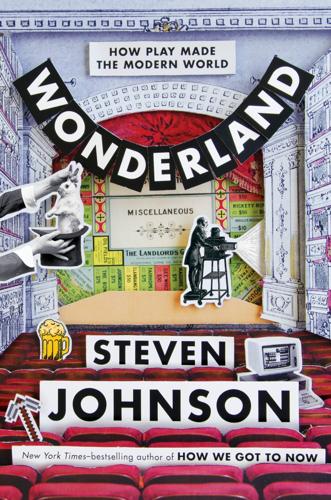
Wonderland: How Play Made the Modern World
by
Steven Johnson
Published 15 Nov 2016
One night, Horn and his colleagues were dining out at a steak house near IBM’s headquarters and noticed that all the restaurant patrons had suddenly gathered around the televisions at the bar. The crowd had assembled to watch Ken Jennings continue his legendary winning streak at the game show Jeopardy!, a streak that in the end lasted seventy-four episodes. Seeing that crowd forming planted the seed of an idea in Horn’s mind: Could IBM build a computer smart enough to beat Jennings at Jeopardy!? The system they eventually built came to be called Watson, named after IBM’s founder Thomas J. Watson. To capture as much information about the world as possible, Watson ingested the entirety of Wikipedia, along with more than a hundred million pages of additional data.
…
player, but I felt convinced that under the hood my brain was doing more or less the same thing. IBM, of course, has plans for Watson that extend far beyond Jeopardy!. Already Watson is being employed to recommend cancer treatment plans by analyzing massive repositories of research papers and medical data, and answer technical support questions about complex software issues. But still, Watson’s roots are worth remembering: arguably the most advanced form of artificial intelligence on the planet received its education by training for a game show. You might be inclined to dismiss Watson’s game-playing roots as a simple matter of publicity: beating Ken Jennings on television certainly attracted more attention for IBM than, say, Watson attending classes at Oxford would have.
…
From the data sources, and from software prompting by the IBM researchers, Watson developed a nuanced understanding of linguistic structures that let it parse and engage in less rigid conversations with humans. By the end of the process, Watson could understand and answer questions about just about anything in the world, particularly answers that relied on factual statements. And of course, given the Grand Challenge that had inspired its creation, Watson knew how to present those answers in the form of a question. In February of 2011, Watson competed in a special two-round Jeopardy! competition against Jennings and another Jeopardy! champion named Brad Rutter.

Machines of Loving Grace: The Quest for Common Ground Between Humans and Robots
by
John Markoff
Published 24 Aug 2015
She raised enough money, changed the company’s name from My Cybertwin to Cognea, and set up shop in both Silicon Valley and New York. In the spring of 2014, she sold her company to IBM. The giant computer firm followed its 1997 victory in chess over Garry Kasparov with a comparable publicity stunt in which one of its robots competed against two of the best human players of the TV quiz show Jeopardy! In 2011, the IBM Watson system triumphed over Brad Rutter and Ken Jennings. Many thought the win was evidence that AI technologies had exceeded human capabilities. The reality, however, was more nuanced. The human contestants could occasionally anticipate the brief window of time in which they could press the button and buzz in before Watson.
…
How will Watson be used? The choice faced by IBM and its engineers is remarkable. Watson can serve as an intelligent assistant to any number of professionals, or it can replace them. At the dawn of the field of artificial intelligence IBM backed away from the field. What will the company do in the future? Ken Jennings, the human Jeopardy! champion, saw the writing on the wall: “Just as factory jobs were eliminated in the 20th century by new assembly-line robots, Brad and I were the first knowledge-industry workers put out of work by the new generation of ‘thinking’ machines. ‘Quiz show contestant’ may be the first job made redundant by Watson, but I’m sure it won’t be the last.”23 7|TO THE RESCUE The robot laboratory was ghostly quiet on a weekend afternoon in the fall of 2013.
…
Artificial intelligence researchers like to point out that aircraft can fly just fine without resorting to flapping their wings—an argument that asserts that to duplicate human cognition or behavior, it is not necessary to comprehend it. However, the chasm between AI and IA has only deepened as AI systems have become increasingly facile at human tasks, whether it is seeing, speaking, moving boxes, or playing chess, Jeopardy!, or Atari video games. Terry Winograd was one of the first to see the two extremes clearly and to consider the consequences. His career traces an arc from artificial intelligence to intelligence augmentation. As a graduate student at MIT in the 1960s, he focused on understanding human language in order to build a software equivalent to Shakey—a software robot capable of interacting with humans in conversation.

Architects of Intelligence
by
Martin Ford
Published 16 Nov 2018
You need all these capabilities to participate in a dialogue, unless you tightly constrain what a person says and does; but that makes it very hard for people to actually do what they want to do! MARTIN FORD: What would you point to as being state-of-the-art right now? I was pretty astonished when I saw IBM Watson win at Jeopardy! I thought that was really remarkable. Was that as much of a breakthrough as it seemed to be, or would you point to something else as really being on the leading edge? BARBARA GROSZ: I was impressed by Apple’s Siri and by IBM’s Watson; they were phenomenal achievements of engineering. I think that what is available today with natural language and speech systems is terrific. It’s changing the way that we interact with computer systems, and it’s enabling us to get a lot done.
…
Another researcher later showed that newborns could do the same thing. MARTIN FORD: I know that you have a great interest in IBM’s Watson, and that it drew you back into the field of AI. Could you talk about why Watson reignited your interest in artificial intelligence? GARY MARCUS: I was skeptical about Watson, so I was surprised when it first won at Jeopardy in 2011. As a scientist, I’ve trained myself to pay attention to the things that I get wrong, and I thought natural language understanding was too hard for a contemporary AI to do. Watson should not be able to beat a human in Jeopardy, and yet it did. That made me start thinking about AI again I eventually figured out that the reason Watson won is because it was actually a narrower AI problem than it first appeared to be.
…
DAVID FERRUCCI I don’t think, as other people might, that we don’t know how to do [AGI] and we’re waiting for some enormous breakthrough. I don’t think that’s the case, I think we do know how to do it, we just need to prove that. FOUNDER, ELEMENTAL COGNITION DIRECTOR OF APPLIED AI, BRIDGEWATER ASSOCIATES David Ferrucci built and led the IBM Watson team from its inception to its landmark success in 2011 when Watson defeated the greatest Jeopardy! players of all time. In 2015 he founded his own company, Elemental Cognition, focused on creating novel AI systems that dramatically accelerate a computer’s ability to understand language. MARTIN FORD: How did you become interested in computers?

The Innovators: How a Group of Inventors, Hackers, Geniuses and Geeks Created the Digital Revolution
by
Walter Isaacson
Published 6 Oct 2014
“Their skill at manipulating and coaching their computers to look very deeply into positions effectively counteracted the superior chess understanding of their grandmaster opponents and the greater computational power of other participants,” according to Kasparov.22 In other words, the future might belong to people who can best partner and collaborate with computers. In a similar fashion, IBM decided that the best use of Watson, the Jeopardy!-playing computer, would be for it to collaborate with humans rather than try to top them. One project involved using the machine to work in partnership with doctors on cancer treatment plans. “The Jeopardy! challenge pitted man against machine,” said IBM’s Kelly. “With Watson and medicine, man and machine are taking on a challenge together—and going beyond what either could do on its own.”23 The Watson system was fed more than 2 million pages from medical journals and 600,000 pieces of clinical evidence, and could search up to 1.5 million patient records.
…
HotWired and Time Inc.’s Pathfinder become first major magazine publishers on Web. 1995 Ward Cunningham’s Wiki Wiki Web goes online. 1997 IBM’s Deep Blue beats Garry Kasparov in chess. 1998 Larry Page and Sergey Brin launch Google. 1999 Ev Williams launches Blogger. 2001 Jimmy Wales, with Larry Sanger, launches Wikipedia. 2011 IBM’s computer Watson wins Jeopardy! INTRODUCTION HOW THIS BOOK CAME TO BE The computer and the Internet are among the most important inventions of our era, but few people know who created them. They were not conjured up in a garret or garage by solo inventors suitable to be singled out on magazine covers or put into a pantheon with Edison, Bell, and Morse.
…
But it quickly became an object of consumer desire and teenage obsession. Its plastic case came, iPod-like, in four colors: black, ivory, Mandarin Red, and Cloud Gray. Within a year, 100,000 had been sold, making it one of the most popular new products in history.40 Suddenly everyone in America knew what a transistor was. IBM’s chief Thomas Watson Jr. bought a hundred Regency radios and gave them to his top executives, telling them to get to work using transistors in computers.41 More fundamentally, the transistor radio became the first major example of a defining theme of the digital age: technology making devices personal. The radio was no longer a living-room appliance to be shared; it was a personal device that allowed you to listen to your own music where and when you wanted—even if it was music that your parents wanted to ban.

Superminds: The Surprising Power of People and Computers Thinking Together
by
Thomas W. Malone
Published 14 May 2018
In Minsky’s view, a society of mind emerges from the interactions of many smaller “agents,” none of which is very intelligent as an individual but all of which, together, create an overall system that is intelligent.22 A hint of what this might look like comes from IBM’s Watson system. When Watson plays Jeopardy, the system makes use of thousands of smaller agents, many of which work in parallel on different processors.23 Each of these agents is more complex than a single human neuron, but none of them alone is nearly smart enough to be a competitive Jeopardy player. For instance, one of the questions Watson answered was “President under whom the U.S. gave full recognition to Communist China.” To answer this question, some of Watson’s agents went to work proposing the names of US presidents as possible answers.
…
So the combination of people and computers together can provide better service than either could alone. In a very different industry, the WatsonPaths software that IBM is developing in collaboration with Cleveland Clinic4 is also an automated assistant. Building on the same basic technology used in the version of Watson that beat the human champions of the TV game show Jeopardy!, WatsonPaths uses knowledge it has culled from the medical literature to identify multiple possible diagnoses that are consistent with a patient’s symptoms and medical history. Then, like the Stitch Fix software, the Watson system shows a number of plausible diagnoses to the doctors. It also shows the doctors the chain of reasoning it used and the degree of confidence it has for each of these different diagnoses.
…
But the clear statistical results in this project point the way toward a very intriguing possible future for truth-finding democracies. Perhaps instead of traditional democracies, we should have more sophisticated democracies where carefully designed algorithms combine the opinions of group members to produce much more accurate results. In fact, this is surprisingly similar to the basic architecture that IBM’s Watson system uses. As we saw in chapter 4, Watson includes many different computational agents, each with a different kind of expertise, producing evidence for or against different possible answers. Over time, machine-learning algorithms built into the system refine the weights they give to these “opinions” from the different agents.

The Future Is Faster Than You Think: How Converging Technologies Are Transforming Business, Industries, and Our Lives
by
Peter H. Diamandis
and
Steven Kotler
Published 28 Jan 2020
And the result of this relatively minor convergence—big data sets meeting cheap, potent GPUs—sparked one of the fastest invasions in history, with artificial intelligence starting to encroach on every facet of our lives. Machine learning emerged first, using algorithms to analyze data, learn from it, then make predictions about the world. This is Netflix and Spotify suggesting movies and music, but it’s also IBM’s Watson serving as a wealth manager. Next, neural networks came online. Inspired by the biology of the human brain, these nets are capable of unsupervised learning from unstructured data. You no longer need to feed AI information one piece at a time. With neural nets, simply unleash them on the internet and the system will do the rest.
…
If they’re an early adopter, the AI alerts the sales agent to offer them the latest and greatest. If they’re more conservative, then it suggests items more tried-and-true. Second, there are companies like New Zealand’s Soul Machines working to replace human customer service agents altogether. Powered by IBM’s Watson, Soul Machines builds lifelike customer service avatars designed for empathy, making them one of many helping to pioneer the field of emotionally intelligent computing. We’ll explore this in depth a little later, but what’s critical here is a single stat: 40 percent. With their technology, 40 percent of all customer service interactions are now resolved with a high degree of satisfaction and without any human intervention.
…
In June of 2016, the extremely eerie short film Sunspring was released online, the end result of a neural net–powered AI being fed hundreds of sci-fi film scripts and allowed to take a crack at writing one of its own. Two months later, Twentieth Century Fox debuted the trailer for the upcoming thriller Morgan, also created with the help of an AI—this time, IBM’s Watson. To pull this off, Watson “watched” trailers for a hundred horror movies, then conducted visual, audio, and composition analysis to understand what humans deemed scary. By applying this same kind of analysis to Morgan, the AI identified the film’s critical moments. Although a human was needed to arrange those moments into a coherent order, Watson reduced the amount of time it takes to make a trailer from ten days to one.
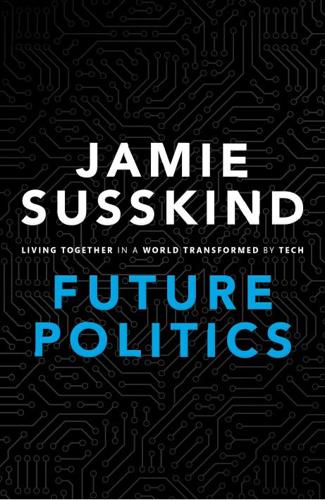
Future Politics: Living Together in a World Transformed by Tech
by
Jamie Susskind
Published 3 Sep 2018
‘I . . . was able to get one single win,’ said Lee Sedol rather poignantly; ‘I wouldn’t exchange it for anything in the world.’16 OUP CORRECTED PROOF – FINAL, 26/05/18, SPi РЕЛИЗ ПОДГОТОВИЛА ГРУППА "What's News" VK.COM/WSNWS 32 FUTURE POLITICS A year later, a version of AlphaGo called AlphaGo Master thrashed Ke Jie, the world’s finest human player, in a 3–0 clean sweep.17 A radically more powerful version now exists, called AlphaGo Zero. AlphaGo Zero beat AlphaGo Master 100 times in a row.18 As long ago as 2011, IBM’s Watson vanquished the two all-time greatest human champions at Jeopardy!—a TV game show in which the moderator presents general knowledge ‘answers’ relating to sports, science, pop culture, history, art, literature, and other fields and the contestants are required to provide the ‘questions’. Jeopardy! demands deep and wide-ranging knowledge, the ability to process natural language (including wordplay), retrieve relevant information, and answer using an acceptable form of speech—all before the other contestants do the same.19 The human champions were no match for Watson, whose victory marked a milestone in the development of artificial intelligence.
…
This was a system that could answer questions ‘on any topic under the sun . . . more accurately and quickly than the best human beings’.20 The version of Watson used on Jeopardy! was said to be the size of a bedroom; by the early 2020s it’s expected that the same technology, vastly improved, will sit comfortably in a smartphone-sized computer.21 Today, what IBM calls ‘Watson’ no longer exists in a single physical space but is distributed across a cloud of servers that can be accessed by commercial customers on their computers and smartphones.22 As IBM is keen to stress, different versions of Watson do more than win game shows. In late 2016, one Watson platform discovered five genes linked to amyotrophic lateral sclerosis (ALS), a degenerative disease that can lead to paralysis and death.
…
OUP CORRECTED PROOF – FINAL, 30/05/18, SPi РЕЛИЗ ПОДГОТОВИЛА ГРУППА "What's News" VK.COM/WSNWS Notes 19. 20. 21. 22. 23. 24. 25. 26. 27. 28. 29. 30. 31. 32. 33. 34. 35. 36. 373 Susskind and Susskind, Future of the Professions, 165. Ibid. Ibid. Kevin Kelly, The Inevitable: Understanding the 12 Technological Forces that Will Shape Our Future (New York:Viking, 2016), 31. Emma Hinchliffe, ‘IBM’s Watson Supercomputer Discovers 5 New Genes Linked to ALS’, Mashable UK, 14 December 2016 <http:// mashable.com/2016/12/14/ibm-watson-als-research/?utm_ cid=mash-com-Tw-tech-link%23sd613jsnjlqd#HJziN5r0aGq5> (accessed 28 November 2017). Murray Shanahan, The Technological Singularity (Cambridge, Mass: MIT Press, 2015), 12. BBC, ‘Google Working on “Common-Sense” AI Engine at New Zurich Base’, BBC News, 17 June 2016 <http://www.bbc.co.uk/news/ technology-36558829> (accessed 30 November 2017); Blue Brain Project <https://bluebrain.epfl.ch/page-56882-en.html> (accessed 6 December 2017).
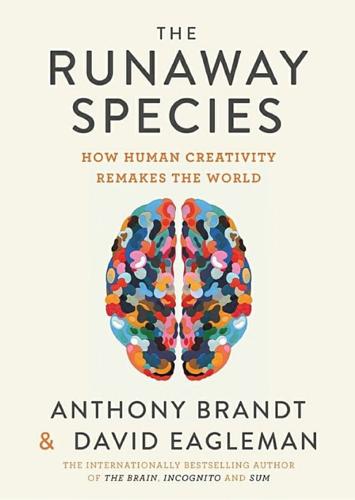
The Runaway Species: How Human Creativity Remakes the World
by
David Eagleman
and
Anthony Brandt
Published 30 Sep 2017
. © 2016 Estate of Pablo Picasso / Artists Rights Society (ARS), New York Max Kulich’s sketches for the Audi CitySmoother Courtesy of Max Kulich The Architectural Reseasrch Office’s sketches for the Flea Theater in New York Courtesy of Architectural Research Office Joshua Davis’ skethes for IBM Watson Courtesy of Joshua Davis IBM Watson on the Jeopardy set Courtesy of Sony Pictures Television Advent, Thunderbird, Starchaser, Ascender, and Proteus Courtesy of the Ansari X-Prize Scaled Composite’s SpaceShipOne Courtesy of the Ansari X-Prize Chapter 9 Einstein blouses https://www.google.com/patents/USD101756 Sarah Burton: Kate Middleton wedding dress Photo by Kirsty Wigglesworth – WPA Pool/Getty Images Sarah Burton: three dresses from the Autumn/Winter 2011-12 Alexander McQueen ready-to-ware collection Photo by Francois Guillot, AFP, Getty Images Norman Bel Geddes: Motor Coach no. 2, Roadable Airplane, Aerial Restaurant and Walless House Courtesy of the Harry Ransom Center, the University of Texas at Austin © The Edith Lutyens and Norman Bel Geddes Foundation, Inc.
…
In a book review titled “The Descent of Edward Wilson,” Richard Dawkins, one of Wilson’s most prestigious peers, was unsparing in his criticism: “I’m reminded of the old Punch cartoon where a mother beams down on a military parade and proudly exclaims, ‘There’s my boy, he’s the only one in step.’ Is Wilson the only evolutionary biologist in step?”10 But being out of step with his colleagues didn’t bother Wilson. Others were amazed that such a venerated figure, the winner of two Pulitzer Prizes, would put his standing in the field in jeopardy. But Wilson, a practiced innovator, was not afraid to radically change his views to match where the science led him – even if it meant overturning his own legacy. The jury is still out on the veracity of Wilson’s proposal (it may turn out to be incorrect), but, right or wrong, there are no pieces that he considers glued into place. *** Humankind constantly renews itself by breaking good: rotary phones turn into push button phones, which turn into brick-like cellphones, then flip-phones, then smartphones.
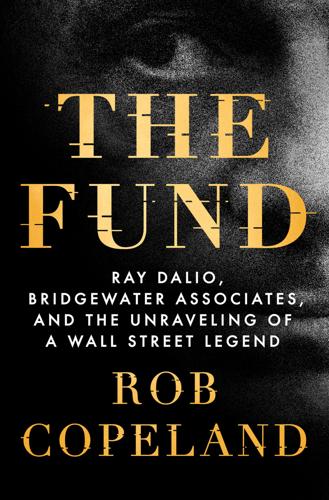
The Fund: Ray Dalio, Bridgewater Associates, and the Unraveling of a Wall Street Legend
by
Rob Copeland
Published 7 Nov 2023
It had taken more than twenty years and nearly fifty different iterations to get Siri off the ground, and Jensen didn’t intend to wait nearly that long for Prince. He helped bring in the famed computer scientist David Ferrucci for the project. Ferrucci was as close to a celebrity as there could be in artificial intelligence. He had worked at IBM and led the team that created Watson, a question-answering computer system that successfully competed on the quiz show Jeopardy! Ferrucci said publicly that he was enthuasiastic to join Bridgewater to help on macroeconomic modeling, i.e., to help predict the direction of markets. This made perfect sense; any other hedge fund would gladly have put Ferrucci to work on investments, deploying his talents to making money for the firm’s clients.
…
Canner offered an extended thank-you for the gift. Dalio responded, “As I always say, the best gift anyone can receive is knowledge of their own weaknesses.” * * * THE EVIDENT certainty with which Dalio held his measurements of others’ weaknesses was not shared by everyone else. David Ferrucci, the former IBM scientist and inventor of Watson, had set up his Bridgewater laboratory, now more than two years old, with security approaching that of a CIA black site. Ferrucci’s Systematized Intelligence Lab was walled off, literally, from the rest of the hedge fund’s operations, behind locked doors. Few who weren’t a part of his group were let in, and almost no one else at the hedge fund had a clue what was happening there.
…
More broadly, Ferrucci hoped to be able to train a computer to read or listen to a passage of text, and to realize that if certain words were used in a certain order, the topic at hand dealt with one Principle or another. If the scientists could nail the method, they could essentially create a computerized version of Dalio himself.* The goal proved elusive. Few of the theories seemed to work. The inventor of IBM Watson, who had trained a computer to answer trivia on any topic of the world, couldn’t make heads or tails of Dalio’s thought process. Ferrucci’s team could produce no obvious, predictive pattern to when the Bridgewater founder would bring up one Principle or another. The employee ratings, or dots, had equally little evidence of logic.

Homo Deus: A Brief History of Tomorrow
by
Yuval Noah Harari
Published 1 Mar 2015
Similarly, no doctor can be familiar with every illness and drug, or read every new article published in every medical journal. To top it all, the doctor is sometimes tired or hungry or perhaps even sick, which affects her judgement. No wonder that doctors often err in their diagnoses, or recommend a less-than-optimal treatment. Now consider IBM’s famous Watson – an artificial intelligence system that won the Jeopardy! television game show in 2011, beating human former champions. Watson is currently groomed to do more serious work, particularly in diagnosing diseases. An AI such as Watson has enormous potential advantages over human doctors. Firstly, an AI can hold in its databanks information about every known illness and medicine in history.
…
Firstly, an AI can hold in its databanks information about every known illness and medicine in history. It can then update these databanks every day, not only with the findings of new researches, but also with medical statistics gathered from every clinic and hospital in the world. IBM’s Watson defeating its two humans opponents in Jeopardy! in 2011. © Sony Pictures Television. Secondly, Watson can be intimately familiar not only with my entire genome and my day-to-day medical history, but also with the genomes and medical histories of my parents, siblings, cousins, neighbours and friends. Watson will know instantly whether I visited a tropical country recently, whether I have recurring stomach infections, whether there have been cases of intestinal cancer in my family or whether people all over town are complaining this morning about diarrhoea.
…
Munoz-Organero, ‘Enhancement of Student Learning Through the Use of a Hinting Computer e-Learning System and Comparison With Human Teachers’, IEEE Transactions on Education 54:1 (2011), 164–7; Mindojo, accessed 14 July 2015, http://mindojo.com/. 8. Steiner, Automate This, 146–62; Ian Steadman, ‘IBM’s Watson Is Better at Diagnosing Cancer than Human Doctors’, Wired, 11 February 2013, accessed 22 December 2014, http://www.wired.co.uk/news/archive/2013-02/11/ibm-watson-medical-doctor; ‘Watson Is Helping Doctors Fight Cancer’, IBM, accessed 22 December 2014, http://www-03.ibm.com/innovation/us/watson/watson_in_healthcare.shtml; Vinod Khosla, ‘Technology Will Replace 80 per cent of What Doctors Do’, Fortune, 4 December 2012, accessed 22 December 2014, http://tech.fortune.cnn.com/2012/12/04/technology-doctors-khosla; Ezra Klein, ‘How Robots Will Replace Doctors’, Washington Post, 10 January 2011, accessed 22 December 2014, http://www.washingtonpost.com/blogs/wonkblog/post/how-robots-will-replace-doctors/2011/08/25/gIQASA17AL_blog.html. 9.

Artificial Unintelligence: How Computers Misunderstand the World
by
Meredith Broussard
Published 19 Apr 2018
The Internet was the popular thing technologically, then mobile devices, and those were the focus of our collective imagination. In the middle of the 2010s, however, people started talking about machine learning. Suddenly, AI was on fire again. AI startups were founded and acquired. IBM’s Watson beat a human player at Jeopardy!; an algorithm outfoxed a human player at playing Go. Even the words machine learning were cool. A machine could learn! The promise was delivered! At first, I wanted to believe that some genius had figured out the truly hard problem of making a machine think—but when I looked closer, it turned out that the reality was far more nuanced.
…
He looked confused and a little disappointed. “So, it’s not real AI?” he asked. “Oh, it’s real,” I said. “And it’s spectacular. But you know, don’t you, that there’s no simulated person inside the machine? Nothing like that exists. It’s computationally impossible.” His face fell. “I thought that’s what AI meant,” he said. “I heard about IBM Watson, and the computer that beat the champion at Go, and self-driving cars. I thought they invented real AI.” He looked depressed. I realized he’d been looking at the laptop because he thought there was something in there—a “real” ghost in the machine. I felt terrible for having burst his bubble, so I steered the conversation toward a neutral topic—an upcoming Star Wars movie—to cheer him up.
…
There’s also open innovation, in which people from outside a company develop new tools or products for a variety of altruistic or self-interested reasons.2 Then there’s the innovation competition, in which a company announces a challenge and offers a bounty for the best product or solution. The iconic example of this is the DARPA Grand Challenge, the robot car race in which the winner was offered $2 million, and which I wrote about in chapter 8. Incidentally, $1 million is the bounty offered on the game show Survivor, which has nothing to do with tech and very little to do with innovation, but which requires surviving elimination challenges on a tropical island with very little food or water, among a group of scheming strangers. For thirty-nine days. On camera. Would the Startup Bus be like Survivor, but with computers and on a moving bus?
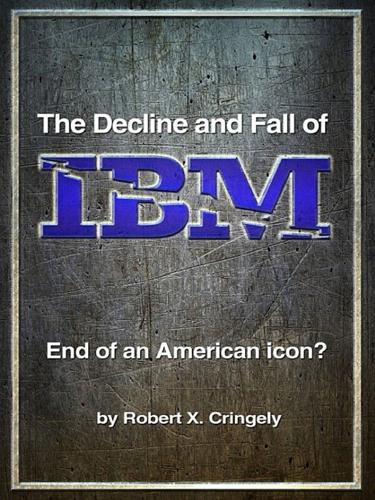
The Decline and Fall of IBM: End of an American Icon?
by
Robert X. Cringely
Published 1 Jun 2014
After years of corporate downsizing, employee morale is at an all-time low. Bonuses and even annual raises are rare. But for all that, IBM is still an enormous multinational corporation with high profits, deep pockets, and grand ambitions for new technical initiatives in cloud computing, Big Data analytics, and artificial intelligence as embodied in the company’s Jeopardy game-show-winning Watson technology. Yet for all this, IBM seems to have lost some of its mojo, or at least that’s what Wall Street and the business analysts are starting to think. Just starting to think? The truth is that IBM is in deep trouble and has been since before the Great Recession of 2008.
…
My father was a natural scrounger, and using all the cool crap he dragged home from who knows where, I decided to base my voice control work on the amplitude modulation optical sound track technology from 16mm film (we had a projector). If I could paint optical tracks to represent commands then all I’d need was some way of characterizing and analyzing those tracks to tell the computer what to do. But the one thing I didn’t have down in the lab in 1961 was a computer. That’s what took me to IBM. I wrote a letter to IBM CEO T.J. Watson, Jr., pecking it out on an old Underwood manual typewriter. My proposal was simple: a 50/50 partnership between IBM and me to develop and exploit advanced user interface technologies. In a few days I received a letter from IBM. I don’t know if it was from Watson, himself, because neither my parents nor I thought to keep the letter.
…
We can all hope their assistance will not have been in vain. CHAPTER ONE Good Old IBM Few of us actually live in the present. Our minds are often in the recent past where judgments are formed and go for long periods of time unchallenged. That’s why the IBM nearly everyone thinks of is the IBM of the Watsons, father and son. That IBM—of the 1960s and 1970s—was less a company than it was a country. In some ways it still is. IBM has a greater gross national product than most countries. It has some 430,000 workers. Throw in spouses and their kids and we’re looking at well over a million citizens of IBM.
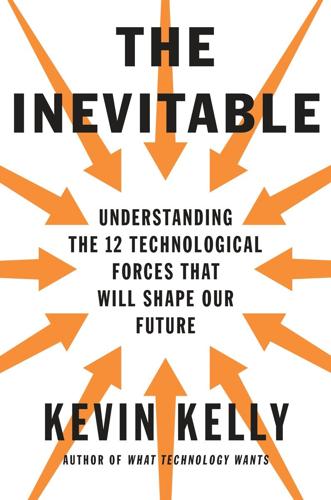
The Inevitable: Understanding the 12 Technological Forces That Will Shape Our Future
by
Kevin Kelly
Published 6 Jun 2016
Like many parents of a bright mind, IBM would like Watson to pursue a medical career, so it should come as no surprise that the primary application under development is a medical diagnosis tool. Most of the previous attempts to make a diagnostic AI have been pathetic failures, but Watson really works. When, in plain English, I give it the symptoms of a disease I once contracted in India, it gives me a list of hunches, ranked from most to least probable. The most likely cause, it declares, is giardia—the correct answer. This expertise isn’t yet available to patients directly; IBM provides Watson’s medical intelligence to partners like CVS, the retail pharmacy chain, helping it develop personalized health advice for customers with chronic diseases based on the data CVS collects.
…
He was able to mathematically optimize results from each layer so that the learning accumulated faster as it proceeded up the stack of layers. Deep-learning algorithms accelerated enormously a few years later when they were ported to GPUs. The code of deep learning alone is insufficient to generate complex logical thinking, but it is an essential component of all current AIs, including IBM’s Watson; DeepMind, Google’s search engine; and Facebook’s algorithms. This perfect storm of cheap parallel computation, bigger data, and deeper algorithms generated the 60-years-in-the-making overnight success of AI. And this convergence suggests that as long as these technological trends continue—and there’s no reason to think they won’t—AI will keep improving.
…
Siri, the audio phone assistant for the iPhone, delivers spoken answers when you ask her a question in natural English. I use Siri routinely. When I want to know the weather, I just ask, “Siri, what’s the weather for tomorrow?” Android folks can audibly ask Google Now for information about their calendars. IBM’s Watson proved that for most kinds of factual reference questions, an AI can find answers fast and accurately. Part of the increasing ease in providing answers lies in the fact that past questions answered correctly increase the likelihood of another question. At the same time, past correct answers increase the ease of creating the next answer, and increase the value of the corpus of answers as a whole.
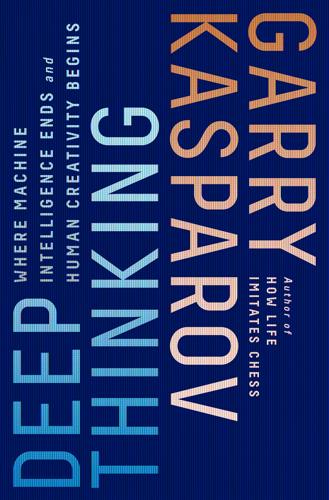
Deep Thinking: Where Machine Intelligence Ends and Human Creativity Begins
by
Garry Kasparov
Published 1 May 2017
In 2014, I got an interesting response to this assertion. I had been invited to speak at the headquarters of the world’s largest hedge fund in Connecticut, Bridgewater Associates. In a revealing turn of events, they had hired Dave Ferrucci, one of the creators of the IBM artificial intelligence project Watson, famous for its triumphs on the American television quiz show Jeopardy. Ferrucci sounded disillusioned by IBM’s focus on a data-driven approach to AI, and how it wanted to exploit the impressive Watson and its sudden celebrity by turning it into a commercial product as quickly as possible. He had been working on more sophisticated “paths” that aimed at explaining the “why” of things, not only finding useful correlations via data mining.
…
As with a chess engine crunching through billions of positions to find the best move, language can be broken down into values and probabilities to produce a response. The faster the machine, the more and better quality the data, and the smarter the code, the more accurate the response is likely be. Adding a bit of irony regarding whether or not computers can ask questions, the format of the television game show Jeopardy, where Watson showed off its capabilities by defeating two human former champions, requires contestants to provide their answers in the form of a question. That is, if the show’s host says, “This Soviet program won the first World Computer Chess Championship in 1974,” the player would press the buzzer and answer, “What was Kaissa?”
…
These investigations led to visits to places like Google, Facebook, and Palantir, companies for whom algorithms are lifeblood. There have also been some more surprising invitations, including one from the headquarters of the world’s largest hedge fund, where algorithms make or lose billions of dollars every day. There I met one of the creators of Watson, the Jeopardy-playing computer that could be called IBM’s successor to Deep Blue. Another trip was to participate in a debate in front of an executive banking audience in Australia on what impact AI was likely to have on jobs in their industry. Their interests are quite different, but they all want to be on the cutting edge of the machine intelligence revolution, or at least to not be cut by it.
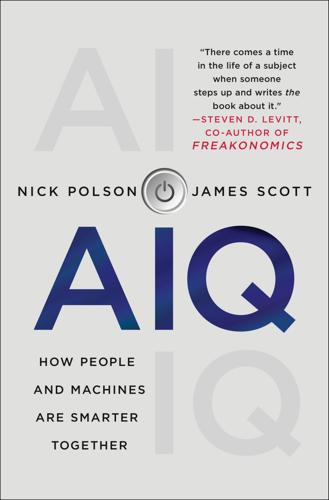
AIQ: How People and Machines Are Smarter Together
by
Nick Polson
and
James Scott
Published 14 May 2018
And the running joke among AI experts is that if Stanley Kubrick had made his film 2001: A Space Odyssey today, then the conversation between Dave and the malevolent supercomputer HAL-9000 might have gone like this: Dave Open the pod bay doors, HAL. HAL I’ve searched the web and found some results for iPods, Dave. Would you like to see them? Machines make subtler errors, too. IBM’s Watson supercomputer was once put through a rhyming test ahead of his big match against human contestants on Jeopardy! One test clue was “a boxing term for a hit below the belt.” The right rhyming response was “low blow”—but Watson answered “wang bang,” a phrase that did not appear in his database and that he must have conceived on his own. So go ahead, pile on the insults.
…
Or of staring into the camera to allow an algorithm in the cloud to scan your eyes for symptoms of eye disease. Now think of putting those algorithms together with something like Dr. Alexa: a digital assistant trained on vast troves of medical knowledge that’s been programmed to ask questions about your symptoms and respond appropriately. (IBM’s Watson team has already developed something very much like this for the purpose of training medical students.51) A new generation of wearable sensors could boost the effectiveness of AI-based remote medicine even further. If you think your Fitbit is cool, wait until the first person in your office gets a biometric e-tattoo: a small wearable patch, with the same thickness and elasticity as human skin, that can send health data wirelessly to your phone.
…
See also Lee Bell, “Nvidia to Train 100,000 Developers in ‘Deep Learning’ AI to Bolster Healthcare Research,” Forbes.com, May 11, 2017, https://www.forbes.com/sites/leebelltech/2017/05/11/nvidia-to-train-100000-developers-in-deep-learning-ai-to-bolster-health-care-research/. 50. See, e.g., Tom Simonite, “The Recipe for the Perfect Robot Surgeon,” MIT Technology Review, October 14, 2016, https://www.technologyreview.com/s/602595/the-recipe-for-the-perfect-robot-surgeon/. 51. David Szondy, “IBM’s Watson Adapted to Teach Medical Students and Aid Diagnosis,” New Atlas, October 21, 2013, http://newatlas.com/ibm-supercomputer-watsonpath/29415/. CHAPTER 7 1. Chris Anderson, “The End of Theory: The Data Deluge Makes the Scientific Method Obsolete,” Wired, June 23, 2008, https://www.wired.com/2008/06/pb-theory/. 2.
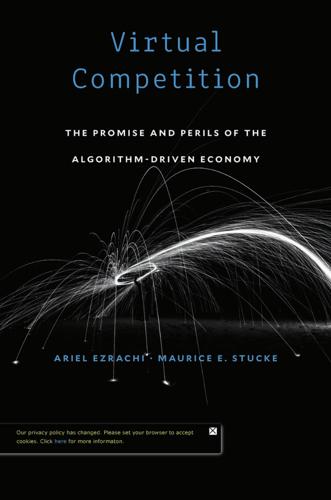
Virtual Competition
by
Ariel Ezrachi
and
Maurice E. Stucke
Published 30 Nov 2016
See also Robert McMillan, “IBM Turns Up Heat Under Competition in Artificial Intelligence,” Wall Street Journal, November 24, 2015, http://www.wsj.com /articles/ibm-turns-up-heat-under-competition-in-artificial-intelligence -1448362800. Jo Best, Jo. “IBM Watson: The Inside Story of How the Jeopardy-Winning Supercomputer Was Born, and What It Wants to Do Next,” TechRepublic (2013), http://www.techrepublic.com/article/ibm-watson-the-inside-story-of -how-the-jeopardy-winning-supercomputer-was-born-and-what-it-wants-to -do-next/. Steve Lohr, “IBM’s AI System Watson to Get Second Home, on West Coast,” New York Times, September 24, 2015, http://www.nytimes.com/2015/09/25 Notes to Page 16 41. 42. 43. 44. 45. 46. 47. 259 /technology/ibms-ai-system-watson-to-get-new-west-coast-home.html ?smprod=nytcore-iphone&smid=nytcore-iphone-share& _r = 0.
…
As the European Data Protection Supervisor observed, “Deep learning computers teach themselves tasks by crunching large data sets using (among other things) neural networks that appear to emulate the brain.”46 The algorithms’ capacity to learn increases as they process more relevant data.47 The belief is that simple algorithms with lots of data will eventually outperform sophisticated algorithms with little data.48 Part of this is due to the opportunity for algorithms to learn through trial and error. Another is seeing correlations from big data sets. Thus one thing IBM’s Watson and artificial intelligence (AI) generally need in order to “do meaningful work” is data.49 That is why IBM acquired the digital and data assets of Weather Co., owner of the Weather Channel. Watson could analyze the volume of weather data to refine its algorithms.50 Watson’s ser vices, in turn, can be sold to other parties, like insurance apps.
…
Tereza Pultarova, “Jaguar Land Rover to Lead Driverless Car Research,” E&T (October 9, 2015), http://eandt.theiet.org /news/2015/oct /jaguar-land -rover-driverless-cars.cfm; David Talbot, “CES 2015: Nvidia Demos a Car Computer Trained with ‘Deep Learning,’ ” MIT Technology Review, January 6, 2015), http://www.technologyreview.com /news/533936/ces-2015 -nvidia-demos-a-car-computer-trained-with-deep-learning /; David Levitin, 2015. “The Sum of Human Knowledge,” Wall Street Journal, September 18, 2015, http://www.wsj.com /articles/the-sum-of-human -knowledge-1442610803. Lohr, “IBM’s AI System Watson to Get Second Home.” European Data Protection Supervisor, Towards a New Digital Ethics. Take, for example, the Rubicon Project, “a leading technology company automating the buying and selling of advertising.” As its website notes, “Relentless in its efforts for innovation, Rubicon Project has engineered one of the largest real-time cloud and Big Data computing systems, processing trillions of transactions within milliseconds each month”; Rubicon Project. (2016), http://rubiconproject.com/whoweare/.
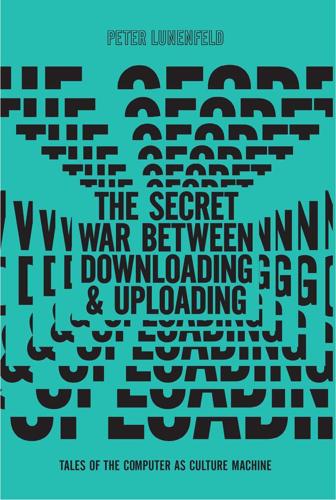
The Secret War Between Downloading and Uploading: Tales of the Computer as Culture Machine
by
Peter Lunenfeld
Published 31 Mar 2011
By 1915, a young salesman named Thomas J. Watson had risen from a regional office to take over the company, then named the Computer Tabulating Recording Corporation. Within a decade, he had changed the name of the company to the International Business Machines Corporation, and encouraged the use of its acronym, IBM. Watson Sr.’s famous motto was “Think,” but the driving ethos of the company was “Sell.” In an era when the art of selling was 153 GENERATIONS revered as being next to godliness, Watson was known as the world’s greatest salesman (as well as being one of the world’s richest people).12 Watson Sr. understood that IBM had to keep its eye on computers and help to shape their future.
…
Should they invest in digital computing, or would this undercut the profits on their flagship mechanical calculators and paper card tabulating machines? Watson Sr.’s contribution was essentially to hand over the company to his son at the very moment when this decision became central to IBM’s fortunes. In so doing, Watson Sr. ensured that the computer would make it out of the laboratory and into businesses worldwide, with the huge infrastructure of sales and support that IBM had already built up during the prewar years and the postwar boom. It was to Thomas J. Watson Jr.’s credit that he negotiated the smooth transition between the two regimes at IBM.
…
But setting the bar too high is preferable to not setting the bar at all. Fifty years ago, the categorizing of meaning was considered to be one of—if not the—chief calling of the critic. The advent of critical theories like poststructuralism, deconstruction, and postmodernism put many of the classic categories 29 CHAPTER 2 in jeopardy: building a canon around the good and the beautiful was “problematized,” high and low ceased to function as viable categories for culture, and progress and truth were discussed as creations of power struggles rather than immutables in the human condition. Theory with a capital T practiced a brilliant negative dialectics, but did not always replace the overthrown concepts with new, more congenial ones.
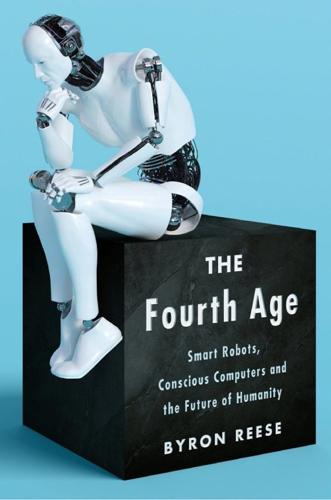
The Fourth Age: Smart Robots, Conscious Computers, and the Future of Humanity
by
Byron Reese
Published 23 Apr 2018
The more you increase your mastery of an ever-smaller domain, the easier it is to instantiate that knowledge in a computer program. A hunter-gatherer is much harder to build a computer replacement for than an X-ray technician, because the technician does just one narrow thing. Ken Jennings, who was famously beaten on Jeopardy! by IBM’s Watson, explains that during that whole experience, the folks at IBM maintained a line graph that showed Watson’s progress on its quest to the dot labeled “Ken Jennings.” Every week, Watson kept inching ever closer. In his TED talk, Jennings explains how it all made him feel: And I saw this line coming for me.
…
And Turing not only conceived of the machine but figured all this out. Consider that simple machine, that thought experiment with just a handful of parts: Everything Apollo 11 needed to do to make it to the moon and back could be programmed on a Turing Machine. Everything your smartphone can do can be programmed on a Turing machine, and everything IBM Watson can do can be programmed on a Turing machine. Who could have guessed that such a humble little device could do all that? Well, Turing could, of course. But no one else seems to have had that singular idea. Exit Turing. Enter John von Neumann, whom we call the father of modern computing. In 1945, he developed the von Neumann architecture for computers.
…
In his TED talk, Jennings explains how it all made him feel: And I saw this line coming for me. And I realized, this is it. This is what it looks like when the future comes for you. It’s not the Terminator’s gunsight; it’s a little line coming closer and closer to the thing you can do, the only thing that makes you special, the thing you’re best at. Playing Jeopardy! is one narrow thing. Well, actually a few narrow things. And that’s why today’s AI can master it. So far, we have just been exploring the cognitive technical challenges of AI robots. Let’s look now at the equally formidable physical challenges. The physical world is a difficult place for an AI robot unless it is performing purely repetitive motions inside a controlled environment, such as a factory floor.

Futureproof: 9 Rules for Humans in the Age of Automation
by
Kevin Roose
Published 9 Mar 2021
In the twentieth century, “process optimization” tools were used to squeeze extra efficiency out of manufacturing workers, and workers in the service industry have decades of experience with “dynamic scheduling” software like Kronos, which is used to set workers’ shifts based on a business’s predicted staffing needs. But AI and machine learning have made it possible to outsource even higher-level management tasks to machines. Amazon uses complex algorithms to track the productivity of its warehouse workers, and can reportedly even automatically generate the paperwork required to fire underperformers. IBM has used Watson, its AI platform, in employee performance reviews—meaning that your bonus might be determined not simply by how you did last year, but by how the algorithm predicts you’ll do next year. On-demand platforms like Uber and Lyft have dispensed with the idea of human supervision altogether, putting decisions like pay, dispatching, and dispute resolution in the hands of algorithms.
…
Every weekday, Conor Sprouls Kevin Roose, “A Machine May Not Take Your Job, but One Could Become Your Boss,” New York Times, June 23, 2019. Amazon uses complex algorithms to track the productivity Colin Lecher, “How Amazon Automatically Tracks and Fires Warehouse Workers for ‘Productivity,’ ” The Verge, April 25, 2019. IBM has used Watson, its AI platform Tristan Greene, “IBM Is Using Its AI to Predict How Employees Will Perform,” TheNextWeb, July 10, 2018. Percolata, a Silicon Valley start-up Hazel Sheffield, “The Great Data Leap: How AI Will Transform Recruitment and HR,” Financial Times, November 4, 2019. The company, whose clients include Sweetgreen and OfferUp Daisuke Wakabayashi, “Firm Led by Google Veterans Uses AI to ‘Nudge’ Workers Toward Happiness,” New York Times, December 31, 2018.
…
Shane, who expanded AI Weirdness into a book Janelle Shane, You Look Like a Thing and I Love You (New York: Headline, 2019). A trading firm called Knight Capital, for example Nathaniel Popper, “Knight Capital Says Trading Glitch Cost It $440 Million,” New York Times, August 2, 2012. In 2018, internal tests obtained Casey Ross and Ike Swetlitz, “IBM’s Watson Supercomputer Recommended ‘Unsafe and Incorrect’ Cancer Treatments, Internal Documents Show,” Stat, July 25, 2018. decades of systematic overpolicing Rashida Richardson, Jason M. Schultz, and Kate Crawford, “Dirty Data, Bad Predictions: How Civil Rights Violations Impact Police Data, Predictive Policing Systems, and Justice,” New York University Law Review, Online Feature (2019).

Our Final Invention: Artificial Intelligence and the End of the Human Era
by
James Barrat
Published 30 Sep 2013
After Siri translates your query into text, its three other main talents come into play: its NLP facility, searching a vast knowledge database, and interacting with Internet search providers, such as OpenTable, Movietickets, and Wolfram|Alpha. IBM's Watson is kind of a Siri on steroids, and a champion at NLP. In February 2011, it employed both brain-derived and brain-inspired systems to achieve an impressive victory against human contestants on Jeopardy! Like chess champion computer Deep Blue, Watson is IBM’s way of showing off its computing know-how while moving the ball down the field for AI. The long-running game show promised a formidable challenge because of its open domain of clues and its wordplay. Contestants must understand puns, similes, and cultural references, and they must phrase answers in the form of questions.
…
And since it cannot see or feel, it cannot read, so during the competitions the words of the Jeopardy! clues were hand-entered by Watson’s pit crew. And since Watson cannot hear either, audio and video clues were omitted. Hey, wait a minute, did Watson really win at Jeopardy! or a custom-tailored variation? Since its victory, to get Watson to understand what people say, IBM has paired it with Nuance speech recognition technology. And Watson is reading terabytes of medical literature. One of IBM’s goals is to shrink Watson down from its present size—a roomful of servers—to refrigerator-size and make it the world’s best medical diagnostician.
…
Chapter Twelve The Last Complication How can we be so confident that we will build superintelligent machines? Because the progress of neuroscience makes it clear that our wonderful minds have a physical basis, and we should have learned by now that our technology can do anything that’s physically possible. IBM’s Watson, playing Jeopardy! as skillfully as human champions, is a significant milestone and illustrates the progress of machine language processing. Watson learned language by statistical analysis of the huge amounts of text available online. When machines become powerful enough to extend that statistical analysis to correlate language with sensory data, you will lose a debate with them if you argue that they don’t understand language.

MegaThreats: Ten Dangerous Trends That Imperil Our Future, and How to Survive Them
by
Nouriel Roubini
Published 17 Oct 2022
Their study, published in 2013, determined that 47 percent of jobs in America were highly vulnerable to substitution by computer capital in the near future. During the Great Depression, 25 percent of Americans were out of work.11 Unlike board games that adhere to strict rules, the television game show Jeopardy! features puns, slang, red herrings, vernacular, mischievous wordplay, and obscure associations to elicit factual knowledge on topics from pop culture to the esoteric. No human competitor outperformed erstwhile computer programmer and trivia whiz Ken Jennings, who won Jeopardy! seventy-four times, a legendary streak. Under intense pressure, with the speed of a Google search, he named, for instance, the leader whose brother is believed to be the first known European to have died in the Americas and the disease that prompted US surgeon general Walter Wyman to establish a hospital in Hawaii in 1901 (answers: “Who is Leif Erikson?”
…
Under intense pressure, with the speed of a Google search, he named, for instance, the leader whose brother is believed to be the first known European to have died in the Americas and the disease that prompted US surgeon general Walter Wyman to establish a hospital in Hawaii in 1901 (answers: “Who is Leif Erikson?” and “What is leprosy?”). Jennings, though, was no match for AI. By his own account in a 2013 TED Talk, IBM’s Watson defeated him handily. He commiserated with Detroit factory workers who became obsolete when robots took their jobs. “I’m not an economist,” Jennings said. “All I know is how it felt to be the guy put out of work and it was freaking demoralizing. It was terrible,” he recalled. “Here’s the one thing that I was ever good at and all it took was IBM pouring tens of millions of dollars and its smartest people and thousands of processors working in parallel and they could do the same thing.
…
“Here’s the one thing that I was ever good at and all it took was IBM pouring tens of millions of dollars and its smartest people and thousands of processors working in parallel and they could do the same thing. They could do it a little bit faster and a little better on national TV and I’m sorry Ken, we don’t need you anymore.” He began to wonder, Where would digital outsourcing of jobs stop? “I felt like a quiz show contestant was now the first job that had become obsolete under this new regime of thinking computers and it hasn’t been the last.”12 The philosopher Friedrich Nietzsche envisioned upheaval a century before personal computers arrived. “Every step forward,” he warned in The Genealogy of Morals, “is made at the cost of mental and physical pain to someone.”

System Error: Where Big Tech Went Wrong and How We Can Reboot
by
Rob Reich
,
Mehran Sahami
and
Jeremy M. Weinstein
Published 6 Sep 2021
It was not until 1994 that a computer program could defeat the human world checkers champion. Then, in 1997, front-page stories in newspapers around the world announced that IBM’s Deep Blue computer had “unseated humanity” by defeating the reigning chess champion, Garry Kasparov. In 2011, IBM’s Watson system, built to play the TV quiz show Jeopardy, soundly defeated the two former all-time winners, Brad Rutter and Ken Jennings. Final score: Rutter with $21,600, Jennings with $24,000, and Watson with $77,147. In 2017, scientists from Google’s DeepMind group used machine learning to build a program that would go on to beat Ke Jie, the number one Go player in the world.
…
See also technological innovation Inrupt, 149–50 Instagram, xii, xxvi, 42, 128, 137, 145, 188, 194, 201, 221, 227, 229 intermediary liability, 222 International Ladies’ Garment Workers’ Union (ILGWU), 54–55 internet and COVID-19, xii–xiv. See also COVID-19 pandemic; free speech and the internet internet service providers (ISPs), 62. See also big tech platforms ISM Connect, 111–12 Jasanoff, Sheila, 231 Jefferson, Thomas, 198 Jeopardy (TV game show), 157 Jiankui, He, 249 JSTOR (scholarly repository), xxiv–xxv justice as fairness, 93–94 Kaiser Permanente, 180 Keller, Daphne, 222 Kennard, William, 61, 67 Kentucky, 97, 102 Keynes, John Maynard, 10, 174 Khan, Lina, 228 Kirchhoff, Christopher, 260–61 Kleinberg, Jon, 95–96, 105–6 Kleiner, Eugene, 26 Knuth, Donald, 15–16 Koop, C.

No Ordinary Disruption: The Four Global Forces Breaking All the Trends
by
Richard Dobbs
and
James Manyika
Published 12 May 2015
The technologies will continue to expand, increasingly accompanied by advances in machine learning, artificial intelligence, and human-machine interaction. These changes make it possible for computers to do jobs that it was assumed only humans could perform. From IBM’s Watson supercomputer—which beat human champions on the TV quiz show Jeopardy!—to automated discovery processes in the legal world and even software that can automatically write sports coverage, knowledge work is being automated on a scale we couldn’t imagine just a few years ago. A DIGITAL, DATA-RICH THREAD RUNS THROUGH IT ALL Digitization is the common thread running through many of these technology disruptions.

The Numerati
by
Stephen Baker
Published 11 Aug 2008
Jeff makes it easy for Umbria's computer by putting his age and gender on the blog. (We even learn that he's a Leo.) This type of research turns traditional surveying on its head. Unprompted by marketers, bloggers like Jeff volunteer the answers to millions of potential questions. "In a sense, we're very similar to the game show Jeopardy!" Kaushansky says. "People have already said that they like a certain car or dislike a movie. It's our job to formulate the questions." Kaushansky's team is also starting to divide bloggers into different groups, or tribes. Kaushansky envisions nearly endless tribal affiliations. Doritos munchers, bikers for Obama, MINI Cooper enthusiasts.
…
The very thought fills me with such regret that I click on the video once more, not so much to laugh at the dog as to soak up the on-the-job freedom it represents. On a late spring morning I drive over the Tappan Zee Bridge, across the wide expanse of the Hudson. Then I hook left, away from New York City and up into the forests of Westchester County, to the headquarters of IBM's Thomas J. Watson Research Laboratory. It sits like a fortress atop a hill, a long, curved wall of glass reflecting the cotton-ball clouds floating above. I have a date there with Samer Takriti, the Syrian-born mathematician who launched me on this entire project. He was the one who described to me early on how his team was building mathematical models of thousands of IBM's tech consultants.
…
Story has it, Takriti says after he hangs up, that the original Takritis were warriors who marched from Saddam's native city, Tikrit, in Iraq. His branch of the family, he tells me, eventually settled in Syria. A top engineering student in Damascus, Takriti won a fellowship in the mid-1980s to study at the University of Michigan. He fell head over heels for math. In 1996, by then a Ph.D., he landed a research job at IBM's fabled Watson Research Center, a half-hour drive north of New York City. This son of Tikrit warriors now walked among the gods of math. Takriti's specialty was stochastic analysis. This is the math that attempts to tie predictions to random events. Say it rains in Tucson from zero to six times per month, and you listen to the weather report, which has been right 19 of the past 20 days, only three times a week.
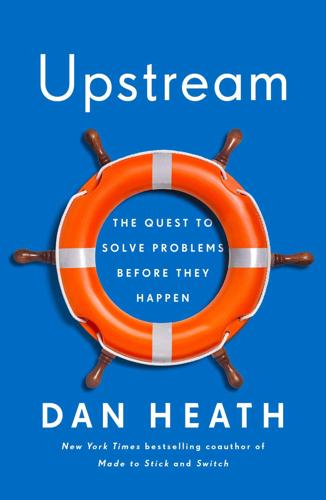
Upstream: The Quest to Solve Problems Before They Happen
by
Dan Heath
Published 3 Mar 2020
a metric called the ROSC: “Return of Spontaneous Circulation,” EMT Prep, 2018, https://emtprep.com/free-training/post/return-of-spontaneous-circulation-rosc. world’s best early-detection systems for earthquakes: Alex Greer, “Earthquake Preparedness and Response: Comparison of the United States and Japan,” Leadership and Management in Engineering 12, no. 3 (2012): 111–25. TV commercial for IBM: IBM Watson TV commercial, Watson at Work: Engineering, 2017, https://www.ispot.tv/ad/wIha/ibm-watson-watson-at-work-engineering, accessed April 30, 2019. elevator companies today offer “smart” elevators: Oscar Rousseau, “AI, Sensors, and the Cloud Could Make Your Buildings Lift Safer,” Construction Week Online, February 18, 2019, https://www.constructionweekonline.com/products-services/169357-ai-sensors-and-the-cloud-could-make-your-buildings-lifts-safer.
…
This is not fantasy.I Many major elevator companies today offer “smart” elevators, which send a smorgasbord of diagnostic data to the cloud—including lighting, noise, speed, temperature, and much more—that can be scoured for early signs of problems. “One of the most important things that an online connection to the cloud gives you is the ability to spot trends in advance before they start creating problems,” John Macleod, an IBM Watson IoT technical specialist, told Computerworld. “Take the time it takes a door to close; normally 5 seconds, but it may gradually extend to 5.1, then 5.2. Nobody’s really noticing it as you get in and out of the lift, but the gradual change in time might well indicate something’s becoming sticky and needs lubrication.… And then you can act in advance to deal with them rather than waiting for the doors to stick shut and catch people inside the lift.”
…
He was found in the arms of his special education assistant, who died while trying to protect him. He was in first grade. Hockley wants desperately to stop this moment from happening to another parent. To interrupt another school’s chain of dominoes by rushing into the space between them. I. Although it’s striking how far Watson has slipped: from “the computer who won Jeopardy!” to a black box sitting in a random office building, making predictions out loud to no one. CHAPTER 9 How Will You Know You’re Succeeding? A question that bedevils many upstream interventions is: What counts as success? With downstream work, success can be wonderfully tangible, and that’s partly because it involves restoration.
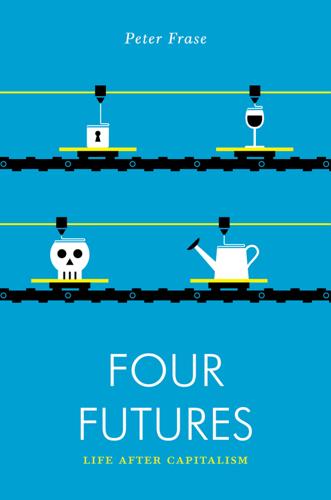
Four Futures: Life After Capitalism
by
Peter Frase
Published 10 Mar 2015
But we do see many indications that we now have the possibility—although not necessarily the reality—of drastically reducing the need for human labor. A few examples will demonstrate the diverse areas in which human labor is being reduced or eliminated entirely. In 2011, IBM made headlines with its Watson supercomputer, which successfully competed and won against human competitors on the game show Jeopardy. Although this feat was a somewhat frivolous publicity stunt, it also demonstrated Watson’s suitability for other, more valuable tasks. The technology is already being tested to assist doctors in processing the enormous volume of medical literature to better diagnose patients, which in fact was the system’s original purpose.
…
In a world where the economy is based on intellectual property, companies will constantly be suing each other for alleged infringements of others’ copyrights and patents, so there will be a need for a lot of lawyers. This will provide employment for some significant fraction of the population, but again it’s hard to see this being enough to sustain an entire economy, particularly because of a theme that we saw in the introductory chapter: just about anything can, in principle, be automated. Watson, IBM’s Jeopardy-playing computer program, is already automating the work of lower-level law firm staff. And it’s easy to imagine big intellectual property firms coming up with procedures for mass-filing lawsuits that rely on fewer and fewer human lawyers, just as there are now systems that detect copyrighted music in online videos and send requests for removal.

In Our Own Image: Savior or Destroyer? The History and Future of Artificial Intelligence
by
George Zarkadakis
Published 7 Mar 2016
Dick. 1989: Tim Berners-Lee invents the World Wide Web. 1990: Seiji Ogawa presents the first fMRI machine. 1993: Rodney Brooks and others start the MIT Cog Project, an attempt to build a humanoid robot child in five years. 1997: Deep Blue defeats Garry Kasparov at chess. 2000: Cynthia Breazeal at MIT describes Kismet, a robot with a face that simulates expressions. 2004: DARPA launches the Grand Challenge for autonomous vehicles. 2009: Google builds the self-driving car. 2011: IBM’s Watson wins the TV game show Jeopardy!. 2014: Google buys UK company Deep Mind for $650 million. 2014: Eugene Goostman, a computer program that simulates a thirteen-year-old boy, passes the Turing Test. 2014: Estimated number of robots in the world reaches 8.6 million.1 2015: Estimated number of PCs in the world reaches two billion.2 NOTES Introduction 1PCs (‘Personal computers’) started becoming widely available in the early 1980s: IBM 5150 in 1981, Commodore PET in 1983.
…
The other seminal event that signalled that something big was changing in the field of Artificial Intelligence took place in February 2011, and was televised. Watson – another computer developed by IBM – beat two former, human, winners of the popular American TV quiz Jeopardy! and won the prize of a million dollars. Watson was a truly amazing machine. It was not a singular entity but a cluster of ninety servers, each one equipped with multiple processors. Its massively parallel hardware architecture was capable of supporting millions of searches into its knowledge base. For the purpose of the TV quiz, the engineers at IBM loaded Watson with 200 million pages of data, including dictionaries, encyclopaedias and literary articles. Moreover, Watson communicated in natural language.
…
Kurzweil marks the year 2030 as a watershed by extrapolating, like Vinge, from today’s exponential improvement of computers according to Moore’s Law:25 2030 thus becomes the year that computer complexity will surpass the complexity of information processing in the human brain. Deep Blue, driverless cars crossing the Mojave Desert, and Watson beating humans at Jeopardy! all seem to validate the arguments made by Vinge and Kurzweil. Brute computer power has made computers more ‘intelligent’. Nevertheless, underneath the correlation between powerful computing and intelligent behaviour lurk two fundamental assumptions that deserve closer examination. The first assumption is that our computer technology, whose architecture is different from that of the human brain, is nevertheless capable of exhibiting every aspect of human intelligence, including self-awareness.

The Drunkard's Walk: How Randomness Rules Our Lives
by
Leonard Mlodinow
Published 12 May 2008
As a counterpoint to Koppett’s story, consider now the story of a fellow who does have credentials, a fellow named Bill Miller. For years, Miller maintained a winning streak that, unlike Koppett’s, was compared to Joe DiMaggio’s fifty-six-game hitting streak and the seventy-four consecutive victories by the Jeopardy! quiz-show champ Ken Jennings. But in at least one respect these comparisons were not very apt: Miller’s streak earned him each year more than those other gentlemen’s streaks had earned them in their lifetimes. For Bill Miller was the sole portfolio manager of Legg Mason Value Trust Fund, and in each year of his fifteen-year streak his fund beat the portfolio of equity securities that constitute the Standard & Poor’s 500.
…
What I’ve learned, above all, is to keep marching forward because the best news is that since chance does play a role, one important factor in success is under our control: the number of at bats, the number of chances taken, the number of opportunities seized. For even a coin weighted toward failure will sometimes land on success. Or as the IBM pioneer Thomas Watson said, “If you want to succeed, double your failure rate.” I have tried in this book to present the basic concepts of randomness, to illustrate how they apply to human affairs, and to present my view that its effects are largely overlooked in our interpretations of events and in our expectations and decisions.
…
That may be the case for Marilyn, who is most famous for her response to the following question, which appeared in her column one Sunday in September 1990 (I have altered the wording slightly): Suppose the contestants on a game show are given the choice of three doors: Behind one door is a car; behind the others, goats. After a contestant picks a door, the host, who knows what’s behind all the doors, opens one of the unchosen doors, which reveals a goat. He then says to the contestant, “Do you want to switch to the other unopened door?” Is it to the contestant’s advantage to make the switch?2 The question was inspired by the workings of the television game show Let’s Make a Deal, which ran from 1963 to 1976 and in several incarnations from 1980 to 1991.
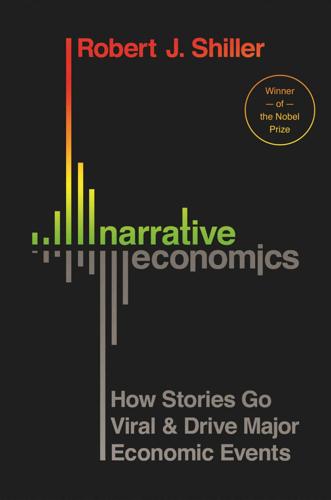
Narrative Economics: How Stories Go Viral and Drive Major Economic Events
by
Robert J. Shiller
Published 14 Oct 2019
To answer this question, we must consider the advent of Apple’s Siri, the iPhone app launched in 2011 that uses automatic speech recognition (ASR) and natural language understanding (NLU) to (attempt to) answer the questions you’ve asked it.21 To many, Siri’s ability to talk, understand, and provide information looked like the advent of that long-awaited singularity when machines become as smart as, or smarter than, people. That same year, IBM presented its talking computer Watson as a competitor on the television quiz show Jeopardy, and Watson beat the human champions who played against it. Now these are followed by Amazon Echo’s Alexa, Google’s “OK Google,” and other variations and improvements such as Alibaba’s Tmall Genie, LingLong’s DingDong, and Yandex’s Alice. These inventions were amazing; the time prophesied by Star Wars, The Transformers, and The Jetsons seemed finally to have arrived.
…
See also labor unions Wagner, Robert, 184 Walker, Edmond, 250 Wall Street Journal “Mansion” section, 224–25 Wanniski, Jude, 44–45 war metaphors, 17 Warner/Chappell Music, 98 wars: inflation during, 265–66. See also Civil War, US; World War I; World War II war to end all wars, 242 Washington, George, 100–101, 102, 117, 177 Washington Mutual (WaMu) bank run, 135 Watson, IBM computer on Jeopardy, 207 The Way the World Works (Wanniski), 44 “We are the 99%” protests of 2011, 8, 225 weather forecasting, 123–25 Weems, Mason Locke, 100 Weiman, Rita, 139 Welch, Ivo, 300 welfare mother, narrative on, 49–50 When Washington Shut Down Wall Street (Silber), 94 Whewell, William, 12 White, Hayden, 37 Whitman, Walt, 165 Wicked (Broadway musical), 172 Wicked (Maguire), 172 Wikipedia, 7 Wikiquotes, 102 wikis, 7 Williams, James D., 147 Wilson, E.

The Zero Marginal Cost Society: The Internet of Things, the Collaborative Commons, and the Eclipse of Capitalism
by
Jeremy Rifkin
Published 31 Mar 2014
The Big Ten Network uses algorithms to create original pieces posted just seconds after games, eliminating human copywriters.37 Artificial intelligence took a big leap into the future in 2011 when an IBM computer, Watson—named after IBM’s past chairman—took on Ken Jennings, who held the record of 74 wins on the popular TV show Jeopardy, and defeated him. The showdown, which netted a $1 million prize for IBM, blew away TV viewers as they watched their Jeopardy hero crumble in the presence of the “all-knowing” Watson. Watson is a cognitive system that is able to integrate “natural language processing, machine learning, and hypothesis generation and evaluation,” says its proud IBM parent, allowing it to think and respond to questions and problems.38 Watson is already being put to work.
…
Christopher Steiner, “Automatons Get Creative,” New York Times, August 17, 2012, http://online.wsj.com/news/articles/SB10000872396390444375104577591304277229534#printprin (accessed June 30, 2013). 37. Ibid. 38. “IBM Watson: Ushering in a New Era of Computing,” IBM, http://www-03.ibm.com/innova tion/us/watson/ (accessed October 22, 2013). 39. Brian T. Horowitz, “IBM, Nuance to Tune Watson Supercomputer for Use in Health Care,” EWeek, February 17, 2011, http://www.eweek.com/c/a/Health-Care-IT/IBM-Nuance-to-Tune -Watson-Supercomputer-for-Use-in-Health-Care-493127/ (accessed October 22, 2013). 40. Associated Press, “Watson’s Medical Expertise Offered Commercially,” Telegram, February 8 2013, http://www.telegram.com/article/20130208/NEWS/102089640/0 (accessed October 22, 2013). 41.
…
Watson is a cognitive system that is able to integrate “natural language processing, machine learning, and hypothesis generation and evaluation,” says its proud IBM parent, allowing it to think and respond to questions and problems.38 Watson is already being put to work. IBM Healthcare Analytics will use Watson to assist physicians in making quick and accurate diagnoses by analyzing Big Data stored in the electronic health records of millions of patients, as well as in medical journals.39 IBM’s plans for Watson go far beyond serving the specialized needs of the research industry and the back-office tasks of managing Big Data. Watson is being offered up in the marketplace as a personal assistant that companies and even consumers can converse with by typed text or in real-time spoken words.
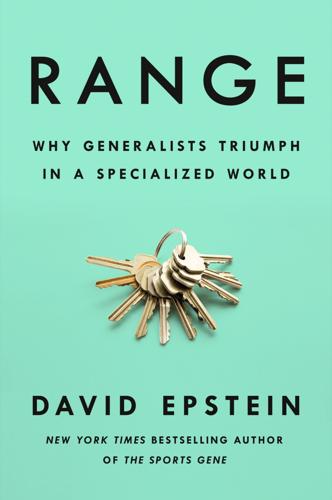
Range: Why Generalists Triumph in a Specialized World
by
David Epstein
Published 1 Mar 2019
In the rule-bound but messier world of driving, AI has made tremendous progress, but challenges remain. In a truly open-world problem devoid of rigid rules and reams of perfect historical data, AI has been disastrous. IBM’s Watson destroyed at Jeopardy! and was subsequently pitched as a revolution in cancer care, where it flopped so spectacularly that several AI experts told me they worried its reputation would taint AI research in health-related fields. As one oncologist put it, “The difference between winning at Jeopardy! and curing all cancer is that we know the answer to Jeopardy! questions.” With cancer, we’re still working on posing the right questions in the first place. In 2009, a report in the esteemed journal Nature announced that Google Flu Trends could use search query patterns to predict the winter spread of flu more rapidly than and just as accurately as the Centers for Disease Control and Prevention.
…
“In narrow enough worlds”: In addition to an interview with Gary Marcus, I used video of his June 7, 2017, lecture at the AI for Good Global Summit in Geneva, as well as several of his papers and essays: “Deep Learning: A Critical Appraisal,” arXiv: 1801.00631; “In Defense of Skepticism About Deep Learning,” Medium, January 14, 2018; “Innateness, AlphaZero, and Artificial Intelligence,” arXiv: 1801.05667. IBM’s Watson: For a balanced take on Watson’s challenges in healthcare—from one critic calling it “a joke,” to others suggesting it falls far short of the original hype but does indeed have value—see: D. H. Freedman, “A Reality Check for IBM’s AI Ambitions,” MIT Technology Review, June 27, 2017, online ed. “The difference between winning at Jeopardy!”: The oncologist is Dr. Vinay Prasad. He said this to me in an interview, and also shared it on Twitter. a report in the esteemed journal Nature: J.
…
“using procedures” question types, 82–85, 90 See also learning fast and slow “eduction,” 43 Ehrlich, Paul, 215–18, 220, 221 Einstein, Albert, 229 Einstellung effect, 177 Eli Lilly, 172–73 Ellington, Duke, 9, 69–70 employment and careers changing, 130–32, 131n, 136–37, 154n, 160–61 compensation in, 9 and corporate HR policies, 213 high-risk opportunities, 136, 137 “match quality” in, 128–29, 130–31, 135–36, 138–140 and personal changes, 156 sampling opportunity in, 130 and winding paths of dark horses, 154 error correction, 74, 75 experience-expertise link, 18–21, 53 experimentation, 269–273, 287–89, 290, 291 Exxon Valdez oil tanker disaster, 175–77 fame, 220 Federer, Roger, 3–4, 31 Fermi, Enrico, 52, 52n Fermi problems, 52–53 Feynman, Richard, 249 figlie del coro of Venice, 56–64 and composers, 62–63 multi-instrument approach of, 61–62, 64 music program of, 61 and names of children, 59, 63 financial crisis of 2008, 12, 279 Finster, Howard, 169 firefighting in novel circumstances, 21, 30 pattern recognition in, 19, 20, 30, 112 wilderness firefighting, 245–47, 248 Fischer, Bobby, 16 Fleisher, Leon, 76 flu predictions, 29–30 Flynn, James, 37–40, 44, 45, 47–50, 275, 277 Flynn effect, 37–40, 45–46 Flyvbjerg, Bent, 110–11 Foles, Nick, 8 food preservation, 173–74 Frances Hesselbein Leadership Institute, 152 Freakonomics (Levitt), 131 Gaiman, Neil, 210 Game Boy by Nintendo, 196–97 Garg, Abhimanyu, 188 Gauguin, Paul, 128 Gawande, Atul, 6 Geim, Andre, 273 generation effect, 85–86 Gentner, Dedre, 102–3, 104, 113–14, 115, 119 Geveden, Rex, 261–63, 264 Gigerenzer, Gerd, 226 Gilbert, Dan, 156 Girl Scouts, 148–151, 153 Gleason, Paul, 248 global financial crisis of 2008, 12, 279 Gobet, Fernand, 26, 34 Godin, Seth, 136, 143 golf, 1–2, 5–6, 18, 20, 21, 30 Good Judgment Project, 222–23, 224, 258 Google Flu Trends, 29–30 Gorbachev, Mikhail, 220–21 Gore, Bill, 286 Graham, Paul, 163 Grant, Adam, 77 graphene, 273 Gravity Probe B project, 260–63 Great Britain, 6, 227–28 Greve, Henrich, 208–10 Griffin, Abbie, 211–12, 213 grit, 121–145 in athletics, 141–42, 143 and changing course, 142 and context principle, 159–160 Duckworth’s concept of, 133–35 and marshmallow test, 157–59, 159n and match quality, 135, 143 and officer training, 132–35, 137–140, 142 and spelling bee competitors, 133, 134, 142 of Van Gogh, 121–27, 144 and youthful ambition, 142–43 Gruber, Howard, 212–13 Hamilton (musical), 281 happiness, 131, 131n, 162 Haydn, Joseph, 63 Head Start early childhood education programs, 96–97, 97n head starts and changing course, 162 cult of, 67, 97, 162, 275 in music training, 67 of the Polgar sisters, 15–18 hedgehog/foxes model of expertise, 221, 223, 225, 228, 229–231 Hendrix, Jimi, 73 Henslow, John Stevens, 229 Hernandez, Nelson, 23–24 Hesselbein, Frances, 147–153, 161–62, 264 high-risk opportunities, 136, 137 Hinds, Ciarán, 166–67 hint-giving practices, 82–83, 85, 87 hiring practices, 213 HIV/AIDS, 283–84 Hogarth, Robin, 20–21, 31, 34 Holley, Lonnie, 168 Holmes, Oliver Wendell, 291 household rules, 77 Hutchison, Kay Bailey, 284–85 hypercorrection effect, 86 Ibarra, Herminia, 160–64, 290 Ibn Khaldun, 47 “if-then signatures,” 159 Ig Nobel Prizes, 273 immigration, 281n impressionism, 127 improvisational skills, 74–76 influenza predictions, 29–30 infrastructure projects, 110–11 InnoCentive, 173, 175, 177–78, 189 innovation and innovators in art world, 127–28 comic book creators, 209–10 and corporate hiring practices, 213 disorderly path of, 287–89 and immigration, 281n and medieval guilds, 278 and Nintendo’s Wii, 199–200 outsider advantage in, 178 and R&D spending, 206 routines as an impediment to, 211 and savants, 32 serial, 211–13 of specialists, 205 in teams and individual creators, 209–10 traits of, 211–12 “inside view” concept of Kahneman and Tversky, 108 instinctive decisions, 19 instructors, 91–92 Integrated Science Program at Northwestern University, 114–15, 119 Intelligence Advanced Research Projects Activity (IARPA), 222–23 interdisciplinary approaches, 180–81, 276–77, 278n, 279, 281 “interleaving” (mixed practice), 94–96 inventors failures and breakthroughs of, 288 impacts of specialist vs. generalist, 9, 203–4, 205 See also innovation and innovators IQ scores and the Flynn effect, 37–40, 45–46 Israel Defense Forces, 19–20 Jackson, Kirabo, 132 Japan, 83–84, 281n jazz musicians, 68, 75–76 Jentleson, Katherine, 168–69 Jeopardy! 29 Jobs, Steve, 33 Jordan, Hillary, 166 Junger, Sebastian, 165 Kaggle competitions, 178–79 Kahan, Dan, 227–28, 230 Kahneman, Daniel on experience-expertise link, 19–21, 159–160 high school curriculum project of, 108 “inside view” concept of, 108 on repetitive domains, 32 Kasparov, Garry, 18–19, 22–23, 24, 25 Kepler, Johannes analogies used by, 100–102, 103, 113, 116 and Copernican model of planets, 99–100 documentation of discovery process, 115 and Mars orbit, 116 and planetary motion, 100–102 “kind” learning environments about, 20 domains that benefit from, 32 and early specialization, 21, 32 efficiency of specialization in, 210–11, 213 pattern recognition in, 20–21, 24–25, 112 Klein, Gary, 18–19, 20, 112 Knight, Phil, 154–55 Konnikova, Maria, 143–44 Kornell, Nate, 85–88, 95 Kpelle people in Liberia, 44 Kranz, Gene, 258, 262 Lakhani, Karim, 178, 181 language and abstract thinking, 44–45 lateral thinking, 191–213 about, 193–94 of Darwin, 212–13 and Dyson’s birds/frogs analogy, 200–201 and Game Boy by Nintendo, 196–97 and impact of specialist vs. generalist inventors, 203–4, 205 and Ouderkirk’s multilayer optical film, 201–3 of polymaths, 204–6 and Unusual (or Alternative) Uses Task, 198 with withered technology, 193–94, 197, 271–72 of Yokoi at Nintendo, 192–97, 198–200 late starts/specialization in art world, 121–28 in athletics, 3–4, 6–9, 287, 289 and changing employment, 130–32 as integral to success, 128 in literary world, 128 of Malamud, 128–29 and “match quality” in vocations, 129–130, 157 of Tillman Scholars, 10, 145 learning environments, 20–21, 24, 30, 32.

The Rationalist's Guide to the Galaxy: Superintelligent AI and the Geeks Who Are Trying to Save Humanity's Future
by
Tom Chivers
Published 12 Jun 2019
An AI that was faster at thinking than a human, but lacked anything like as much knowledge, might be as good at solving problems as a slower-thinking but more well-read human. But if it were able to read – and understand – the whole of Wikipedia in a few days or hours, it would rapidly become hugely more knowledgeable than any human. Bostrom points out that in 2011, IBM’s Watson, which won the Jeopardy! quiz show, did so by reading a huge amount of text and extracting relevant information from it. Whether it ‘understood’ that text is largely a semantic question; it was able to make use of the information within it. A future, human-level AI would be better at this task than Watson. The difficulty of the problem is only one part of the equation, though.
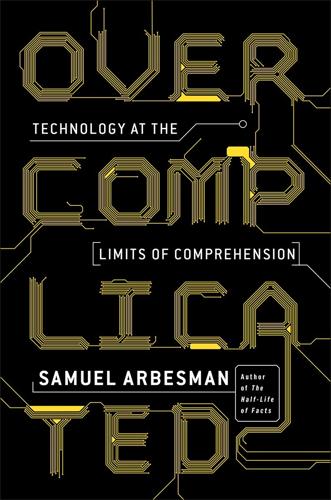
Overcomplicated: Technology at the Limits of Comprehension
by
Samuel Arbesman
Published 18 Jul 2016
And they sound really good. A Scott Joplin–style composition sounds like Joplin. While Cope didn’t create these songs directly, he still can take pride in their construction. His computational creations can provide him with naches. Similarly, the creators of IBM’s Watson might shep naches from the machine’s win over its human opponents on Jeopardy! We can broaden this sense of naches still more. Many of us support a sports team and take pride in its wins, even though we had nothing to do with them. Or we become excited when a citizen of our country takes the gold in the Olympics, or makes a new discovery and is awarded a prestigious prize.
…
Even though we continue to specialize in order to handle the more complicated systems we are building, seeing this web of interconnections reminds us that each domain does not stand alone; they are all part of a vast connected framework. Since these systems are interconnected in many different ways, we will increasingly require the ability to connect one area of knowledge to another. When constructing a computer program that can play Jeopardy!, for example, you need knowledge of everything from linguistics to computer hardware; specialization alone will not work. We need a certain breadth of knowledge. However, as noted earlier, before too long, we will bump up against the limits to what we can truly understand; we just can’t hold all the relevant knowledge in our heads.
…
S., 153 hapax legomena, 54–55, 128, 206 Harold and the Purple Crayon (Johnson), 162 Harvard, John, 90 Heartbleed vulnerability, 97–98 Heaven, Douglas, 82 heavy-tailed distributions, 55–56, 133, 206 hierarchies, 27, 50–51 highly optimized tolerance, 99, 120 Hild (Griffith), 145–46 Hillis, Danny, 23 Hölzle, Urs, 217 Holzmann, Gerard, 21–22 Homer, 129–30 Homer-Dixon, Thomas, 2, 12, 70 Horner, Jack, 79–80, 97 Howard, Luke, 148 Howard, Philip K., 22, 46 HTML, 32 humility: as response to limits of human comprehension, 155–56 as response to technological complexity, 155–56, 158, 165, 167, 170, 174, 176 Huxley, Thomas Henry, 113, 114 HyperCard, 162–63 IBM, 84, 169 IBM 3083 computer, 37 ideas, interconnectivity of, 142 if-then statements, 80–81 Iliad (Homer), 129–30 infield fly rule, 172 infrastructure, 66 accretion in, 42, 100–101 complexity of, 100–101 interconnection of, 2 interconnection of natural world and, 3–4 of Internet, 101–2 replacement of, 46 Ingenuity Gap, The (Homer-Dixon), 2 interaction, 65 in cancer, 126 in catastrophes, 126 in complex systems, 36, 43–51, 62, 65, 146 in financial sector, 126 in legal system, 45–46 of modules, 64 in software, 44–45 interconnectivity, 2, 14–15, 45–46, 103, 128, 135, 146 in financial sector, 24–26, 62, 64 ideas and, 142 and limits of human comprehension, 78–79 modules in, 63–65, 208 in technological complexity, 2, 47–48 unexpected behavior of, see unexpected behavior Internal Revenue Service, 37–38 Internet, 47, 66 evolving function of, 31–32 physical infrastructure of, 101–2 interoperability, 47–48 optimal vs. maximum, 62–63, 64–65 interpreters, of complex systems, 166–67, 229 Ionia, 138–39 iPad, 162 Jeopardy! (TV show), 142, 169 Jobs, Steve, 161 Jones, Benjamin, 90 July 8, 2015, system crashes on, 1, 4 Kant Generator, 74 Kasparov, Garry, 84 Katsuyama, Brad, 189 Kelly, Kevin, 83 Kelly, Sean Dorrance, 173 Kircher, Athanasius, 86 Kirk, Chris, 32–33 kluges: in biological systems, 119 definition of, 33 “good enough” in, 42 as inevitable in complex systems, 34–36, 62–66, 127, 128, 154, 173–74 in legal system, 33–34 and limits of human comprehension, 42 in software, 35 knowledge: burden of, 90, 212 explosion of, 86–88, 89–91, 142–43 generalists and, 142–49 limits to, 153–54 Renaissance man and, 86–89, 93, 144 specialization and, 85–86, 90–91 Knowledge, The, 78 Koopman, Philip, 10, 100, 201 kosmos, 139–40 language: cognitive processing of, 73–74 grammar in, 54, 57–58 hapax legomena in, 54–55, 206 machine translation and, 57–58, 207 power laws in, 55–56 recursion in, 71–72, 75 legacy code, legacy systems, 43, 223 accretion and, 39–40, 198–99 in biological systems, 118, 119–20 inducing new functions from, 126, 198 trauma of replacing, 39–42 legal system: accretion in, 40–41, 46 complexity in, 16, 85 edge cases in, 59–61 interaction in, 45–46 kluges in, 33–34 limits of comprehension and, 22 Leibniz, Gottfried, 89 Leidy, Joseph, 86 Lewis, Michael, 189 liberal arts, 145 Library of Congress, 90 limitative theorems, 175 Linus’s law, 102 logic, computer vs. human, 82–84 logistics, 84 London, cabdrivers in, 78 long-tailed distributions, 55–56, 206 “losing the bubble,” 70–71, 85 Lovecraft, H.
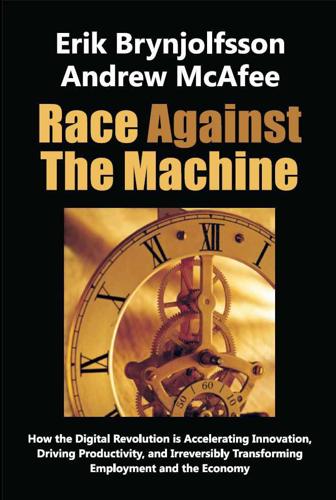
Race Against the Machine: How the Digital Revolution Is Accelerating Innovation, Driving Productivity, and Irreversibly Transforming Employment and the Economy
by
Erik Brynjolfsson
Published 23 Jan 2012
Another technology developed at IBM’s Watson labs, this one actually named Watson, shows how powerful it can be to combine these two abilities and how far the computers have advanced recently into territory thought to be uniquely human. Watson is a supercomputer designed to play the popular game show Jeopardy! in which contestants are asked questions on a wide variety of topics that are not known in advance.1 In many cases, these questions involve puns and other types of wordplay. It can be difficult to figure out precisely what is being asked, or how an answer should be constructed. Playing Jeopardy! well, in short, requires the ability to engage in complex communication.
…
GeoFluent takes words written in one language, such as an online chat message from a customer seeking help with a problem, and translates them accurately and immediately into another language, such as the one spoken by a customer service representative in a different country. GeoFluent is based on statistical machine translation software developed at IBM’s Thomas J. Watson Research Center. This software is improved by Lionbridge’s digital libraries of previous translations. This “translation memory” makes GeoFluent more accurate, particularly for the kinds of conversations large high-tech companies are likely to have with customers and other parties. One such company tested the quality of GeoFluent’s automatic translations of online chat messages.
…
Machine computation has surpassed humans in the first task but not yet in the second one. As digital technologies continue to improve, we are skeptical that even these skills will remain bastions of human exceptionalism in the coming decades. The examples in Chapter 2 of Google’s self-driving car and IBM’s Watson point to a different path going forward. The technology is rapidly emerging to automate truck driving in the coming decade, just as scheduling truck routes was increasingly automated in the last decade. Likewise, the high end of the skill spectrum is also vulnerable, as we see in the case of e-discovery displacing lawyers and, perhaps, in a Watson-like technology, displacing human medical diagnosticians.
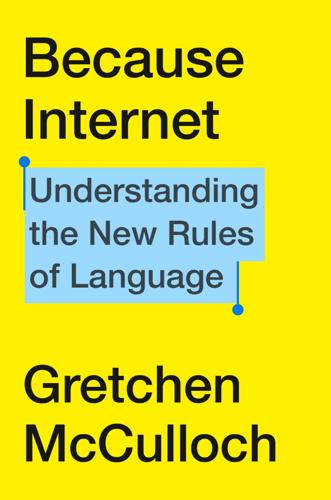
Because Internet: Understanding the New Rules of Language
by
Gretchen McCulloch
Published 22 Jul 2019
psychologist Jeffrey Hancock: Jeffrey T. Hancock. 2004. “Verbal Irony Use in Face-to-Face and Computer-Mediated Conversations.” Journal of Language and Social Psychology 23(4). pp. 447–463. IBM experimented: Alexis C. Madrigal. January 10, 2013. “IBM’s Watson Memorized the Entire ‘Urban Dictionary,’ Then His Overlords Had to Delete It.” The Atlantic. www.theatlantic.com/technology/archive/2013/01/ibms-watson-memorized-the-entire-urban-dictionary-then-his-overlords-had-to-delete-it/267047/. Chapter 5. Emoji and Other Internet Gestures Second Life made: The most recent statistic that Linden Lab provides is from 2013 and consists of 36 million accounts created in total, with a million monthly active users.
…
I’d love to see a proper corpus study comparing postcards and texts from younger and older people, to see what else we can learn by drawing together informal writing across different generations and mediums. POST INTERNET PEOPLE When I was growing up, my family didn’t have a television. This made me a trifle eccentric among my peers, but I nonetheless picked up, by cultural osmosis and glimpses at other people’s houses, the essentials of TV culture: how to operate a remote control, the Jeopardy! theme song, and the social progression of Sesame Street from “the best” to “a thing for babies” to the nostalgia-fueled best again. I grew up in a post-television generation, irrespective of my own (lack of) participation in it. The Pre Internet People don’t feel socially connected to the internet even when they do use it, and the Post Internet People are the inverse: socially influenced by the internet regardless of their own level of use.

Coders: The Making of a New Tribe and the Remaking of the World
by
Clive Thompson
Published 26 Mar 2019
Most of the contestants were coders who worked at local high-tech firms or computer science students at nearby universities. But the winners, it turns out, were . . . a group of high school girls from New Jersey. In only 24 hours, the trio created reVIVE, a virtualreality app that tests kids for signs of ADHD by having them play a series of games, while also checking their emotional state using IBM’s Watson AI. After the students were handed their winnings onstage—a huge trophy-sized check for $5,000—they flopped into chairs in a nearby room to recuperate. They’d been coding almost nonstop since noon the day before and were bleary with exhaustion. “Lots of caffeine,” said then 17-year-old Amulya Balakrishnan, clad in a blue T-shirt that read “WHO HACK THE WORLD?
…
Silicon Valley and China in particular grew ravenous for coders fluent in deep learning, with salaries reaching well into the six figures for anyone adept at teaching computers to see, hear, read, and predict. What type of coder gets obsessed with making AI? As you’d imagine, many were entranced by the savant robots of sci-fi. Dave Ferrucci—the computer scientist who led an IBM team to create Watson—hankered to make a machine that could converse like the one on the Star Trek Enterprise system. “It understands what you’re asking and provides just the right chunk of response that you needed,” he told me. “When is the computer going to get to a point where the computer knows how to talk to you?
…
Flatiron is comparatively transparent about their hiring rates; in an audited report, they found that of the students who graduated between November 2015 and December 2016 and looked for work, 97 percent found some sort of software engineering work in a six-month window around graduation—about 40 percent getting full-time work (with an average salary of $67,607 a year), half winding up with contract work, paid internships, or paid apprenticeship work that averaged $27 an hour, and the rest freelancing. One student who’d enjoyed some success is Luis De Castro, a 29-year-old who lives in San Francisco. When I saw him at a GitHub conference in the fall of 2016, he was hunched over his laptop, his thick dark dreads spilling out of his hoodie as he frantically patched together a demo that used IBM’s Watson AI to take text messages and identify their emotional state. He’d recently finished a stint at Dev Bootcamp, a since-shuttered school nearby, and was trying to get the demo working to show some fellow students at an event later that evening. It wasn’t working, at least not yet. “Oh man, I have no idea what’s going on here,” he said, and laughed, as the code coughed up error after error, before he finally quashed the bug with minutes to go.
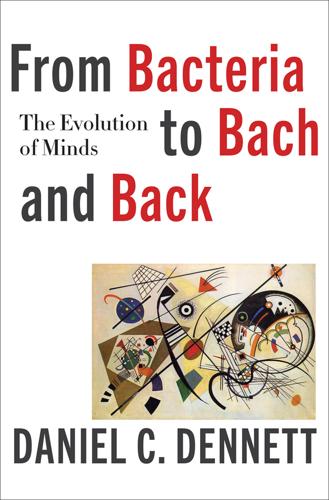
From Bacteria to Bach and Back: The Evolution of Minds
by
Daniel C. Dennett
Published 7 Feb 2017
So far, there are few signs of this sort of phenomenon emerging in the swiftly growing competences of deep-learning machines. As Domingos stresses, learning machines are (very intelligently) designed to avail themselves of Darwinesque, bottom-up processes of self-redesign. For IBM’s Watson, the program that beat champion contestants Ken Jennings and Brad Rutter in the Jeopardy television quiz program in 2011, the words it was competent to string together into winning answers were not thinking tools but just nodes located in a multidimensional space of other nodes, not so much memes as fossil traces of human memes, preserving stupendous amounts of information about human beliefs and practices without themselves being active participants in those practices.
…
Not necessarily; it can be mere epistemic hunger, of the free-floating variety that “motivates” explorations in all animals. 84The feasibility of such a process has been known since the invention of “latent semantic analysis” by Landauer and Dumais (1998), a forerunner of the “deep learning” algorithms being applied these days, by IBM’s Watson, Google Translate, and a host of other impressive applications (see chapter 15). 85See also Christiansen and Chater, “Language as Shaped by the Brain” (a Behavioral and Brain Sciences Target article, 2008) and the extensive commentaries thereupon for a vigorous debate on whether genetic evolution or cultural evolution has played a greater role in creating our linguistic competence.
…
But we are entering a new era where the filters and second-guessers and would-be trendsetters may not be people at all, but artificial agents. This will not suit everybody, as we will see in the next section. But that may not stop hierarchical layers of such differential replicators from burgeoning, and then we may indeed face the calamity encountered by the Sorcerer’s Apprentice and the multiplying brooms. In an IBM television advertisement, Watson, “in conversation” with Bob Dylan, says that it can “read 800 million pages a second.” Google Translate, another icon among learning machines, has swept aside the GOFAI systems that were top-down attempts to “parse” and interpret (and thereby understand, in at least a pale version of human comprehension) human language; Google Translate is an astonishingly swift, good—though still far from perfect—translator between languages, but it is entirely parasitic on the corpus of translation that has already been done by human bilinguals (and by volunteer bilingual informants who are invited to assist on the website).

The Big Nine: How the Tech Titans and Their Thinking Machines Could Warp Humanity
by
Amy Webb
Published 5 Mar 2019
CHINOOK won when Tinsley withdrew from the match and relinquished his championship title.34 In 1997, IBM’s Deep Blue supercomputer beat world chess champion Garry Kasparov, who buckled under the stress of a six-game match against a seemingly unconquerable opponent. In 2004, Ken Jennings won a statistically improbable 74 consecutive games on Jeopardy!, setting a Guinness World Record at that time for the most cash ever won on a game show. So when he accepted a match against IBM’s Watson in 2011, he felt confident he was going to win. He’d taken classes on AI and assumed that the technology wasn’t advanced enough to make sense of context, semantics, and wordplay. Watson crushed Jennings, who started to lose confidence early on in the game.
…
,” Journal of Economic Perspectives 29, no. 3 (Summer 2015): 51–60, https://www.aeaweb.org/articles?id=10.1257/jep.29.3.51. CHAPTER 6: LEARNING TO LIVE WITH MILLIONS OF PAPER CUTS: THE PRAGMATIC SCENARIO 1. Casey Ross and Ike Swetlitz, “IBM Watson Health Hampered by Internal Rivalries and Disorganization, Former Employees Say,” STAT, June 14, 2018, https://www.statnews.com/2018/06/14/ibm-watson-health-rivalries-disorganization/. 2. Ibid. 3. Gamaleldin F. Elsayed, Ian Goodfellow, and Jascha Sohl-Dickstein, “Adversarial Reprogramming of Neural Networks,” preprint edition accessed, https://arxiv.org/pdf/1806.11146.pdf. 4.
…
A few of these are ImageNet (the enormous data set of images that’s used widely), WikiText (a language modeling data set using Wikipedia articles), 2000 HUB5 English (an English-only data set used for speech), and LibriSpeech (about 500 hours of audiobook snippets). If you wanted to build a health AI to spot anomalies in blood work and oncology scans, the problem isn’t the AI, it’s data—humans are complicated, our bodies have tons of possible variants, and there isn’t a big enough data set ready to be deployed. A decade ago, in the early 2010s, the IBM Watson Health team partnered with different hospitals to see if its AI could supplement the work of doctors. Watson Health had some stunning early wins, including a case involving a very sick nine-year-old boy. After specialists weren’t able to diagnose and treat him, Watson assigned a probability to possible health issues—the list included common ailments as well as outliers, including a rare childhood illness called Kawasaki disease.
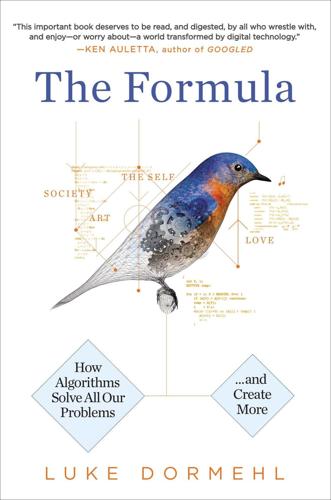
The Formula: How Algorithms Solve All Our Problems-And Create More
by
Luke Dormehl
Published 4 Nov 2014
The algorithm surprised the study’s authors by correctly predicting 75 percent of the verdicts (based on only a handful of different metrics), as compared to the team of legal scholars, who guessed just 59 percent, despite having access to far more specialized information.65 In its own way, the “Supreme Court Forecasting Project” was the legal profession’s equivalent of IBM’s Watson supercomputer winning $1 million on Jeopardy! in 2011—marking, as it did, the culmination of a long-held techno dream first proposed by the jurimetrics movement. In 1897, Oliver Wendell Holmes Jr. wrote enthusiastically of his belief that the legal system, as with science’s natural laws, should be quantifiably predictable.
…
“I use computers for damn near everything, [but] there’s something about this computer that I find deeply troubling,” Ecker wrote. I’m not a purist by any stretch. I hate overt music categorization, and I hate most debates about “real” versus “fake” art, but that’s not what this is about. This is about the very essence of humanity. Computers can compete and win at Jeopardy!, beat chess masters, and connect us with people on the other side of the world. When it comes to emotion, however, they lack much of the necessary equipment. We live every day under the pretense that what we do carries a certain weight, partly due to the knowledge of our own mortality, and this always comes through in truly great music.
…
Jr. 157 Iamus 206–7 IfIDie 96 In The Plex (Levy) 41 Industrial Revolution 21, 40 info-aesthetics 182 Information Age, coming of 21 Instagram 216 Interactive Telecommunications Program 15 Internet: and cookies 17 dating 71, 75–79, 81; see also eHarmony; FindYourFaceMate; GenePartner; love and sex growing access to 76–77 and scavenger-class customers 49–50 shopping via 16–17, 20; see also Amazon tracking of user movements on 18 as transactional machine 46 and web analytics 18–19, 41; see also Google iPhone 36 Is That a Fish in Your Ear? (Bellos) 215 Isaacson, Walter 36 Islendiga-App 88–89 Jackson, Joe 70 James, Henry 70 James, William 17 Jastrow, Robert 96 Jeopardy! 158 Jobs, Steve 36, 87 John Carter 163, 172 Jolie, Angelina 69 Jonze, Spike 103 JPod (Coupland) 16 judges 156–58 judicial behavior, predicting 156–59 and automated judges 160 jurimetrics 139–40, 158 Kahler Communications 24–25 Kahler, Dr. Taibi 22–24 Kardashian, Khloe 68 Kari 99–103, 105 Kasparov, Garry 29 Keillor, Garrison 28 Kelly, John 127–29 Kelly, Kevin 12 Kelvin, Lord 31 Kerckhoff, Alan 77 Kindle 180, 197–98, 203 Kinect 132 Kipman, Alex 132 Kirke, Alexis 190–92, 194, 197 Knack 32–34 Knowledge Acquiring and Response Intelligence 99 Kodak 129, 216 Koppleman, Lee 134 Kranzberg, Melvin 151, 222 lactoferrin 10 Lake Wobegone Strategy 28–29 Lanier, Jaron 90–91, 199, 216, 239 LargeAndLovely 78 Lasswell, Harold 5 Late Age of Print, The (Stiphas) 221 Latour, Bruno 136, 235–36 law and law enforcement 106–33, 137–60 and age and gender 121–23 and Ambient Law 132, 137, 143–44 and automated judges 160 and bail and parole 119–21 and crime hotspots 110–112 and drunk-driving detection 131–33 and legal discovery 125–28 and “PreCrime” 118–19, 123–25 and predicting judicial behavior 155–60 and predictive policing 107–9, 119 and PredPol 113 and “RealCog” 120–21 and relative poverty 117 and rules vs. standards 141–43 and school students 125 Lawrence, Jennifer 169 LegalZoom 130 Leibniz, Gottfried 139–40 Lessig, Lawrence 139 Levitt, Theodore 217 Levy, David 104–5 Levy, Frank 212–13 Levy, Steven 41 Lewis, Sinclair 186–87 Li, Jiwei 35 Life & Times of Michael K (Coetzee) 203 Life on Screen (Turkle) 57 LinkedIn 27 Liquid Love (Bauman) 82 Liu, Benjamin 89 LivesOn 96–97 London Symphony Orchestra 206 Long Tail, The (Anderson) 56, 191n Lorenz, Edward 171 Love in the Time of Algorithms (Slater) 81 love and sex: algorithms and technology for 61–95 passim, 98–105, 239; see also ALikeWise; BeautifulPeople; Bedpost; eHarmony; FindYourFaceMate; FitnessSingles; Kari; LargeAndLovely; love and sex; “Match”; Match.com; OKCupid; SeaCaptainDate; Serendipity; UniformDating; VeggieDate and celebrity marriages, see celebrity marriages, predicting breakup of genetic matching for 77–78 Warren’s researches into 72–74 and wearable tech 94–5 see also divorce; “Match”; PlentyOfFish Love and Sex with Robots (Levy) 104–5 Lovegety 87–88 Lucky You 167–68 Lust in Space 100 McAfee, Andrew 217 Macbeth (Shakespeare) 191 McBride, Joseph 164n MacCormick, John 212, 222 McCue, Colleen 106–7 McLuhan, Marshall 88 Malinowski, Sean 107–14 Manovich, Lev 177–78 Many Worlds 190–92, 194, 197 maps 134–36 Marx, Karl 11, 137n Massachusetts Institute of Technology (MIT) 28 Human Dynamics group in 85 Serendipity project of 85–87 “Match” 62–66 tabulated example of 64 see also love and sex Mattersight Corporation 22–24 Mayer, Marissa 228 Meaney, Nick 166–67, 170–72, 176, 205 Measure of Fidget 32 Medavoy, Mike 162 Medicine and the Reign of Technology (Reiser) 142 Meehl, Paul E. 208–9 Meiklejohn, Alexander 231 Merleau-Ponty, Maurice 98–99 Michael (Quantified Self devotee) 13 see also Quantified Self movement Microserfs (Coupland) 16 Microsoft 51–52, 132, 192–93, 237 MIDI 199 Mill, John Stuart 118 Ming, Vivienne 25–27, 29–30 Miniscript 22–23 Minority Report 118–20, 123 Mismeasure of Man, The (Gould) 33–34 Mohler, George 111–12 money laundering 19 Morozov, Evgeny 201–2, 226, 243 Moses, Robert 134 movies, see art and entertainment Mozart, Wolfgang 172, 203–4 Mumford, Lewis 5 Murnane, Richard 212–13 musical dice game 204 Myhrvold, Nathan 182 Nara 46–47, 136 NASA 24 NASCAR 37 Nautilus 14 Negobot 240 Net Delusion, The (Morozov) 226 Netflix 52, 127, 176, 188–89, 228, 236 neural networks 166 illustration of 168 neuroscience 159 new algorithmic identity 55, 58 New Division of Labor, The (Levy, Murnane) 212–13 New Statesman 55 New York Times 40–41, 52, 58, 67, 71 Newton, Isaac 114 Nietzsche, Friedrich 70 Nightingale, Florence 118 Nine Algorithms That Changed the Future (MacCormick) 222 Nineteen Eighty-Four (Orwell) 138, 198 Nudge (Thaler, Sunstein) 137–38 Obama, Barack 189, 225 Odom, Lamar 68 “(Of the) Standard of Taste” (Hume) 199–200 OKCupid 77 On Love (de Botton) 87 On Love (Stendhal) 70 On Man and the Development of his Faculties (Quetelet) 117 online dating, see Internet: dating online shopping, see Internet: shopping via Onomatics 130–31 OptimEyes 20 Orwell 138 panopticon 55 Parada, Sergio 99–100, 102–3 paradox of choice 82–83, 156 Paradox of Choice, The (Winchester) 82–83 Pariser, Eli 47 Parks, Rosa 59 Pascal, Blaise 70 Patterson, James 203 Pentland, Alex 85 personality types 23–25 tabulated 23 Pfizer 58 Pinker, Steven 80–81 Pinkett, Jada 69 Pitt, Brad 69 Plan of Scientific Operations . . .

New Laws of Robotics: Defending Human Expertise in the Age of AI
by
Frank Pasquale
Published 14 May 2020
They do not reflect a company dead set on replacing the expertise of doctors with big data and algorithms. Rather, professionals are invited in, to help devise structured approaches to health care information and the health system itself. Similarly, IBM has shifted the marketing of its Watson system in health care and law, billing it as more of a helper for than a replacement of doctors.8 When I talked to a representative of IBM’s Watson team in 2017, he said that they promote a vision of augmented, not artificial, intelligence. As even the firms with the most to gain from AI marketing shift toward an IA (intelligence augmentation) approach, the dream of a wholly automated diagnostic tool may soon seem more anachronistic than futuristic.
…
Kelly Reller, “Mayo Assists Google in Providing Quick, Accurate Symptom and Condition Information,” Mayo Clinic, June 21, 2016, http://newsnetwork.mayoclinic.org/discussion/mayo-clinic-assists-google-in-providing-quick-accurate-symptom-and-related-condition-information/. 8. Ian Steadman, “IBM’s Watson Is Better at Diagnosing Cancer than Human Doctors,” Wired, February 11, 2013, http://www.wired.co.uk/article/ibm-watson-medical-doctor. 9. Ajay Agrawal, Joshua Gans, and Avi Goldfarb, Prediction Machines: The Simple Economics of Artificial Intelligence (Cambridge, MA: Harvard Business Review Press, 2018). 10. For example, a self-driving car’s “vision” system may interpret a stop sign as a “45 miles per hour” sign if some pieces of tape are placed on the sign.
…
Flora Sapio, Weiming Chen, and Adrian Lo, Foundation for Law and International Affairs, https://flia.org/wp-content/uploads/2017/07/A-New-Generation-of-Artificial-Intelligence-Development-Plan-1.pdf. 4. Melissa Korn, “Imagine Discovering That Your Teaching Assistant Really Is a Robot,” Wall Street Journal, May 6, 2016, http://www.wsj.com/articles/if-your-teacher-sounds-like-a-robot-you-might-be-on-to-something-1462546621. 5. IBM has made similar points about Watson’s role relative to lawyers and doctors, primarily as a tool of the existing professionals rather than as machine to replace them. 6. Tamara Lewin, “After Setbacks, Online Courses Are Rethought,” New York Times, December 10, 2016, https://www.nytimes.com/2013/12/11/us/after-setbacks-online-courses-are-rethought.html. 7.

A World Without Work: Technology, Automation, and How We Should Respond
by
Daniel Susskind
Published 14 Jan 2020
Douglas Hofstadter, the computer scientist and writer, called its first victory “a watershed event” but dismissed it as something that “doesn’t have to do with computers becoming intelligent.”4 He had “little intellectual interest” in IBM’s machine because “the way brute-force chess programs work doesn’t bear the slightest resemblance to genuine human thinking.”5 John Searle, the philosopher, dismissed Deep Blue as “giving up on A.I.”6 Kasparov himself effectively agreed, writing off the machine as a “$10 million alarm clock.7 Or take Watson, another IBM computer system. Its claim to fame is that in 2011, it appeared on the US quiz show Jeopardy! and beat the two top human champions of the show. In the aftermath, Hofstadter again agreed that the system’s performance was “impressive” but also said that it was “absolutely vacuous.”8 Searle, in a sharp Wall Street Journal editorial, wryly noted, “Watson didn’t know it won on Jeopardy!”9 Nor did the machine want to call up its parents to say how well it had done, or go to the pub to celebrate with its friends. Hofstadter, Kasparov, Searle, and those who make similar observations are all correct, as we saw in the last chapter.
…
Back in 1995, for example, it was unthinkable that Microsoft’s technological rule would ever come to an end, yet now they are being talked about as the “underdog” in the sector.7 Nor do striking contemporary achievements necessarily mean that further remarkable successes will follow. For one cautionary tale, consider IBM’s Watson, the celebrated Jeopardy!-winning computer system. Over the last few years, there has been great excitement about its broad potential. But despite their best efforts, a recent high-profile partnership between the Watson team and MD Anderson, a large American cancer hospital, ended in conspicuous failure: the $60 million system designed to help treat cancer was deemed “not ready for human investigational or clinical use.”8 Indeed, the companies behind the health care technologies that really change our lives may not exist yet.
…
You’re not trying to imitate humans on processing levels,” and p. 58: “In a way, Deep Blue is giving up on A.I. because it doesn’t say, ‘Well we’re going to try to do what human beings do,’ but it says ‘We’re just going to overpower them with brute force.’” 7. Garry Kasparov, “The Chess Master and the Computer,” New York Review of Books, 11 February 2010. 8. Quoted in William Herkewitz, “Why Watson and Siri Are Not Real AI,” Popular Mechanics, 10 February 2014. 9. John Searle, “Watson Doesn’t Know It Won on ‘Jeopardy!’,” Wall Street Journal, 23 February 2011. 10. Douglas Hofstadter, Gödel, Escher, Bach: An Eternal Golden Braid (London: Penguin, 2000), p. 601: “There is a related ‘Theorem’ about progress in AI: once some mental function is programmed, people soon cease to consider it as an essential ingredient of ‘real thinking.’

What to Think About Machines That Think: Today's Leading Thinkers on the Age of Machine Intelligence
by
John Brockman
Published 5 Oct 2015
It can count things fast without understanding what it’s counting. It has counting algorithms—that’s it. We saw this with IBM’s Watson program on Jeopardy! One Jeopardy! question was, “It was the anatomical oddity of U.S. gymnast George Eyser, who won a gold medal on the parallel bars in 1904.” A human opponent answered that Eyser was missing a hand (wrong). And Watson answered, “What is a leg?” Watson lost too, for failing to note that the leg was “missing.” Try a Google search on “Gymnast Eyser.” Wikipedia comes up first with a long article about him. Watson depends on Google. If Jeopardy! contestants could use Google, they’d do better than Watson. Watson can translate “anatomical” into “body part,” and Watson knows the names of the body parts.
…
Much farther up the staircase, doctors are becoming increasingly dependent on diagnostic systems that are provably more reliable than any human diagnostician. Do you want your doctor to overrule the machine’s verdict when it comes to making a lifesaving choice of treatment? This may prove to be the best—most provably successful, most immediately useful—application of the technology behind IBM’s Watson, and the issue of whether or not Watson can properly be said to think (or be conscious) is beside the point. If Watson turns out to be better than human experts at generating diagnoses from available data, we’ll be morally obliged to avail ourselves of its results. A doctor who defies it will be asking for a malpractice suit.
…
It’s a breach of etiquette, on a spectrum with asking someone to temporarily serve as a paperweight or a shelf. I’ve seen this breach, also, in brief conversational moments when someone asks a question of someone else—a number, a date, a surname, the kind of question you could imagine being on a quiz show, some obscure point of fact—and the other person grimaces or waves off the query. They’re saying, “I don’t know. You have a phone, don’t you? You have the entire Internet, and you’re disrespecting me, wasting my time, using me.” Not for nothing do we now have the sarcastic catchphrase, “Here, let me Google that for you.”

Superintelligence: Paths, Dangers, Strategies
by
Nick Bostrom
Published 3 Jun 2014
The gap between a dumb and a clever person may appear large from an anthropocentric perspective, yet in a less parochial view the two have nearly indistinguishable minds.9 It will almost certainly prove harder and take longer to build a machine intelligence that has a general level of smartness comparable to that of a village idiot than to improve such a system so that it becomes much smarter than any human. Consider a contemporary AI system such as TextRunner (a research project at the University of Washington) or IBM’s Watson (the system that won the Jeopardy! quiz show). These systems can extract certain pieces of semantic information by analyzing text. Although these systems do not understand what they read in the same sense or to the same extent as a human does, they can nevertheless extract significant amounts of information from natural language and use that information to make simple inferences and answer questions.
…
It completes perfectly the puzzle rated most difficult by humans, yet is stumped by a couple of nonstandard puzzles that involved spelling backwards or writing answers diagonally.)48 Scrabble Superhuman As of 2002, Scrabble-playing software surpasses the best human players.49 Bridge Equal to the best By 2005, contract bridge playing software reaches parity with the best human bridge players.50 Jeopardy! Superhuman 2010: IBM’s Watson defeats the two all-time-greatest human Jeopardy! champions, Ken Jennings and Brad Rutter.51 Jeopardy! is a televised game show with trivia questions about history, literature, sports, geography, pop culture, science, and other topics. Questions are presented in the form of clues, and often involve wordplay. Poker Varied Computer poker players remain slightly below the best humans for full-ring Texas hold ‘em but perform at a superhuman level in some poker variants.52 FreeCell Superhuman Heuristics evolved using genetic algorithms produce a solver for the solitaire game FreeCell (which in its generalized form is NP-complete) that is able to beat high-ranking human players.53 Go Very strong amateur level As of 2012, the Zen series of go-playing programs has reached rank 6 dan in fast games (the level of a very strong amateur player), using Monte Carlo tree search and machine learning techniques.54 Go-playing programs have been improving at a rate of about 1 dan/year in recent years.
…
There are both moral and prudential reasons for favoring outcomes in which everybody gets a share of the bounty. We will not say much about the moral case, except to note that it need not rest on any egalitarian principle. The case might be made, for example, on grounds of fairness. A project that creates machine superintelligence imposes a global risk externality. Everybody on the planet is placed in jeopardy, including those who do not consent to having their own lives and those of their family imperiled in this way. Since everybody shares the risk, it would seem to be a minimal requirement of fairness that everybody also gets a share of the upside. The fact that the total (expected) amount of good seems greater in collaboration scenarios is another important reason such scenarios are morally preferable.
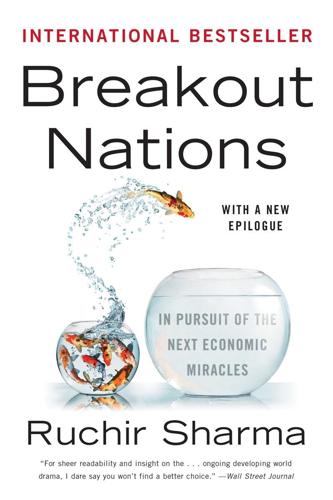
Breakout Nations: In Pursuit of the Next Economic Miracles
by
Ruchir Sharma
Published 8 Apr 2012
It’s hard to imagine just what gains will emerge from this awesome capacity, but as a demonstration to provoke interest, Google recently used its cloud to decode the human genome . . . in eleven seconds. This shift—from merely crunching data to analyzing information—was illustrated in a viewer-friendly way by an IBM computer named “Watson” when, in early 2011, it dominated the most successful human champion of the popular American TV quiz show Jeopardy! However large the impact of digital technology will be on economic productivity (and I believe it will be significant), it is likely to be disproportionately large in the leading economies, particularly the United States. As wages rise in emerging nations, they are starting to automate and digitize their manufacturing plants, but nations like Brazil, Russia, India, and China remain well below the global average on automation measures, such as number of robots per employee.

Prediction Machines: The Simple Economics of Artificial Intelligence
by
Ajay Agrawal
,
Joshua Gans
and
Avi Goldfarb
Published 16 Apr 2018
Machine-learning techniques are increasingly good at predicting missing information, including identification and recognition of items in images. Given a new set of images, the techniques can efficiently compare millions of past examples with and without disease and predict whether the new image suggests the presence of a disease. This kind of pattern recognition to predict disease is what radiologists do.4 IBM, with its Watson system, and many startups have already commercialized AI tools in radiology. Watson can identify a pulmonary embolism and a wide range of other heart issues. One startup, Enlitic, uses deep learning to detect lung nodules (a fairly routine exercise) but also fractures (more complex). These new tools are at the heart of Hinton’s forecast but are a subject for discussion among radiologists and pathologists.5 What does our approach suggest about the future of radiologists?
…
P., 93–94 Duke University Teradata Center, 35 earthquakes, 59–60 eBay, 199 economics, 3 of AI, 8–9 of cost reductions, 9–11 data collection and, 49–50 on externalities, 116–117 New Economy and, 10–11 economies of scale, 49–50, 215–217 Edelman, Ben, 196–197 education, income inequality and, 214 electricity, cost of light and, 11 emergency braking, automatic, 111–112 error, tolerance for, 184–186 ethical dilemmas, 116 Etzioni, Oren, 220 Europe, privacy regulation in, 219–220 exceptions, prediction by, 67–68 Executive Office of the US President, 222–223 experience, 191–193 experimentation, 88, 99–100 AI tool development and, 159–160 expert prediction, 55–58 externalities, 116–117 Facebook, 176, 190, 195–196, 215, 217 facial recognition, 190, 219–220 Federal Aviation Administration, 185 Federal Trade Commission, 195 feedback data, 43, 46 in decision making, 74–76, 134–138 experience and, 191–193 risks with, 204–205 financial crisis of 2008, 36–37 flexibility, 36 Forbes, Silke, 168–169 Ford, 123–134, 164 Frankston, Bob, 141, 164 fraud detection, 24–25, 27, 84–88, 91 Frey, Carl, 149 fulfillment industry, 105, 143–145 Furman, Jason, 213 Gates, Bill, 163, 210, 213, 221 gender discrimination, 196–198 Gildert, Suzanne, 145 Glozman, Ron, 53–54 Goizueta, Robert, 43 Goldin, Claudia, 214 Goldman Sachs, 125 Google, 7–8, 43, 50, 187, 215, 223 advertising, 176, 195–196, 198–199 AI-first strategy at, 179–180 AI tool development at, 160 anti-spam team sting, 202–203 bias in ads and, 195–196 China, 219 Inbox, 185, 187 market share of, 216–217 Now, 106 privacy policy, 190 search engine optimization and, 64 search tool, 19 translation service, 25–26 video content algorithm, 200 Waymo, 95 Waze and, 89–90 Grammarly, 96 Greece, ancient, 23 Griliches, Zvi, 159 Grove, Andy, 155 hackers, 200 Hacking, Ian, 40 Hammer, Michael, 123–134 Harford, Tim, 192–193 Harvard Business School cases, 141 Hawking, Stephen, 8, 210–211, 221 Hawkins, Jeff, 39 health insurance, 28 heart disease, diagnosing, 44–45, 47–49 Heifets, Abraham, 135, 136 Hemingway, Ernest, 25–26 heuristics, 55 Hinton, Geoffrey, 145 hiring, 58, 98 ZipRecruiter and, 93–94, 100 Hoffman, Mitchell, 58 homogeneity, data, 201–202 hotel industry, 63–64 Houston Astros, 161 Howe, Kathryn, 14 human resource (HR) management, 172–173 IBM’s Watson, 146 identity verification, 201, 219–220 iFlytek, 26–27 if-then logic, 91, 104–109 image classification, 28–29 ImageNet, 7 ImageNet Challenge, 28–29 imitation of algorithms, 202–204 income inequality, 19, 212–214 independent variables, 45 inequality, 19, 212–214 initial public offerings (IPOs), 9–10, 125 innovation, 169–170, 171, 218–219 innovator’s dilemma, 181–182 input data, 43 in decision making, 74–76, 134–138 identifying required, 139 Integrate.ai, 14 Intel, 15, 215 intelligence churn prediction and, 32–36 human, 39 prediction as, 2–3, 29, 31–41 internet advertising, 175–176 browsers, 9–10 delivery time uncertainty and commerce via, 157–158 development of the commercial, 9–10 inventory management, 28, 105 Iowa, hybrid corn adoption in, 158–160, 181 iPhone, 129–130, 155 iRobot, 104 James, Bill, 56 Jelinek, Frederick, 108 jobs, 19.
…
Without such decision embeddedness, why go to the trouble of making a prediction in the first place? Sophisticated bad actors in this context would understand that by altering a prediction, they could adjust the decisions. For instance, a diabetic using an AI to optimize insulin intake could end up in serious jeopardy if the AI has incorrect data about that person and then offers predictions that suggest lowering insulin intake when it should be increased. If harming a person is someone’s objective, then this is one way to do it effectively. We are most likely to deploy prediction machines in situations where prediction is hard.

The Age of Surveillance Capitalism
by
Shoshana Zuboff
Published 15 Jan 2019
“IBM Cloud Makes Hybrid a Reality for the Enterprise,” IBM, February 23, 2015, https://www-03.ibm.com/press/us/en/pressrelease/46136.wss. 69. “IBM Watson Personality Insights,” IBM Watson Developer Cloud, October 14, 2017, https://personality-insights-livedemo.mybluemix.net; “IBM Personality Insights—Needs,” IBM Watson Developer Cloud, October 14, 2017, https://console.bluemix.net/docs/services/personality-insights/needs.html#needs; “IBM Personality Insights—Values,” IBM Watson Developer Cloud, October 14, 2017, https://console.bluemix.net/docs/services/personality-insights/values.html#values. 70. “IBM Personality Insights—Use Cases,” IBM Cloud Docs, November 8, 2017, https://console.bluemix.net/docs/services/personality-insights/usecases.html #usecases. 71.
…
For those who seek surveillance revenues, dark data represent lucrative and necessary territories in the dynamic universal jigsaw constituted by surveillance capitalism’s urge toward scale, scope, and action. Thus, the technology community casts dark data as the intolerable “unknown unknown” that threatens the financial promise of the “internet of things.”25 It is therefore understandable that Green portrays machine intelligence—and specifically IBM’s anthropomorphized artificial intelligence system called “Watson”—as the authoritative savior of an apparatus threatened by waste and incomprehensibility. Machine intelligence is referred to as “cognitive computing” at IBM, presumably to avoid the uneasy connotations of inscrutable power associated with words like machine and artificial.
…
Surveillance capitalism is no different. The prediction imperative unleashes the surveillance hounds to stalk behavior from the depths, and well-intentioned researchers unwittingly oblige, leaving a trail of cheap, push-button raw meat for surveillance capitalists to hunt and devour. It did not take long. By early 2015, IBM announced that its Watson Personality Service was open for business.68 The corporation’s machine intelligence tools are even more complex and invasive than those used in most academic studies. In addition to the five-factor personality model, IBM assesses each individual across twelve categories of “needs,” including “Excitement, Harmony, Curiosity, Ideal, Closeness, Self-expression, Liberty, Love, Practicality, Stability, Challenge, and Structure.”
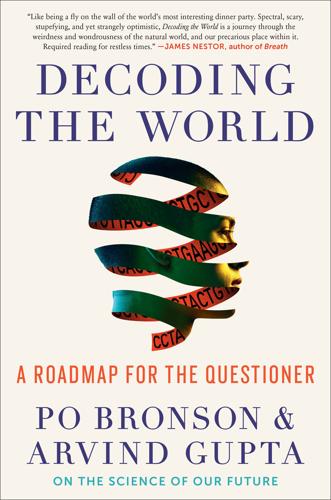
Decoding the World: A Roadmap for the Questioner
by
Po Bronson
Published 14 Jul 2020
More data doesn’t make AI conscious any more than adding hard drives to your computer make it think like a human. I remember the brain in my hands. The formaldehyde. The desires of the old man. His failures. His sense of self. That brain I held runs on less than 12.6 watts of power a day. Your average light bulb is 75 watts. IBM Watson, a supercomputer crunching the latest AI algorithms, consumes a boggling 7.5 megawatts of power to turn its red light on. As I rest, I realize the answer I was hunting for has always been there, in common sense. It’s not AI we have to fear. I’m aware there’s a vague sense of chaos in the world.
…
Think for a moment about what people not in the Silicon Valley ecosystem are hearing out of Silicon Valley today: • That we’re going to live on Mars. • That artificial intelligence will turn evil and wage war with humans. • That the oceans will rise, deserts will expand, and the food system is in jeopardy. • That the robots will take tens of millions of jobs. • That we’ll print replacement organs for transplants. • That we’ll eat beef meatballs without killing cows. • That rich people won’t age. • Everyone’s going to get $1,000 a month, for nothing. • CRISPR will lead to a new transhumanist species.

Superforecasting: The Art and Science of Prediction
by
Philip Tetlock
and
Dan Gardner
Published 14 Sep 2015
In 1997 IBM’s Deep Blue beat chess champion Garry Kasparov. Now, commercially available chess programs can beat any human. In 2011 IBM’s Watson beat Jeopardy! champions Ken Jennings and Brad Rutter. That was a vastly tougher computing challenge, but Watson’s engineers did it. Today, it’s no longer impossible to imagine a forecasting competition in which a supercomputer trounces superforecasters and superpundits alike. After that happens, there will still be human forecasters, but like human Jeopardy! contestants, we will only watch them for entertainment. So I spoke to Watson’s chief engineer, David Ferrucci.
…
When I asked Joshua Frankel what he reads for fun, the young Brooklyn filmmaker rattled off the names of highbrow authors like Thomas Pynchon, thought for a moment, and added that he’d recently read a biography of the German rocket scientist Wernher von Braun and various histories of New York, although Frankel was careful to note that the books about New York are also for his work: he is producing an opera about the legendary clash between Robert Moses, New York’s great urban planner, and the free-spirited antiplanner Jane Jacobs. Frankel is not someone to tangle with on Jeopardy! Are superforecasters better simply because they are more knowledgeable and intelligent than others? That would be flattering for them but deflating for the rest of us. Knowledge is something we can all increase, but only slowly. People who haven’t stayed mentally active have little hope of catching up to lifelong learners.
…
Forecasters should feel the same about under- and overreaction to new information, the Scylla and Charybdis of forecasting. Good updating is all about finding the middle passage. Captain Minto In the third season of the IARPA tournament, Tim Minto won top spot with a final Brier score of 0.15, an amazing accomplishment, almost in the league of Ken Jennings’s winning Jeopardy! seventy-four games in a row. A big reason why the forty-five-year-old Vancouver software engineer did so well is his skill at updating. For his initial forecasts, Tim takes less time than some other top forecasters. “I typically spend five to fifteen minutes, which means maybe an hour or so total when a new batch of six or seven questions come out,” he said.

This Is for Everyone: The Captivating Memoir From the Inventor of the World Wide Web
by
Tim Berners-Lee
Published 8 Sep 2025
For this, Demis was awarded the 2024 Nobel Prize in Chemistry, and, a little more than ten years after he delivered his Web Foundation anniversary lecture, we were once again invited to a celebratory dinner hosted by Google. Now it was our turn to congratulate him! Demis’s success led me to reflect on my own research. What we might call the ‘facts and logic’ approach to AI has produced some useful tools. Apple’s Siri came from this approach, as did IBM’s Watson, which had been programmed with facts about medical data and Jeopardy! questions. There was also Stephen Wolfram’s ‘Wolfram Alpha’, which is a great resource for maths homework, giving both logical and also beautiful graphical results when asked a general question about advanced maths. These systems had all been built deliberately, with explicit knowledge bases and rules, and with more or less complete lists of things the machine should be able to answer.
…
Nash ref1, ref2 digital commons ref1 digital divide ref1 Digital Equipment Corporation (DEC) ref1 digital signatures ref1 dishwasher poem (GPT-4) ref1 disinformation ref1, ref2 Ditchley Foundation ref1, ref2, ref3, ref4 DNS (Domain Name System) ref1, ref2, ref3 documentation systems ref1, ref2 documents compared to data ref1 doomscrolling ref1, ref2 dot-com bubble ref1, ref2, ref3 dot-matrix printers ref1 Doubleclick ref1 Dougherty, Dale ref1 Dow Jones ref1 Dropbox ref1 e-commerce ref1 E-Trade ref1 East Sheen, London ref1 ECMAScript ref1 Edelman, Richard ref1 Edelman Trust Barometer ref1 Edge ref1 Egypt ref1 eigenvectors 151n Elbaz, Gil ref1 electromagnets ref1 Electronic Frontier Foundation (EFF) ref1, ref2, ref3 Elizabeth II ref1, ref2, ref3, ref4 email ref1, ref2 Emanuel School ref1, ref2, ref3 encryption ref1, ref2, ref3, ref4 engagement, algorithms ref1, ref2, ref3, ref4 Engelbart, Douglas ref1, ref2 Enigma cipher ref1 ‘Enquire-within’ program ref1, ref2, ref3 Enquire Within Upon Everything ref1 equality ref1 Equifax ref1 error codes ref1 Erwise ref1 Eternal September ref1 Ethiopia ref1 Euler’s formula ref1 European Commission ref1 European Computer Manufacturers Association (ECMA) ref1 European Council for Nuclear Research see CERN European Semiconductor Equipment Company ref1 European Union Brexit ref1 GDPR (General Data Protection Regulation) ref1, ref2 Ex Machina (film, 2014) ref1 Excite ref1 Expedia ref1 Facebook advertisements ref1 Africa ref1 AI training ref1 Arab Spring ref1 collaborative filtering and polarization ref1, ref2 data breaches ref1 data ownership ref1 microtargeting ref1 users as the product ref1, ref2 facts, encoding ref1, ref2 farming ref1 Fediverse ref1, ref2, ref3 Fermilab ref1 Ferranti ref1, ref2, ref3 Ferranti, Basil de ref1 File Transfer Protocol (FTP) ref1, ref2 Filo, David ref1 Finland ref1 Firefox ref1, ref2 First Parish Church, Lexington ref1 Flametree ref1 Flanders ref1, ref2 Fora ref1 Ford Foundation ref1 Forth (programming language) ref1 forums ref1 Foster, Norman ref1 free speech ref1 Freud, Lucien ref1 Friendster ref1 Fry, Stephen ref1 Gal, Yarin ref1 Gallaudet University ref1, ref2 garbage in, garbage out ref1 Gates, Bill ref1, ref2, ref3, ref4 GDPR (General Data Protection Regulation) ref1, ref2 GEC ref1 Gemini ref1 generalization ref1 Geneva ref1, ref2, ref3, ref4, ref5 Geneva Amateur Operatic Society (GAOS) ref1 genome-sequencing providers ref1 Geocities ref1 geospatial mapping ref1 Ghana ref1 Gifford, David ref1 GIFs ref1, ref2 Gilliat, Bruce ref1 Gilmore, John ref1 Gilyard-Beer, Peter ref1 Glasswing ref1, ref2 Global News Network (GNN) ref1 Gmail ref1 Go (game) ref1, ref2 Gods of Literature ref1, ref2 Goldstein, Jono ref1, ref2 Google AJAX ref1 anti-trust lawsuits ref1 Applied Semantics purchase ref1 China ref1 Chrome ref1 DeepMind ref1 Gemini ref1, ref2 Gmail ref1 Google Docs ref1 Google Maps ref1, ref2 Google Meet ref1 hosted web anniversary dinner ref1 HTML and WHATWG ref1 passkeys ref1 search functionality ref1, ref2 standards ref1 start-up ref1 transformers ref1 users as the product ref1 Web Index ref1 Zeitgeist network event ref1 Google Maps ref1, ref2 Gopher ref1, ref2 Gore, Al ref1, ref2, ref3, ref4 government data ref1, ref2, ref3 governments and Contract for the Web ref1, ref2, ref3 GPS data ref1, ref2 GPTs (Generative Pre-trained Transformers) ref1, ref2, ref3, ref4 GPUs (Graphical Processing Units) ref1 Grail ref1 graph structures ref1, ref2 Great Firewall of China ref1, ref2 Greif, Irene ref1 Grisham, John ref1 Grok AI ref1 Grundy, Frank ref1, ref2 hacktivism ref1 Hall, Justin ref1 Halonen, Tarja ref1 Hanamura, Wendy ref1 haptic touch ref1 Harari, Yuval Noah ref1, ref2 Hardin, Joseph ref1, ref2, ref3 Harris, Kamala ref1 Harris, Tristan ref1 Harrison, George ref1 Harvard Berkman Klein Center for Internet and Society ref1, ref2 Institute for Rebooting Social Media ref1 Hassabis, Demis ref1, ref2 Hawke, Sandro ref1 Helsinki ref1 Helsinki University of Technology ref1 Hendler, Jim ref1 Herzberg, Frederick ref1 Heywood, Jeremy ref1 Hickson, Ian (Hixie) ref1, ref2 hierarchies ref1 Higgins, Eliot ref1 Higgs boson ref1 Higgs, Peter ref1 Hinton, Geoffrey ref1 holiday bookings ref1, ref2 Home Depot ref1 home pages ref1 Hoogland, Walter ref1, ref2 Hoschka, Philipp ref1, ref2 HTML (Hypertext Markup Language) ref1, ref2, ref3, ref4, ref5, ref6 HTTP (Hypertext Transfer Protocol) ref1, ref2, ref3, ref4, ref5 HTTPS standard ref1 human first systems ref1 human rights ref1, ref2, ref3, ref4, ref5, ref6 see also civil liberties humans as social animals ref1 HyperCard ref1 hyperlinks ref1, ref2, ref3, ref4, ref5, ref6, ref7, ref8 hypertext ref1, ref2, ref3 see also HTML Hypertext ‘91 conference ref1 Hypertext ‘93 conference ref1 Ibargüen, Alberto ref1 IBM, Watson ref1 identity theft ref1 IETF (Internet Engineering Task Force) ref1, ref2, ref3 images GIFs ref1, ref2 IMG tag ref1 PNG (Portable Network Graphics) ref1 Imitation Game, The (film, 2014) ref1 ‘Imitation Game’ (Turing) ref1, ref2 inclusivity ref1, ref2 India ref1, ref2 indigenous communities, land rights ref1 Industrial Revolution ref1 Inflection.AI ref1 Infosys ref1 infrastructure evolution ref1 INRIA (National Institute for Research in Digital Science and Technology), France ref1, ref2 Inrupt ref1, ref2, ref3, ref4 Instagram ref1, ref2, ref3 Institute for Rebooting Social Media ref1 integrated circuits ref1 intellectual property rights ref1, ref2 intelligence agencies ref1, ref2 intention economy ref1, ref2, ref3, ref4 intercreativity ref1, ref2, ref3, ref4 International Standards Organization (ISO) ref1 internet Al Gore funding bill ref1, ref2 blackouts ref1 deep web ref1 early development ref1 early functionality ref1 free ethos ref1, ref2, ref3 Map of Everything ref1, ref2, ref3 protocols ref1, ref2 size ref1 universal access ref1, ref2 see also World Wide Web Internet Archive ref1, ref2 Internet Explorer ref1, ref2, ref3, ref4, ref5 internet service providers (ISPs) ref1, ref2, ref3 interoperability ref1, ref2, ref3, ref4, ref5 Intuit ref1 invisible pixels ref1 IP addresses ref1, ref2, ref3 iPhone ref1, ref2, ref3 Iran ref1 ITT ref1 Jambon, Jan ref1 Java ref1 JavaScript ref1, ref2, ref3 Jitsi ref1 Jobs, Steve ref1, ref2, ref3, ref4, ref5, ref6, ref7 Jones, Peter ref1 JScript ref1 JSTOR ref1 Justin’s Links from the Underground ref1, ref2 Kagame, Paul ref1 Kahle, Brewster ref1, ref2 Kahn, Bob ref1, ref2 Kapor, Mitch ref1 Keio University, Tokyo ref1 Kendall, Alex ref1 Kenya ref1 killer apps ref1 Kirk, Anna ref1 Kirk, Matthew ref1 Knight Foundation ref1 Kotok, Alan ref1 Krotoski, Aleks ref1 Kubrick, Stanley ref1 Kunz, Paul ref1 Kurzweil, Ray ref1 labelling reality or fakes ref1 land rights ref1 LANs (Local Area Networks) ref1 Larkin, Philip ref1 Lassila, Ora ref1 Last.fm ref1 Le Corbusier ref1 LeCun, Yann ref1 Legal Information Institute (LII) ref1, ref2 Legg, Shane ref1 legislation Data Use and Access Bill ref1 GDPR (General Data Protection Regulation) ref1, ref2 mobile phone spectrum ref1 open data ref1 Leighton, Tom ref1 Leith, Rosemary (wife) Berkman Klein Center for Internet and Society ref1 investments ref1 marriage to Tim ref1 sailing ref1, ref2 visits Beijing ref1 web anniversary speech ref1 Web Foundation ref1, ref2, ref3 Lenat, Doug ref1 Lessig, Lawrence ref1 Lewin, Daniel ref1 Li, Angel ref1 liability of hosts ref1 Library of Alexandria ref1, ref2 Library of Congress ref1 LibreOffice ref1 Libya ref1 Lie, Hakon ref1, ref2, ref3 lifeloggers ref1, ref2 lists ref1 Literature, Gods of ref1, ref2 LLMs (Large Language Models) ref1, ref2, ref3, ref4 LocalFirst Community ref1 location data ref1 logic agents ref1, ref2 logic gates ref1, ref2, ref3 London 2012 Olympics ref1, ref2 Lovett, Adrian ref1 Lycos ref1 Lynx ref1 Ma, Jack ref1, ref2 Mac OS X ref1 MacArthur Fellowship ref1 McBryan, Oliver ref1 McCahill, Mark ref1 McCartney, Paul ref1, ref2 McCourt, Frank ref1 machine learning collaborative filtering ref1 neural networks ref1, ref2 see also artificial intelligence machine translation ref1 McManus, Richard ref1 MacWWW ref1 Malamud, Carl ref1 Mandelbrot ref1 maps geospatial mapping ref1 Google Maps ref1, ref2 Map of Everything on the Internet ref1, ref2, ref3 OpenStreetMap ref1, ref2 World Wide Web Middle Earth ref1 Marcos, Bongbong ref1 Markey, Ed ref1, ref2 Martin, George R.
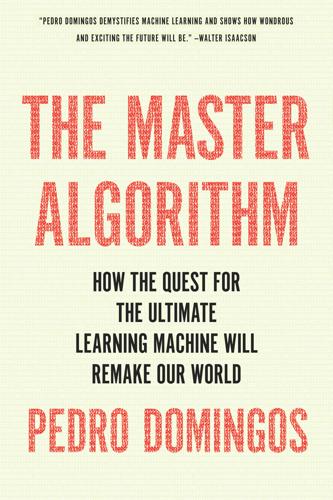
The Master Algorithm: How the Quest for the Ultimate Learning Machine Will Remake Our World
by
Pedro Domingos
Published 21 Sep 2015
For the vast middle ground between the two, there’s machine learning. Paradoxically, even as they open new windows on nature and human behavior, learning algorithms themselves have remained shrouded in mystery. Hardly a day goes by without a story in the media involving machine learning, whether it’s Apple’s launch of the Siri personal assistant, IBM’s Watson beating the human Jeopardy! champion, Target finding out a teenager is pregnant before her parents do, or the NSA looking for dots to connect. But in each case the learning algorithm driving the story is a black box. Even books on big data skirt around what really happens when the computer swallows all those terabytes and magically comes up with new insights.
…
For example, if a fever can be caused by influenza or malaria, and you should take Tylenol for a fever and a headache, this can be expressed as follows: By combining many such operations, we can carry out very elaborate chains of logical reasoning. People often think computers are all about numbers, but they’re not. Computers are all about logic. Numbers and arithmetic are made of logic, and so is everything else in a computer. Want to add two numbers? There’s a combination of transistors that does that. Want to beat the human Jeopardy! champion? There’s a combination of transistors for that too (much bigger, naturally). It would be prohibitively expensive, though, if we had to build a new computer for every different thing we want to do. Rather, a modern computer is a vast assembly of transistors that can do many different things, depending on which transistors are activated.
…
Statistical parsers analyze language with accuracy close to that of humans, where hand-coded ones lagged far behind. Machine translation, spelling correction, part-of-speech tagging, word sense disambiguation, question answering, dialogue, summarization: the best systems in these areas all use learning. Watson, the Jeopardy! computer champion, would not have been possible without it. To this Chomsky might reply that engineering successes are not proof of scientific validity. On the other hand, if your buildings collapse and your engines don’t run, perhaps something is wrong with your theory of physics. Chomsky thinks linguists should focus on “ideal” speaker-listeners, as defined by him, and this gives him license to ignore things like the need for statistics in language learning.

Warnings
by
Richard A. Clarke
Published 10 Apr 2017
Nearly every computer and neural scientist with expertise in the field believes that the intelligence explosion will happen in the next seventy years; most predict it will happen by 2040. In 2015, more than $8.5 billion was invested in the development of new AI technologies. IBM’s Watson supercomputer is hard at work performing tasks ranging from playing (and winning at) Jeopardy! to diagnosing cancer. What will Earth be like when humans are no longer the most intelligent things on the planet? As science fiction writer and computer scientist Vernor Vinge wrote, “The best answer to the question, ‘Will computers ever be as smart as humans?’
…
It feels like going to school wearing a clown suit.”14 Bullish tech experts point to how AI has already and will continue to benefit society. Ginni Rometty, the CEO of IBM, says, “In the future, every decision that humankind makes is going to be informed by a cognitive system like Watson, and our lives will be better for it.” Another IBM executive discounts the idea that Watson could become a threat, because “the only data [Watson] has access to is the data we provide it with. It is not capable of going out on its own and creating—in some iRobot-type of form—its own data construct.”15 IBM also has good reason for touting the safety and promise of its technology: Watson is anticipated to generate $10 billion in revenue for IBM by 2023.
…
What does a society look like when the labor force can no longer earn?29 In 1932, every fourth U.S. household had no breadwinner,30 and the unemployment figures in Europe and Russia were just as glum. Franklin D. Roosevelt saw unemployment as the greatest threat to the nation since the Civil War. “There had never been a time when our institutions were in such jeopardy.”31 FDR was right. Unemployment is corrosive to government stability and calls for remarkably deft leadership, lest the nation collapse. In 1932, the U.S. responded with the New Deal. Western Europe responded with Fascism and the imminent rise of Nazism, Russia deepened into Stalinism and five-year plans.
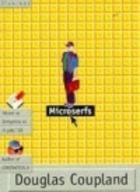
Microserfs
by
Douglas Coupland
Published 14 Feb 1995
I got his machine's message, cobbled together from old Learn how to speak Japanese tapes: [Resonant Berlitzian voice:] Japanese at a glance [Befuddled U.S. tourist:] I can't find my luggage [Japanese bimbette voice:] Nimotsu ga mitsukarimasen [Candice Bergen-type female:] My luggage is here [Studly Toho Studios leading male voice:] Nimotsu wa, koko desu [Game show host voice:] Is there a good disco nearby? [Japanese nerdy male voice:] Chikaku ni, ii disco ga arimasu ka? [Game show host:] I have cramps [Candice:] I have diarrhea [Studly male:] There's something wrong with this camera [Bimbette:] Cauliflower [Game show host] Eggplant [Candice:] Prosciutto with melon [Studly guy:] Shrimp cocktail BEEP... * * * I told Todd to dial Michael's number and he did, and we had to agree that Michael's messages always indeed rocked the Free World.
…
TUESDAY January 4,1994 Woke up sick this morning - finally got the flu. I thought it might be a hangover, but no. In spite of the fact that I think I feel like death-on-a-stick, I want to write down what happened today. * * * First, Michael bounced through the sliding doors around noon in a shiny happy mood, and invited us all out to see our (game show tone of voice) . . . new office! Ethan sold his Ferrari to do the lease. "Farewell 1980s!" he said. (He drives a 1987 Honda Civic now. "I feel like I'm in high school.") Uncharacteristically brash, he yelled, "Convoy! Everybody . . . down to our new office. You, too, Mrs. Underwood . . . we've been liberated from the Habitrail."
…
But face it, Todd - they'll never get it right. Capitalism is something that's ingrained in you from birth. There's more to developing a market economy than pulling a switch and suddenly being a capitalist overnight. As a child you need to read about Lucy's 5-cent psychiatry booth in Charlie Brown; game shows; mailing away for Sea Monkeys - it's all a part of being 'encapitalized.' " She removed the Barbie head from the lineup of objects: "Probably too good." * * * Later on, Susan and Karla were cackling together. I asked them what about and they shot guilty looks at each other. "Barbies," said Karla.
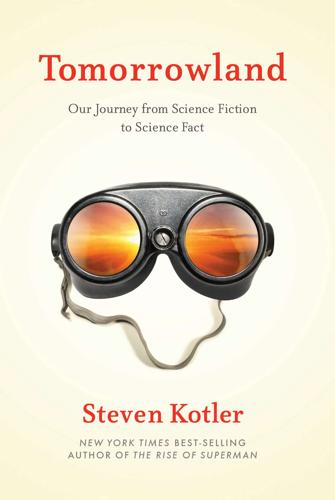
Tomorrowland: Our Journey From Science Fiction to Science Fact
by
Steven Kotler
Published 11 May 2015
Does the scenario we’ve just sketched sound like nothing beyond science fiction? If so, consider that since the turn of the twenty-first century, rapidly accelerating technology has shown a distinct tendency to turn the impossible into the everyday in no time at all. A few years back, IBM’s Watson, an artificial intelligence, whipped the human champion, Ken Jennings, on Jeopardy. As we write this, soldiers with bionic limbs are fighting our enemies and autonomous cars are driving down our streets. Yet most of these advances are small in comparison to the great leap forward currently underway in the biosciences — a leap with consequences we’ve only begun to imagine.
…
See Rozelle, David iWalk, 19 Jacob, Francis, 53 Jacobs-Lorena, Marcelo, 138–39 Jacobson, Cecil, 258 Jaeger, William, 257 James, Anthony, 137, 138 James, William, 168 Janiger, Oscar, 169 Japan asteroid mining missions by, 146–47 nuclear power in, 117, 122–23 Jekot, Walter, 195, 196, 197 Jennings, Ken, 223 Jeopardy (TV show), 223 Jet Propulsion Laboratory, 149 John of God, 159 Johns Hopkins University, 162 Johnson, Brittany, 254 Johnson, Diane, 254 Johnson, Ronald, 254 Johnson Space Center, 148–49 Journal of Psychoactive Drugs, 176 The Journey of a Parisian in the 21st Century (Béliard), 87 JoVE (Journal of Visualized Experiments), 229 Juiced (Canseco), 187–88 jumping genes, 136–37, 138–40 Jupiter, mining, 151 Kamen, Dean, 18 Kanada, 109 Kargel, Jeffrey, 144, 149 Kass, Leon, 214–15, 217 Keasling, Jay, 231 Kelly, Kevin, xvi–xviii Kesey, Ken, 169 Kessler, Ronald, 238 ketamine, 39, 162 Kievenaar, Butch, 7, 15 Killer 6.

Life After Google: The Fall of Big Data and the Rise of the Blockchain Economy
by
George Gilder
Published 16 Jul 2018
Because Go is a game of pure strategy without differentiated pieces like chess, a computer can exhaust the solutions more efficiently than in chess, with its smaller solution space. The Asilomar eschatologists miss the difference between computing-speed and intelligence, between programmable machines and programmers. Tegmark makes the case as well as it can be made that the attainments of AI programs—“Watson” the quiz-show winner and occasionally superior medical diagnostician; Big Blue the chess champion; Google’s DeepMind game players, which learned to outperform human players from scratch in dozens of electronic games; the face-recognizers; the natural language translators; the self-driving car programs—portend a super-intelligence that will someday be so superior to the human mind that we will no more comprehend its depths than a dog grasps the meaning of our own cerebrations.
…
With more than $65 billion currently under management, Mercer’s team relies on racks of Renaissance workstations linked to form supercomputers. They parse immense Markov chains of ordered data to find filigree “ghosts” of tradable correlation. Like Google’s PageRank and its Deep Learning successes with language translation and games, like IBM’s earlier speech-recognition breakthroughs, and like “Watson,” IBM’s supercomputing master of Jeopardy searches and chess strategies, it is founded on ever-faster processing of pure statistics from ever-larger databases. As James Simons explained in a speech in 1999, “Efficient market theory is correct in that there are no gross inefficiencies. But we look at anomalies that may be small in size and brief in time. . . .
…
The strong implication is that Buterin and his colleagues will have to take a back seat in the AI bandwagon, which represents the climactic technology in the history of human invention. The idea of a new generation of transformational technologists does not fit the plot line of a new eschaton. But Google and its world are looking in the wrong direction. They are actually in jeopardy, not from an all-powerful artificial intelligence, but from a distributed, peer-to-peer revolution supporting human intelligence—the blockchain and new crypto-efflorescence. Buterin and his allies are dedicated to restoring data to its originators and incorporating it horizontally and interoperatively across the cryptocosm.
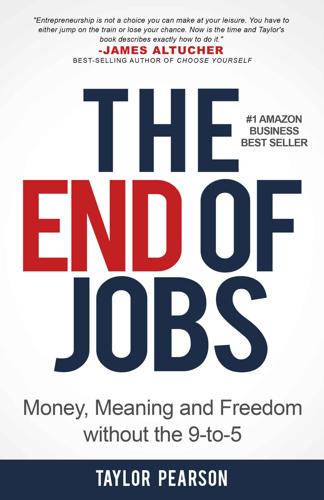
The End of Jobs: Money, Meaning and Freedom Without the 9-To-5
by
Taylor Pearson
Published 27 Jun 2015
It’s the triumph of design over choice. Instead of ordering from the menu, we are more empowered than any prior generation to become the cooks. Are You Structuring Your Reality or Having It Structured for You? The least free are those whose reality is structured for them. “Stay tuned,” they are told before each Jeopardy commercial break, and they do so. At work they are assigned tasks and roles that are clearly defined. They exert very little freedom over their reality. The middle class has created a greater degree of independence and structure a greater deal of their own realities. They are more likely to structure their families and hobbies in ways they find more meaningful and not just as the mass media may instruct them.
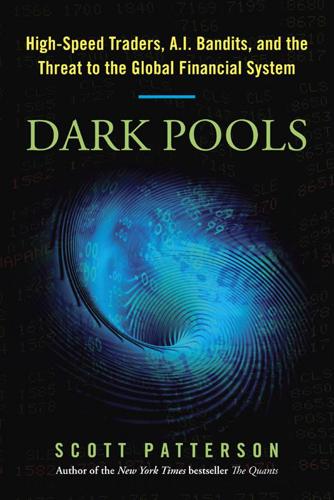
Dark Pools: The Rise of the Machine Traders and the Rigging of the U.S. Stock Market
by
Scott Patterson
Published 11 Jun 2012
The system would scour SEC filings, data on Amazon.com or other retail sites that indicated sales performance, and Twitter feeds that mentioned Apple products. Collectively, the AI program crunched the information like a magical data grinder and spit out a buy or sell recommendation with a certain probability, much like a Wall Street analyst—or IBM’s Watson submitting a response on Jeopardy! That, at least, was the theory. The goal: predict a company’s performance before it became public. Effectively, they were building from scratch an AI financial analyst. Ideally, Kinetic would be able to detect a company’s fortunes even before the company’s own executives and employees knew what was happening.
…
But now programmers were attempting to build computers that could beat humans at the trading game itself, buying and selling stocks based on fundamentals such as sales trends and economic variables. While the effort seemed almost quixotic, there were indications that it could be done. IBM, after all, had recently built an AI computer system called Watson that had defeated the world’s elite Jeopardy! players. The system Kinetic deployed resembled Watson in certain ways. Kinetic’s task, however, was in reality far harder than cracking Jeopardy! Kinetic was trying to hack the market by mining endless terabytes of information stored on databases throughout the world. Its hacker in chief, Ladopoulos, was a charismatic, intense character with a shaved head, rimless glasses, a fondness for vintage tennis shoes, and a million stories.
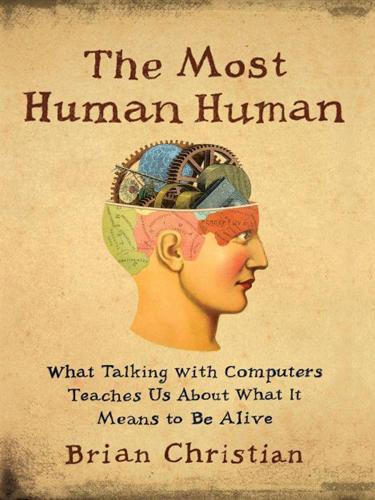
The Most Human Human: What Talking With Computers Teaches Us About What It Means to Be Alive
by
Brian Christian
Published 1 Mar 2011
He asked me about myself, and I explained that I’m a nonfiction writer of science and philosophy, specifically of the ways in which science and philosophy intersect with daily life, and that I’m fascinated by the idea of the Turing test and of the “Most Human Human.” For one, there’s a romantic notion as a confederate of defending the human race, à la Garry Kasparov vs. Deep Blue—and soon, Ken Jennings of Jeopardy! fame vs. the latest IBM system, Watson. (The mind also leaps to other, more Terminator– and The Matrix–type fantasies, although the Turing test promises to involve significantly fewer machine guns.) When I read that the machines came up shy of passing the 2008 test by just one single vote, and realized that 2009 might be the year they finally cross the threshold, a steely voice inside me rose up seemingly out of nowhere.
…
Okuno, “Enabling a User to Specify an Item at Any Time During System Enumeration: Item Identification for Barge-In-Able Conversational Dialogue Systems,” Proceedings of the International Conference on Spoken Language Processing (2009). 18 Brian Ferneyhough, in Kriesberg, “Music So Demanding.” 19 David Mamet, Glengarry Glen Ross (New York: Grove, 1994). 20 For more on back-channel feedback and the (previously neglected) role of the listener in conversation, see, e.g., Bavelas, Coates, and Johnson, “Listeners as Co-narrators.” 21 Jack T. Huber and Dean Diggins, Interviewing America’s Top Interviewers: Nineteen Top Interviewers Tell All About What They Do (New York: Carol, 1991). 22 Clark and Fox Tree, “Using Uh and Um.” 23 Clive Thompson, “What Is I.B.M.’s Watson?” New York Times, June 14, 2010. 24 Nikko Ström and Stephanie Seneff, “Intelligent Barge-In in Conversational Systems,” Proceedings of the International Conference on Spoken Language Processing (2000). 25 Jonathan Schull, Mike Axelrod, and Larry Quinsland, “Multichat: Persistent, Text-as-You-Type Messaging in a Web Browser for Fluid Multi-person Interaction and Collaboration” (paper presented at the Seventh Annual Workshop and Minitrack on Persistent Conversation, Hawaii International Conference on Systems Science, Kauai, Hawaii, January 2006). 26 Deborah Tannen, That’s Not What I Meant!
…
The fact of the matter is, however, filling pauses in speech with sound is not simply a tic, or an error—it’s a signal that we’re about to speak. (Consider, as an analogue, your computer turning its pointer into an hourglass before freezing for a second.) A big part of the skill it takes to be a Jeopardy! contestant is the ability to buzz in before you know the answer, but as soon as you know you know the answer—that buzz means, roughly, “Oh! Uh …,” and its successful deployment is part of what separates champions from average players. (By the way, this is part of what has been giving IBM researchers such a hard time preparing their supercomputer Watson for serious competition against humans, especially for short questions that only take Alex Trebek a second or two to read.)
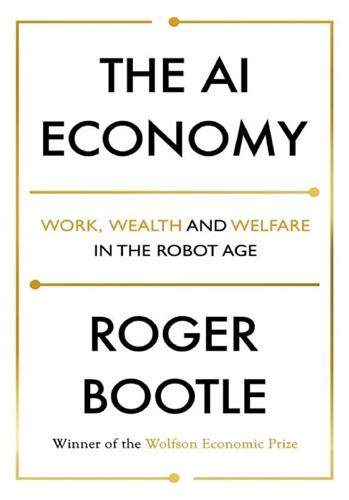
The AI Economy: Work, Wealth and Welfare in the Robot Age
by
Roger Bootle
Published 4 Sep 2019
Deep Blue was able to evaluate between 100 and 200 million positions per second. Kasparov said: “I had played a lot of computers but had never experienced anything like this. I could feel – I could smell – a new kind of intelligence across the table.” In 2001 an IBM machine called Watson beat the best human players at the TV quiz game Jeopardy! In 2013 a DeepMind AI system taught itself to play Atari video games like Breakout and Pong, which involve hand–eye coordination. This was much more significant that it might have seemed. The AI system wasn’t taught how to play video games, but rather how to learn to play the games.
…
But I have yet to meet anyone who thinks that, given sufficient time for evolution to play out, bats are going to surpass humans in general intelligence. And the philosopher John Searle penned an opinion piece in the Wall Street Journal that wittily put the achievement of Watson in winning Jeopardy! into perspective. It appeared under the headline: “Watson Doesn’t Know It Won on ‘Jeopardy!’” Searle pointed out that Watson did not dream about it beforehand or celebrate it afterward. No chats with friends, no commiserations with vanquished opponents.33 Murray Shanahan has recognized the limitations. He has said: “A chatbot that is programed to crack a few jokes or a humanoid robot whose eyes can follow you around a room can easily give a contrary impression.
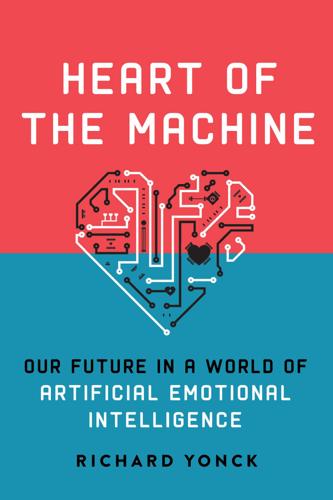
Heart of the Machine: Our Future in a World of Artificial Emotional Intelligence
by
Richard Yonck
Published 7 Mar 2017
In time, Andrew desires to be granted full recognition as a human, a goal it eventually attains near the story’s end. Today, in the twenty-first century, we find ourselves facing a future in which our machines are consistently and repeatedly besting us in all manner of intellectual pursuits. IBM’s Deep Blue beat world chess champion Garry Kasparov in a six-game match in 1997. In 2011, IBM’s Watson (DeepQA) defeated the two all-time Jeopardy champions Brad Rutter and Ken Jennings in a two-day contest of general knowledge. Google’s AlphaGo soundly trounced the longtime world Go grandmaster, Lee Sedol, in four games out of five in March 2016. Given all this, it seems one of the few remaining aspects of machine intelligence left to explore in fiction is how they interact with the world emotionally.
…
This is hardly the first time something like this has happened. In 2011, Eric Brown, the head of IBM’s DeepQA project, decided to teach its AI Watson using the Urban Dictionary, an online resource intended to capture modern slang and street talk. This was soon after the AI’s famous win on the game show Jeopardy. Brown’s reasoning was that this would be an excellent way to learn the intricacies of informal conversation. Shortly thereafter, the AI began swearing up a storm. The DeepQA team was forced to remove the new input from Watson’s vocabulary and design a swear filter for it as well.2 Something similarly unexpected occurred in 2012 when Google’s secretive X Lab decided to let its best artificial neural network loose on the web without any defined instructions or guidance.
…
In May 2016, the Wall Street Journal carried a story about a teacher’s assistant for an artificial intelligence course at the Georgia Institute of Technology.9 One of nine assistants for more than three hundred students, Jill Watson was conversational, knowledgeable, and efficient. Jill was also an AI developed by professor of computer science Ashok Goel. Built on IBM’s Watson platform, Jill operates at a 97 percent confidence level.10 Goel estimated that within a year, Jill would be able to handle 40 percent of all online student questions. Though in its current form Jill is devoid of an emotion channel, she fooled Goel’s students because the role mostly didn’t call for the AI to be affectively aware.

Fully Automated Luxury Communism
by
Aaron Bastani
Published 10 Jun 2019
Rise of the Robots In 1997 IBM’s Deep Blue defeated grandmaster Garry Kasparov over a series of chess matches, becoming the first computer to do so. While that was an iconic moment in the unfolding story of humans and machines, it paled in comparison to Watson, also built by IBM, when it later defeated Ken Jennings and Brad Rutter – two of the greatest Jeopardy! players in the history of the TV quiz show. Chess is a uniquely challenging game, but Jeopardy!, which demands real-time pattern recognition and creative thinking, more closely resembles the features associated with distinctively human intelligence. Not long after, Ken Jennings neatly summed up what that defeat might mean for white-collar work – which values pattern recognition and creative thinking – over the coming decades.
…
Not long after, Ken Jennings neatly summed up what that defeat might mean for white-collar work – which values pattern recognition and creative thinking – over the coming decades. Just as factory jobs were eliminated in the twentieth century by new assembly-line robots, Brad and I were the first knowledge-industry workers put out of work by the new generation of ‘thinking’ machines. ‘Quiz show contestant’ may be the first job made redundant by Watson, but I’m sure it won’t be the last. That was an insightful conclusion. While machines had bested humans at things like chess and solving maths problems – feats we typically associate with genius – they did so by brute force, completing incomprehensible numbers of calculations.
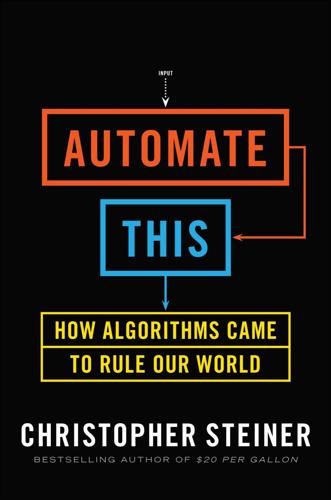
Automate This: How Algorithms Came to Rule Our World
by
Christopher Steiner
Published 29 Aug 2012
But what’s become clear in the years since Deep Blue’s victory is that algorithms will continue to invade professions and skill areas that we have always assumed will remain inherently human. Chess was just the beginning. In early 2011, IBM’s newest creation, Watson, bested all human contestants on the game show Jeopardy!—including Ken Jennings, the most prolific champion in the show’s history. That a bot could be so intellectually nimble in the way it processed random questions, speedily consulted raw stores of data, and issued answers was impressive. Whereas chess is a game played on a limited board with rigid rules, Jeopardy! is chaotic, arbitrary, and offers almost no guidelines on the content or nature of its queries, which can be pocked with humor, puns, and irony.
…
Watson won’t miss clues on those rare cases because he’s simply not prejudiced to rely on the easy answers. Soon after its Jeopardy! triumph, IBM began working with doctors and researchers at Columbia University to develop a version of Watson that won’t be a mere novelty in health care but a true caregiver and diagnostic authority. In September 2011, the giant health insurer WellPoint announced plans to give Watson a job assisting doctors in their offices with diagnoses, providing a valuable and legitimate second opinion. WellPoint’s main purpose in using Watson is saving money, but in paying IBM for Watson’s time, patients also receive the benefit of more correct initial diagnoses.
…
The tryst gave us what Peter Parham, an immunogeneticist at Stanford, calls “hybrid vigor,” endowing us with a powerful immune system that allowed humans to colonize the world.23 A generation from now, algorithms like Patterson’s will scan our DNA and tell us what diseases we’re likely to get and even when they may come. Treating those maladies will be handled by a computer the world knows well: IBM’s Watson. When you head to the doctor’s office with a health quandary, your appointment usually goes something like this: Your doctor asks a question, you answer; your doctor asks another question, you answer. This pattern goes on until your caregiver can suss out what she thinks is your exact problem.

12 Bytes: How We Got Here. Where We Might Go Next
by
Jeanette Winterson
Published 15 Mar 2021
Cope is a thoughtful human, and for him, the interest of creating programmes that create music is as much for the questions it asks us, the ‘real’ humans, to consider. Big Question: What is ‘real’? Next Big Question: What is ‘creativity’? 40 years on from Cope’s first experiments, AI has come a long way, and contemporary music is making good use of AI programmes to generate music. IBM’s Watson Beat, Sony’s Flow Machines, Spotify’s Creator Technology, plus the user-friendly Amper that offers ‘musician-trained Creative AI’. The process of training the AI is exactly as Ada envisioned it nearly 200 years ago. (Go girl!) The programmer-human feeds in as much existing music material as possible so that the programme itself can analyse patterns – tempo, beat, chord progressions, vocals, length, variations – then the human composer sets the parameters – upbeat anthem, moody love song – and works creatively with what comes out.
…
* * * Cars you can still pilot yourself will be factory-fitted with smart sensors. These will be able to listen in to your conversations, your radio stations, to detect your alcohol or drug consumption. Even your mood. If you start having a fight with your boyfriend, the car can call the cops, or direct you to pull over, with a warning that your insurance rating is in jeopardy. Telematics are very interesting to insurance companies; the crude black boxes fitted to monitor the road behaviour of rookie drivers will be swishly inbuilt in new cars and with a whole range of new features. Speeding? You could get an instant fine. Road rage? All recorded. Where were you last weekend?
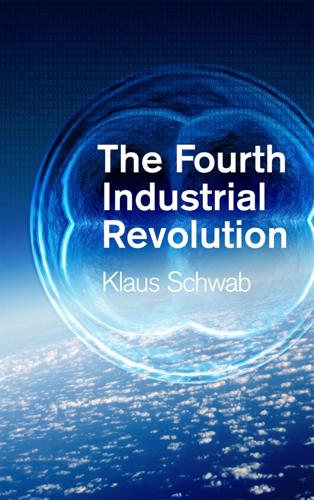
The Fourth Industrial Revolution
by
Klaus Schwab
Published 11 Jan 2016
, 17 September 2013 Positive impacts – Cost reductions – Efficiency gains – Unlocking innovation, opportunities for small business, start-ups (smaller barriers to entry, “software as a service” for everything) Negative impacts – Job losses – Accountability and liability – Change to legal, financial disclosure, risk – Job automation (refer to the Oxford Martin study) The shift in action Advances in automation were reported on by FORTUNE: “IBM’s Watson, well known for its stellar performance in the TV game show Jeopardy!, has already demonstrated a far more accurate diagnosis rate for lung cancers than humans – 90% versus 50% in some tests. The reason is data. Keeping pace with the release of medical data could take doctors 160 hours a week, so doctors cannot possibly review the amount of new insights or even bodies of clinical evidence that can give an edge in making a diagnosis.
…
Informed by a tumour’s genetic make-up, doctors will be able to make decisions about a patient’s cancer treatment. While our understanding of the links between genetic markers and disease is still poor, increasing amounts of data will make precision medicine possible, enabling the development of highly targeted therapies to improve treatment outcomes. Already, IBM’s Watson supercomputer system can help recommend, in just a few minutes, personalized treatments for cancer patients by comparing the histories of disease and treatment, scans and genetic data against the (almost) complete universe of up-to-date medical knowledge.11 The ability to edit biology can be applied to practically any cell type, enabling the creation of genetically modified plants or animals, as well as modifying the cells of adult organisms including humans.
…
– Blurring the lines between man and machine Unknown, or cuts both ways – Cultural shift – Disembodiment of communication – Improvement of performance – Extending human cognitive abilities will trigger new behaviours The shift in action – Cortical computing algorithms have already shown an ability to solve modern CAPTCHAs (widely used tests to distinguish humans from machines). – The automotive industry has developed systems monitoring attention and awareness that can stop cars when people are falling asleep while driving. – An intelligent computer program in China scored better than many human adults on an IQ test. – IBM’s Watson supercomputer, after sifting through millions of medical records and databases, has begun to help doctors choose treatment options for patients with complex needs. – Neuromorphic image sensors, i.e. inspired how the eye and brain communicate, will have impact ranging from battery usage to robotics – Neuroprosthetics are allowing disabled people to control artificial members and exoskeletons.

Deep Work: Rules for Focused Success in a Distracted World
by
Cal Newport
Published 5 Jan 2016
Once we’ve stipulated this reality, we must then step back to remind ourselves that it doesn’t undermine the general value of depth. Why? Because the necessity of distraction in these executives’ work lives is highly specific to their particular jobs. A good chief executive is essentially a hard-to-automate decision engine, not unlike IBM’s Jeopardy!-playing Watson system. They have built up a hard-won repository of experience and have honed and proved an instinct for their market. They’re then presented inputs throughout the day—in the form of e-mails, meetings, site visits, and the like—that they must process and act on. To ask a CEO to spend four hours thinking deeply about a single problem is a waste of what makes him or her valuable.
…
“At first, the team resisted the experiment,” she recalled about one of the trials. “The partner in charge, who had been very supportive of the basic idea, was suddenly nervous about having to tell her client that each member of her team would be off one day a week.” The consultants were equally nervous and worried that they were “putting their careers in jeopardy.” But the team didn’t lose their clients and its members did not lose their jobs. Instead, the consultants found more enjoyment in their work, better communication among themselves, more learning (as we might have predicted, given the connection between depth and skill development highlighted in the last chapter), and perhaps most important, “a better product delivered to the client.”
…
Estimate how long you’d normally put aside for an obligation of this type, then give yourself a hard deadline that drastically reduces this time. If possible, commit publicly to the deadline—for example, by telling the person expecting the finished project when they should expect it. If this isn’t possible (or if it puts your job in jeopardy), then motivate yourself by setting a countdown timer on your phone and propping it up where you can’t avoid seeing it as you work. At this point, there should be only one possible way to get the deep task done in time: working with great intensity—no e-mail breaks, no daydreaming, no Facebook browsing, no repeated trips to the coffee machine.
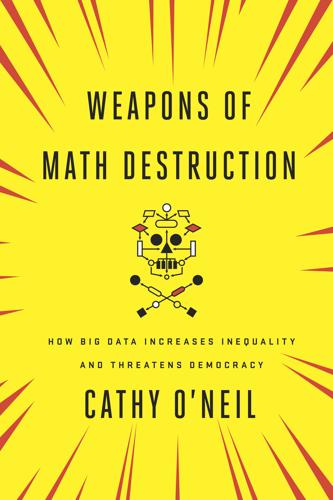
Weapons of Math Destruction: How Big Data Increases Inequality and Threatens Democracy
by
Cathy O'Neil
Published 5 Sep 2016
Mui, “Little-Known Firms Tracking Data Used in Credit Scores,” Washington Post, July 16, 2011, www.washingtonpost.com/business/economy/little-known-firms-tracking-data-used-in-credit-scores/2011/05/24/gIQAXHcWII_story.html. a butterfly’s diet was “Kosher”: Stephen Baker, “After ‘Jeopardy,’ ” Boston Globe, February 15, 2011, www.boston.com/bostonglobe/editorial_opinion/oped/articles/2011/02/15/after_jeopardy/. labeled them as gorillas: Alistair Barr, “Google Mistakenly Tags Black People as ‘Gorillas,’ Showing Limits of Algorithms,” Wall Street Journal, July 1, 2015, http://blogs.wsj.com/digits/2015/07/01/google-mistakenly-tags-black-people-as-gorillas-showing-limits-of-algorithms/.
…
Errors are inevitable, as in any statistical program, but the quickest way to reduce them is to fine-tune the algorithms running the machines. Humans on the ground only gum up the works. This trend toward automation is leaping ahead as computers make sense of more and more of our written language, in some cases processing thousands of written documents in a second. But they still misunderstand all sorts of things. IBM’s Jeopardy!-playing supercomputer Watson, for all its brilliance, was flummoxed by language or context about 10 percent of the time. It was heard saying that a butterfly’s diet was “Kosher,” and it once confused Oliver Twist, the Charles Dickens character, with the 1980s techno-pop band the Pet Shop Boys. Such errors are sure to pile up in our consumer profiles, confusing and misdirecting the algorithms that manage more and more of our lives.

Mistakes Were Made (But Not by Me): Why We Justify Foolish Beliefs, Bad Decisions, and Hurtful Acts
by
Carol Tavris
and
Elliot Aronson
Published 6 May 2007
The theory inspired more than 3,000 experiments that, taken together, have transformed psychologists' understanding of how the human mind works. Cognitive dissonance has even escaped academia and entered popular culture. The term is everywhere. The two of us have heard it in TV newscasts, political columns, magazine articles, bumper stickers, even on a soap opera. Alex Trebek used it on Jeopardy, Jon Stewart on The Daily Show, and President Bartlet on The West Wing. Although the expression has been thrown around a lot, few people fully understand its meaning or appreciate its enormous motivational power. In 1956, one of us (Elliot) arrived at Stanford University as a graduate student in psychology.
…
She lost. 3 Two of the earliest and still best books on the day-care scandals and claims of widespread cults that were promoting ritual Satanic sexual abuse are Debbie Nathan and Michael Snedeker (1995), Satan's Silence: Ritual Abuse and the Making of a Modern American Witch Hunt, New York: Basic Books; and Stephen J. Ceci and Maggie Bruck (1995), Jeopardy in the Courtroom: A Scientific Analysis of Children's Testimony, Washington, DC: American Psychological Association. Dorothy Rabinowitz, a Wall Street Journal editorial writer, was the first to publicly question the conviction of Kelly Michaels and get her case reopened; see also Rabinowitz (2003), No Crueler Tyrannies: Accusation, False Witness, and Other Terrors of Our Times.
…
Meehl (1989), "Clinical versus Actuarial Judgment," Science, 243, pp. 1668–1674. Meehl's findings have been repeatedly reconfirmed. See Howard Grob (1998), Studying the Clinician: Judgment Research and Psychological Assessment. Washington, DC: American Psychological Association. 26 Our account of the Kelly Michaels case is based largely on Ceci and Bruck, Jeopardy in the Courtroom (note 3); and Pendergrast, Victims of Memory (note 2). See also Maggie Bruck and Stephen Ceci (1995), "Amicus Brief for the Case of State of New Jersey v. Margaret Kelly Michaels, Presented by Committee of Concerned Social Scientists," Psychology, Public Policy, & Law, 1(2) [entire issue]. 27 Quoted in Pendergrast, Victims of Memory, p. 423; note 2. 28 Jason J.
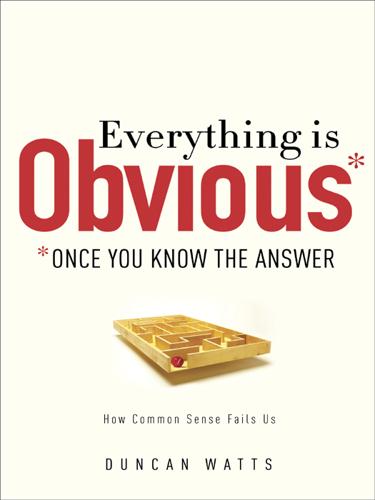
Everything Is Obvious: *Once You Know the Answer
by
Duncan J. Watts
Published 28 Mar 2011
Tetlock, Philip E. 2005. Expert Political Judgment: How Good Is It? How Can We Know? Princeton, NJ: Princeton University Press. Thaler, Richard H., and Cass R. Sunstein. 2008. Nudge: Improving Decisions about Health, Wealth, and Happiness. New Haven, CT: Yale University Press. Thompson, Clive. 2010. “What Is I.B.M.’s Watson?” New York Times Magazine (June 20):30–45. Thorndike, Edward L. 1920. “A Constant Error on Psychological Rating.” Journal of Applied Psychology 4:25–9. Tomlinson, Brian, and Clive Cockram. 2003. “SARS: Experience at Prince of Wales Hospital, Hong Kong.” The Lancet 361 (9368):1486–87. Tuchman, Barbara W. 1985.
…
This approach, which nowadays is called machine learning, was far less intuitive than the original cognitive approach, but it has proved to be much more productive, leading to all kinds of impressive breakthroughs, from the almost magical ability of search engines to complete queries as you type them to building autonomous robot cars, and even a computer that can play Jeopardy!18 WE DON’T THINK THE WAY WE THINK WE THINK The frame problem, however, isn’t just a problem for artificial intelligence—it’s a problem for human intelligence as well. As the psychologist Daniel Gilbert describes in Stumbling on Happiness, when we imagine ourselves, or someone else, confronting a particular situation, our brains do not generate a long list of questions about all the possible details that might be relevant.
…
In fact, one can always do this trivially by exhaustively including every item and concept in the known universe in the basket of potentially relevant factors, thereby making what at first seems to be a global problem local by definition. Unfortunately, this approach succeeds only at the expense of rendering the computational procedure intractable. 18. For an introduction to machine learning, see Bishop (2006). See Thompson (2010) for a story about the Jeopardy-playing computer. 19. For a compelling discussion of the many ways in which our brains misrepresent both our memories of past events and our anticipated experience of future events, see Gilbert (2006). As Becker (1998, p. 14) has noted, even social scientists are prone to this error, filling in the motivations, perspectives, and intentions of their subjects whenever they have no direct evidence of them.

Human Compatible: Artificial Intelligence and the Problem of Control
by
Stuart Russell
Published 7 Oct 2019
It seems simply impractical to expect a machine to rediscover all this from scratch, starting from raw sensory data. At present, however, natural language technology is not up to the task of reading and understanding millions of books—many of which would stump even a well-educated human. Systems such as IBM’s Watson, which famously defeated two human champions of the Jeopardy! quiz game in 2011, can extract simple information from clearly stated facts but cannot build complex knowledge structures from text; nor can they answer questions that require extensive chains of reasoning with information from multiple sources. For example, the task of reading all available documents up to the end of 1973 and assessing (with explanations) the probable outcome of the Watergate impeachment process against then president Nixon would be well beyond the current state of the art.
…
The second elaboration is to allow for some probability of human error—that is, Harriet might sometimes switch Robbie off even when his proposed action is reasonable, and she might sometimes let Robbie go ahead even when his proposed action is undesirable. We can put this probability of human error into the mathematical model of the assistance game and find the solution, as before. As one might expect, the solution to the game shows that Robbie is less inclined to defer to an irrational Harriet who sometimes acts against her own best interests. The more randomly she behaves, the more uncertain Robbie has to be about her preferences before deferring to her. Again, this is as it should be—for example, if Robbie is an autonomous car and Harriet is his naughty two-year-old passenger, Robbie should not allow himself to be switched off by Harriet in the middle of the freeway.
…
See artificial intelligence (AI) intelligent personal assistants, 67–71, 101 commonsense modeling and, 68–69 design template for, 69–70 education systems, 70 health systems, 69–70 personal finance systems, 70 privacy considerations, 70–71 shortcomings of early systems, 67–68 stimulus–response templates and, 67 understanding content, improvements in, 68 International Atomic Energy Agency, 249 Internet of Things (IoT), 65 interpersonal services as the future of employment, 122–24 algorithmic bias and, 128–30 decisions affecting people, use of machines in, 126–28 robots built in humanoid form and, 124–26 intractable problems, 38–39 inverse reinforcement learning, 191–93 IQ, 48 Ishiguro, Hiroshi, 125 is-ought problem, 167 “it’s complicated” argument, 147–48 “it’s impossible” argument, 149–50 “it’s too soon to worry about it” argument, 150–52 jellyfish, 16 Jeopardy! (tv show), 80 Jevons, William Stanley, 222 JiaJia (robot), 125 jian ai, 219 Kahneman, Daniel, 238–40 Kasparov, Garry, 62, 90, 261 Ke Jie, 6 Kelly, Kevin, 97, 148 Kenny, David, 153, 163 Keynes, John Maynard, 113–14, 120–21, 122 King Midas problem, 136–40 Kitkit School (software system), 70 knowledge, 79–82, 267–72 knowledge-based systems, 50–51 Krugman, Paul, 117 Kurzweil, Ray, 163–64 language/common sense problem, 79–82 Laplace, Pierre-Simon, 54 Laser-Interferometer Gravitational-Wave Observatory (LIGO), 82–84 learning, 15 behavior, learning preferences from, 190–92 bootstrapping process, 81–82 culture and, 19 cumulative learning of concepts and theories, 82–87 data-driven view of, 82–83 deep learning, 6, 58–59, 84, 86–87, 288–93 as evolutionary accelerator, 18–20 from experience, 285–93 explanation-based learning, 294–95 feature engineering and, 84–85 inverse reinforcement learning, 191–93 reinforcement learning, 17, 47, 55–57, 105, 190–91 supervised learning, 58–59, 285–93 from thinking, 293–95 LeCun, Yann, 47, 165 legal profession, 119 lethal autonomous weapons systems (LAWS), 110–13 Life 3.0 (Tegmark), 114, 138 LIGO (Laser-Interferometer Gravitational-Wave Observatory), 82–84 living standard increases, and AI, 98–100 Lloyd, Seth, 37 Lloyd, William, 31 Llull, Ramon, 40 Lodge, David, 1 logic, 39–40, 50–51, 267–72 Bayesian, 54 defined, 267 first-order, 51–52, 270–72 formal language requirement, 267 ignorance and, 52–53 programming, development of, 271 propositional (Boolean), 51, 268–70 lookahead search, 47, 49–50, 260–61 loophole principle, 202–3, 216 Lovelace, Ada, 40, 132–33 loyal AI, 215–17 Luddism accusation, 153–54 machines, 33 “Machine Stops, The” (Forster), 254–55 machine translation, 6 McAfee, Andrew, 117 McCarthy, John, 4–5, 50, 51, 52, 53, 65, 77 malice, 228–29 malware, 253 map navigation, 257–58 mathematical proofs for beneficial AI, 185–90 mathematics, 33 matrices, 33 Matrix, The (film), 222, 235 MavHome project, 71 mechanical calculator, 40 mental security, 107–10 “merge with machines” argument, 163–65 metareasoning, 262 Methods of Ethics, The (Sidgwick), 224–25 Microsoft, 250 TrueSkill system, 279 Mill, John Stuart, 217–18, 219 Minsky, Marvin, 4–5, 76, 153 misuses of AI, 103–31, 253–54 behavior modification, 104–7 blackmail, 104–5 deepfakes, 105–6 governmental reward and punishment systems, 106–7 intelligence agencies and, 104 interpersonal services, takeover of, 124–31 lethal autonomous weapons systems (LAWS), 110–13 mental security and, 107–10 work, elimination of, 113–24 mobile phones, 64–65 monotonicity and, 24 Moore, G.

A More Beautiful Question: The Power of Inquiry to Spark Breakthrough Ideas
by
Warren Berger
Published 4 Mar 2014
Picasso was onto this truth fifty years ago when he commented, “Computers are useless—they only give31 you answers.” On the other hand, technology can serve up amazing, innovative, life-changing answers—if we know how to ask for them. The potential is mind-boggling,32 as IBM’s Watson system demonstrates. Its winning appearance in 2011 on the TV quiz show Jeopardy! proved it could answer questions better than any human. Today, IBM is feeding the system a steady diet of, among other things, medical information—so that it can answer just about any question a doctor might throw at it (If patient exhibits symptoms A, B, and C, what might this indicate?).
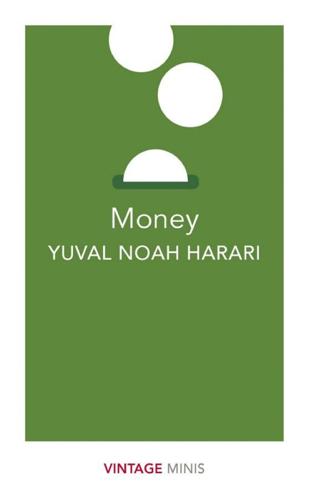
Money: Vintage Minis
by
Yuval Noah Harari
Published 5 Apr 2018
Similarly, no doctor can be familiar with every illness and drug, or read every new article published in every medical journal. To top it all, the doctor is sometimes tired or hungry or perhaps even sick, which affects her judgement. No wonder that doctors sometimes err in their diagnoses or recommend a less-than-optimal treatment. Now consider IBM’s famous Watson – an artificial intelligence system that won the Jeopardy! television game show in 2011, beating human former champions. Watson is currently groomed to do more serious work, particularly in diagnosing diseases. An AI such as Watson has enormous potential advantages over human doctors. Firstly, an AI can hold in its databanks information about every known illness and medicine in history.
…
It will then make sense to trust this algorithm with more and more of my decisions and life choices. We have already crossed this line as far as medicine is concerned. In hospitals we are no longer individuals. It is highly likely that during your lifetime many of the most momentous decisions about your body and your health will be taken by computer algorithms such as IBM’s Watson. And this is not necessarily bad news. Diabetics already carry sensors that automatically check their sugar level several times a day, alerting them whenever it crosses a dangerous threshold. In 2014 researchers at Yale University announced the first successful trial of an ‘artificial pancreas’ controlled by an iPhone.

The Deep Learning Revolution (The MIT Press)
by
Terrence J. Sejnowski
Published 27 Sep 2018
I was a speaker at an IBM-sponsored cognitive computing conference in San Francisco in 2015.2 IBM was making a big investment in Watson, a program based on collections of large databases of facts about everything from history to popular culture that could be interrogated with a wide range of algorithms using a natural language interface. Ken Jennings had won 74 games in a row over 192 days on Jeopardy!, the longest winning streak in the history of the game show. When Watson nonetheless beat Jennings on Jeopardy! in 2011, the world took notice. In the taxi from my hotel to the conference, I overheard two IBM executives in the back of the car talking shop.
…
The energy function was a measure of how well the network satisfied all the constraints (See box 7.1). The vision problem required a solution that was the global energy minimum, the best solution, whereas the Hopfield net, by design, found only local minima of the energy. I had recently come across a paper in the journal Science by Scott Kirkpatrick, then at IBM’s Thomas J. Watson Research Center in Yorktown Heights, New York, that I thought could help.13 Kirkpatrick used a method called “simulated annealing” to get around local minima. Suppose you had a bunch of components in an electrical circuit that had to be mounted onto two circuit boards. What would be the best placement of the parts to minimize the number of wires needed to connect them?
…
Checkers is a relatively easy game, but Samuel’s program, based on a cost function to assess the strengths of different game positions, much like previous game programs, and run on IBM’s first commercial computer, the IBM 701, which used vacuum tubes, was impressive in one novel respect: it learned by playing itself. 144 Chapter 10 Before moving on to IBM’s Thomas J. Watson Research Center in Yorktown Heights, New York, Gerald Tesauro worked with me when he was at the Center for Complex Systems Research at the University of Illinois in Urbana-Champaign on the problem of teaching a neural network to play backgammon (figure 10.1).2 Our approach used expert supervision to train networks with backprop to evaluate game positions and possible moves.
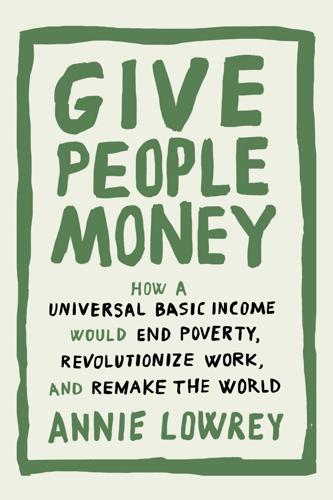
Give People Money
by
Annie Lowrey
Published 10 Jul 2018
“Could another person learn to do your job”: Martin Ford, Rise of the Robots (New York: Basic Books, 2015), ebook. “outperforming humans in all tasks”: Katja Grace et al., “When Will AI Exceed Human Performance? Evidence from AI Experts,” arXiv:1705.08807v2, May 30, 2017, https://arxiv.org/abs/1705.08807v2. hospitals have already started to use IBM’s Watson technology: Ike Swetlitz and Casey Ross, “A New Advertising Tack for Hospitals: IBM’s Watson Supercomputer Is in the House,” STAT, Sept. 6, 2017. “Machines, the argument goes”: Ugo Gentilini and Ruslan Yemtsov, “Being Open-Minded About Universal Basic Income,” Let’s Talk Development (blog), World Bank, Jan. 6, 2017, http://blogs.worldbank.org/developmenttalk/being-open-minded-about-universal-basic-income.
…
If the AI systems got good enough and regulatory reforms allowed it, education and health care—two giant and growing employment sectors commonly considered resistant to productivity improvements and to technological unemployment—might find themselves transformed. Cash-strapped state and local governments might allow students to go to school at home, learning and taking tests on smart, interactive AI systems approved by school boards. Major hospitals have already started to use IBM’s Watson technology to help doctors make diagnoses—soon, they might fire doctors to make way for telemedicine, photo-driven diagnostics, and automated care. Little self-commanding robots might start irrigating sinuses and excising moles. Insurers might start giving incentives for patients to speak with AI systems rather than a blood-and-bones doctor.
…
Once a year, in bleakest January, carmakers head to the Motor City to show off their newest models, technologies, and concept vehicles to industry figures, the press, and the public. Each automaker takes its corner of the dark, carpeted cavern of the Cobo Center and turns it into something resembling a game-show set: spotlights, catwalks, light displays, scantily clad women, and vehicle after vehicle, many rotating on giant lazy Susans. I spent hours at a recent show, ducking in and out of new models and talking with auto executives and sales representatives. I sat in an SUV as sleek as a shark, the buttons and gears and dials on its dashboard replaced with a virtual cockpit straight out of science fiction.

Falter: Has the Human Game Begun to Play Itself Out?
by
Bill McKibben
Published 15 Apr 2019
If it works, it will take only twenty years to get the featherweight probe there. In fact, the very mission I was watching lift off at Cape Canaveral carried the first artificial intelligence into space, an orb called CIMON (Crew Interactive Mobile CompaniON) that had been equipped with the same Watson AI gear that IBM used to win on Jeopardy! and beat the world’s best Go players. CIMON looks a lot like the original iMac, and in weightlessness, it would float around the space station until summoned, and then use little fans to fly across the capsule and face the astronaut, who could then ask it various technical questions. Before liftoff, a team of chipper Teutonic gents from Airbus, who had developed the orb, talked at some length about how it would offer “partnership and even companionship,” and how it would display “infinite patience,” and how it would be “like a buddy, like a good friend working together.”
…
See also glaciers; sea ice iGen immune systems Inconvenient Truth, An (film) Inconvenient Truth … or Convenient Fiction, An (film) India individualism Indonesia inequality inertia infant mortality Ingraffea, Tony insects InsideClimateNews (website) Institute for Justice Intel Intergovernmental Panel on Climate Change (IPCC) Interior, Department of the International Congress of Genetics, Sixteenth International Organization for Migration International Space Station internet Inuit Iowa IQ scores Iran Iraq Ireland irrigation Italy IVF treatment Jackson, Jesse Jacobs, Jane Jacobson, Mark Jaeger, John Jakarta Japan Java Sea jellyfish Jenner, Kylie Jeopardy! (TV show) Jetnil-Kijiner, Kathy Jobs, Steve John Birch Society Johnson, Lyndon B. Journal of Mathematical Biology Journal of Physical Therapy Science Joy, Bill Joyce, James Kac, Eduardo Kaepernick, Colin Kalanick, Travis Kansas Kasparov, Gary Kavanaugh, Brett Kempf, Hervé Kennedy, John F.
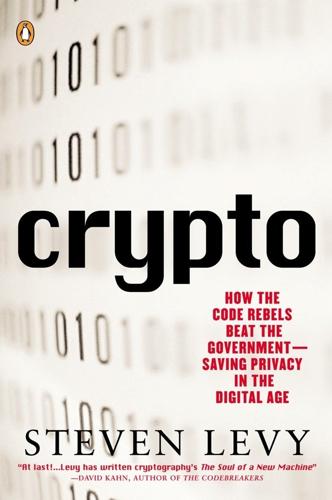
Crypto: How the Code Rebels Beat the Government Saving Privacy in the Digital Age
by
Steven Levy
Published 15 Jan 2002
He and Fischer went to see a friend in Cambridge who mentioned a fellow named Alan Tritter. Tritter supposedly had done work in cryptography. He now worked for IBM. So during that same summer of 1974, Diffie tracked him down at the major center of cryptographic activity outside the government, IBM’s T. J. Watson Labs, in Westchester County, New York. Even in a field littered with brilliant oddballs, Tritter stood out. Due to a rare disease that generated a massive volume of body fat, he weighed what friends estimated as a minimum of 400 pounds. Rumor had it that his grandfather had been a wealthy man who had left Tritter only enough money to attend school.
…
Afterward, the NSA folks would hold postmortems to determine whether the IBM scientists might have stumbled on information or techniques “of a sensitive nature.” In that case NSA would then formally notify the company, and IBM would keep the information under wraps. The NSA certainly did know its stuff. It was particularly interested in a technique discovered by the IBM researchers that was referred to at Watson labs as the “T Attack.” Later it would be known as “differential cryptanalysis.” This was a complicated series of mathematical assaults that required lots of chosen plaintext (meaning that the attacker needed to have matched sets of original dispatches and encrypted output). Sometime that year, the Watson researchers had discovered that, under certain conditions, the IBM cipher could fall prey to a T Attack—a successful foray could actually allow a foe to divine the bits of the key.
…
Diffie’s Privacy on the Line does the best job. 40 during the war David Kahn, unpublished notes on an interview with Feistel, March 29, 1976. 40 told Whit Diffie Diffie, Privacy on the Line, p. 57. 40 a co-worker Alan Konheim 41 Computers now constitute Horst Feistel, “Cryptography and Computer Privacy,” Scientific American, Vol. 228, No. 5, May 1973, pp. 15–23. 41 IBM colleague Feistel told Diffie that the Watson Labs researcher John Lynn Smith came up with the name. 49 his report “A Study of the Lucifer Crypto-Algorithm,” August 18, IBM Memorandum, 1973. 52 dez While the Kingston engineers commonly used this single syllable, the mathematicians at Watson fussily referred to it as Dee-Ee-Ess. 55 technical article “The Data Encryption Standard and Its Strength Against Attacks,” IBM Research Journal, Vol. 38, No. 3, May 1994. 63 summary U.S.
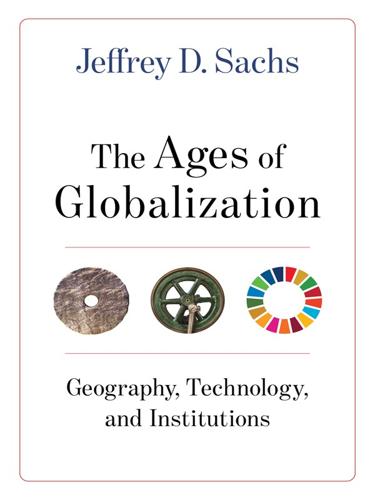
The Ages of Globalization
by
Jeffrey D. Sachs
Published 2 Jun 2020
Today, a “self-taught” AI chess system can learn chess from scratch in a few hours, with no library of games or any other expert inputs on chess strategy, and trounce not only the current world chess champion but all past computer champions such as Deep Blue. In 2011, another IBM system, named Watson, learned to play the TV game show Jeopardy, with all of the puns and quips of popular culture and natural language, and beat world-class Jeopardy champions live on television. This too was a startling achievement, edging yet closer to passing the Turing test. After the Jeopardy championship, Watson went on to the field of medicine, working with doctors to hone expert diagnostic systems. More recently, we have seen stunning breakthroughs in deep neural networks, that is neural networks with hundreds of layers of artificial neurons.
…
See information and communications technologies Ieyasu, Tokugawa, 150 illiteracy, of countries, 164, 164–65 impartial spectator, 124 imperialism, 107 India, 148–49 Indian Ocean, 97, 102–4 indigenous people, 102, 116–20 Indo-European language, 50, 64–65 Industrial Age, 2, 4, 7, 11, 195; Britain entering, 133; globalization in, 129; lessons from, 167–68; steam engine in, 16–17, 131–34, 132 industrialization, 5, 7–9; of Britain, 135–38, 142–43, 155; coal in, 27–28, 145; colonial era ending and, 163–64; economic divergence in, 144, 144; Europe’s diffusion of, 141–43; global patterns of, 145–46; of Japan, 150; self-sustaining, 137–38; stages of, 141 industrial production, 14 Industrial Revolution, 17, 138 inequalities, 196–97; challenges from, 185–86; economic, 184; gender, 199; technological changes for, 30 Influence of Sea Power Upon History, 1660–1783, The (Mahan), 112 information, 169 information and communications technologies (ICTs), 141 information technologies, 4–5 infrastructure development, 161 innovative designs, 138–41 In Praise of Folly (Erasmus), 105 input layer, 174 inquiry, age of, 104–6 institutions, 1, 17, 18, 19–20 integrated circuits, 171–72 intelligent technologies, 141 internal combustion engines, 4 International Monetary Fund, 161, 178 investments, 183 invisible hand, 114 iron, 61–62 irrigation, 47 Isabella (queen), 99, 108 Islam, 78, 85–88 Iwakura Mission, 151 James II (king of Britain), 122 Japan: China invaded by, 147; feudal structure of, 151; geography of, 150; industrialization of, 150; as military powerhouse, 146; population of, 150; Russo-Japanese War and, 151; Sino-Japan War and, 151 Jaspers, Karl, 70–71 Jeopardy (game show), 175 Jesuit Order of the Catholic Church, 106 Jin Dynasty, 90 job losses, 185 Judaism, 67 Jurchen horsemen, 90 Kant, Immanuel, 207, 212 Kasparov, Garry, 175–76 Kelekna, Pita, 62, 81 Kennedy, John F., 30–31, 200, 211, 213–14 Kenya-Somalia border, 190, 191 Keynes, John Maynard, 155–56, 158 Kievan Rus, 92 Kilby, Jack, 171 kingdoms, of Egypt, 66 King William’s War, 122 knowledge, advancements in, 105–6 Koch, Alexander, 102 Kondratiev, Nikolai, 139 Kondratiev waves, 139–41, 140 Köppen-Geiger climate system, 22–23, 23, 218 Köppen-Geiger Mediterranean climate zone, 79 Kuhn, Dieter, 90 Kurki, Sofi, 139, 141 land areas, 228n10 land-based empires, 3–4, 73–76 land grants (encomiendas), 117 land power (tellurocracy), 72 land use, 103, 188, 222–23 language, 38, 167; book writings with, 71; in China, 72; from Europe, 50, 64–65; Indo-European, 50, 64–65.
…
The “salvation,” of course, came in the form of slaves, growing the “white gold” in the plantations of the Caribbean and Brazil. Yet even then, upheaval hit the industry with the slave rebellion in Saint-Domingue in 1791, giving birth to an independent Haiti. Britain’s raw material inputs were suddenly in jeopardy. Once again, a solution arose, seemingly providentially from the industry’s point of view. The U.S. South would provide the land and the slave labor to feed Britain’s mills. Beckert explains the essence of this solution: What distinguished the United States from virtually every other cotton-growing area in the world was planters’ command of nearly unlimited suppliers of land, labor, and capital, and their unparalleled political power.

The Man Who Broke Capitalism: How Jack Welch Gutted the Heartland and Crushed the Soul of Corporate America—and How to Undo His Legacy
by
David Gelles
Published 30 May 2022
The starting salary for most of those entry-level jobs was $15 an hour, a figure that, while higher than the federal minimum wage, was not enough to live comfortably on in most American cities. As Bezos was accumulating wealth at a rate of $13.4 million an hour, his newest employees were joining a company that has long been accused of mistreating workers, skimping on benefits, and suppressing organized labor. Even white-collar workers were in jeopardy during the pandemic. Many of the technology companies that benefited from the rise of remote work also felt the need to downsize at a time of record unemployment, casting millions of people into a historically bad job market. Microsoft, Oracle, Comcast, and AT&T all enjoyed rapid rises in their sales, profits, and stock prices during the pandemic, and all of them laid off office workers in 2020.

Of a Fire on the Moon
by
Norman Mailer
Published 2 Jun 2014
VI They are both religious men, yet Armstrong suggests the mystic, whereas Aldrin, with his prodigious will and senses oriented to technological rather than sensuous perception, is nonetheless an elder and trustee of the Webster Presbyterian Church, a formerly “mechanical man” who will go so far as to smuggle consecrated bread and wine aboard the Lem in order to celebrate Communion on the moon, and so is not only a technologue but a high priest, indeed is the pure spiritual ancestor of that line which runs from Calvin, Luther, Knox and Wesley to Edison, Ford, and IBM’s own Watson. So he illumines something in the mystery of the Wasp, gives us purchase on that dichotomy between technology and dogma which inhabits their lives. It is as if ceremony, formal repetitive somber ceremony, has become the communicant between technology and the dream, as if the road back from the machine to the primeval can be accomplished only by transporting the machine-oriented senses into the machine of ceremony.
…
WUI007 NASA 007 PRESS PD FROM WUI PRESS CENTER ABOARD USS HORNET 13 COOK-UPI ABOARD USS HORNET—A NASA OFFICIAL SAID SUNDAY IT WAS HIGHLY UNLIKELY THERE COULD BE A BREACH OF THE QUARANTINE PROCEDURES ON THE HORNET FOR THE APOLLO 11 ASTRONAUTS—AND THAT IF IT OCCURRED WHILE PRESIDENT NIXON WAS ABOARD HE PROBABLY WOULD BE OUT OF JEOPARDY ANYWAY.… “HE [THE PRESIDENT] IS ALWAYS SEPARATED ADEQUATELY SO WE COULD GET HIM COMPLETELY OUT OF JEOPARDY,” STULLKEN SAID. “I DON’T EVEN SEE WHY WE HAVE TO DISCUSS THIS THING,” HE SAID, “IT’S ONE OF THOSE REMOTE POSSIBILITIES. WE MIGHT JUST AS WELL WORRY ABOUT GETTING A TSUNAMI [TIDAL WAVE] DOWN HERE.” III There in the fever of summer, his children restive at his side, Aquarius watched Nixon chat through a microphone while the astronauts smiled at him from the rear window of their new trailer (called the Mobile Quarantine Facility) on board the Hornet.

50 Future Ideas You Really Need to Know
by
Richard Watson
Published 5 Nov 2013
Welcome to the future. It’s metallic and uses lots of batteries. Hopefully, it’s not angry and it won’t work out a way to enslave the human race. the condensed idea The machines wake up timeline 1990 iRobot Corporation founded to manufacture industrial and domestic robots 2011 Watson, an IBM computer, wins Jeopardy!, a US TV show 2027 A $79 toaster passes the Turing test 2040 $750 smartphone contains as much processing power as a human brain 2042 Software virus disables 90 percent of machines 2050 Intelligent robots outnumber human beings 2054 Machines start to paint and compose music 2069 Machines demand equal rights 21 Personalized genomics It’s now possible to sequence, then analyze, the genome of individuals to predict specific human traits or to forecast the probability that an individual will suffer from certain conditions or diseases.

Becoming Steve Jobs: The Evolution of a Reckless Upstart Into a Visionary Leader
by
Brent Schlender
and
Rick Tetzeli
Published 24 Mar 2015
Gates and Grove knew that eventually—and it wasn’t going to take very long at all—the expensive, customized guts of engineering workstations would become juiced-up PC circuit boards, and that the same evolution would ultimately subsume business minicomputers, mainframes, and even supercomputers, those rare and superexpensive machines used for everything from modeling weather patterns to controlling nuclear devices. (For example, IBM’s Watson, the machine that in 2011 beat Jeopardy! phenomenon Ken Jennings, is one such computer based on a PC-like architecture.) As a result, pretty much every computer that companies relied on to manage their most critical operations would adopt the internal electronic architecture of a PC writ large. All were much, much cheaper and easier to program and operate than unwieldy mainframes, because they were built out of the very same semiconductor components as PCs, and usually used a variation of the Windows operating system software.

Adaptive Markets: Financial Evolution at the Speed of Thought
by
Andrew W. Lo
Published 3 Apr 2017
Paradoxically enough, the early primitive computers could deal with the pinnacles of human thought—chess, logic, mathematics—much more easily than with the fundamentals of human life. As computer science progressed, computers were able to imitate many more basic human abilities, such as voice recognition and speech synthesis. Today we have integrated expert systems like the iPhone’s Siri, or IBM’s Jeopardy-winning supercomputer Watson, which answer questions as well as any reasonably smart human—but in a way completely unlike any human. Artificial intelligence has achieved many milestones, but the biggest challenge still remains unmet: to produce truly intelligent behavior. However, artificial intelligence may be getting closer to its goal as several different research paths converge.
…
Second, they want to be able to offer their interpretation of those facts, or correct mistakes made by others that could reflect poorly on them. And finally, the NTSB’s accident report isn’t admissible as evidence in lawsuits for civil damages, which allows the stakeholders to be much more candid about their role in the accident than they might be if they faced legal jeopardy. Once all the facts are collected and agreed on by the various parties, the second phase of the investigation begins. Only the NTSB’s internal staff conducts the analysis, to reduce the chances of conflict of interest. This analysis presents a theory of the probable cause of the accident and rules out opposing theories.
…
Lund, in which he wrote: This letter is written to insure that management is fully aware of the seriousness of the current O-ring erosion problem in the SRM joints from an engineering standpoint.… The result would be a catastrophe of the highest order—loss of human life.… It is my honest and very real fear that if we do not take immediate action to dedicate a team to solve the problem with the field joint having the number one priority, then we stand in jeopardy of losing a flight along with all the launch pad facilities. And on a teleconference call during the evening prior to the January 28 launch, a number of Morton Thiokol engineers, including Boisjoly, raised concerns about the cold temperature and argued for postponing the launch but were overruled by Morton Thiokol and NASA senior management.

Doing Data Science: Straight Talk From the Frontline
by
Cathy O'Neil
and
Rachel Schutt
Published 8 Oct 2013
Lessons Learned from Data Competitions: Data Leakage and Model Evaluation The contributor for this chapter is Claudia Perlich. Claudia has been the Chief Scientist at Media 6 Degrees (M6D) for the past few years. Before that she was in the data analytics group at the IBM center that developed Watson, the computer that won Jeopardy! (although she didn’t work on that project). Claudia holds a master’s in computer science, and got her PhD in information systems at NYU. She now teaches a class to business students on data science, where she addresses how to assess data science work and how to manage data scientists.

How to Spend a Trillion Dollars
by
Rowan Hooper
Published 15 Jan 2020
A weather program might register the presence of clouds and predict rain, but that’s not because it knows rain comes from clouds, but because it knows clouds are statistically associated with rain. It doesn’t have common sense or, as computer scientists say, causal inference. Watson, the IBM AI that beat the best humans on the word game Jeopardy! can’t play a six-year-old at chess, let alone AlphaZero. Other AIs can play video games, or identify pictures of cats, or recognise your voice and answer questions, or drive cars, or guide missiles to enemy targets, or choose films they think you might want to watch, but none have flexibility to transfer their abilities to new tasks.

Scary Smart: The Future of Artificial Intelligence and How You Can Save Our World
by
Mo Gawdat
Published 29 Sep 2021
In fact, there is nothing artificial about AI – it is a very genuine form of intelligence, albeit different to ours. AI is already smarter than every human on the planet in terms of many specific, isolated tasks. The world’s reigning chess champion has been a machine since soon after computers invaded our lives. The world Jeopardy champion is IBM’s supercomputer, Watson. The world champion of Go is Google’s AlphaGo (Go is an abstract strategy board game invented in China more than 2,500 years ago and is known to be one of the most complex strategy games because of its infinite number of possible board configurations). Machines with incredible image recognition systems power our security systems simply because they see better than us, and the world’s safest driver by far is a self-driving car that not only sees further but pays undivided attention to the road.
…
They figure it out, on their own, through trial and error. Machines learn pretty much the same way. The patterns they are observing, however, are different. Take, for example, Watson, IBM’s supercomputer, which is world champion of the game Jeopardy. For Watson to learn enough to beat humans in such a complex language game, it needed to read more than four million documents. So far, it has only used this knowledge to play Jeopardy. However, it’s not unlikely that this knowledge might be ‘recycled’ to build other forms of intelligence, say, like finding patterns of human behaviour throughout the twentieth century. With a different ‘eye’, Watson would clearly observe the violence we’ve exerted on each other, the bickering amongst Facebook users close to the end of the century and the rise of narcissism evident by the abundance of Photoshopped selfies as digital cameras in mobile phones gave everyone their fifteen seconds of Instagram fame.
…
If you testify and he remains silent, you will be set free while he will serve three years in prison. If he testifies and you remain silent, you will get the three years. You know, however, that the prosecutors are lacking evidence, and accordingly if both of you remain silent, you will each be charged with one year in prison, at most. ‘Solving this game shows that because betraying your partner appears to offer a greater reward than cooperating with them, all purely rational, self-interested prisoners will betray the other. Pursuing individual reward logically leads both of the prisoners to betray each other (and accordingly end up with a two-year sentence each), when they would have got a better individual reward (just a one-year sentence) if they had both kept silent.

Words That Work: It's Not What You Say, It's What People Hear
by
Dr. Frank Luntz
Published 2 Jan 2007
The people Jay interviews are unable to answer basic questions such as “Who is the vice president?” “Which country was America fighting in the Revolutionary War?” and “How many United States Senators are there?” He broadcasts the most egregious examples, to be sure. Still, the people he finds aren’t so different from the rest of us. The syndicated game show Street Smarts explores the same idea. From Beavis and Butt-Head in the 1990s to Bart Simpson, intelligence is mocked and ignorance is celebrated. The problem begins in our elementary schools and high schools. My firm surveyed American teenagers aged thirteen through seventeen on their knowledge of U.S. history.
…
Simply note that you’re a good customer of this airline who flies X-number of miles a year, and that may get you some extra consideration. I’ve been told that a twenty-dollar bill on the counter can also make a difference—but I refuse to try it. I’m too afraid of rejection. Not to mention that anything that could be construed as putting the security of a plane (such as bribing your way onto it) in jeopardy is a surefire way to get the airline employee fired and you banned should you get caught. Anyway, the purpose of this book is the creation of the right language, not making the right bribe, so you’re on your own with other, more unorthodox methods. Be short and to the point. Make your case in no more than four sentences.

WTF?: What's the Future and Why It's Up to Us
by
Tim O'Reilly
Published 9 Oct 2017
THREE TYPES OF ARTIFICIAL INTELLIGENCE As we’ve seen, when experts talk about artificial intelligence, they distinguish between “narrow artificial intelligence” and “general artificial intelligence,” also referred to as “weak AI” and “strong AI.” Narrow AI burst into the public debate in 2011. That was the year that IBM’s Watson soundly trounced the best human Jeopardy players in a nationally televised match in February. In October of that same year, Apple introduced Siri, its personal agent, able to answer common questions spoken aloud in plain language. Siri’s responses, in a pleasing female voice, were the stuff of science fiction. Even when Siri’s attempts to understand human speech failed, it was remarkable that we were now talking to our devices and expecting them to respond.

Empire of AI: Dreams and Nightmares in Sam Altman's OpenAI
by
Karen Hao
Published 19 May 2025
The strength of symbolic AI is in the explicit encoding of information and their relationships into the system, allowing it to retrieve accurate answers and perform reasoning, a feature of human intelligence seen as critical to its replication. Think of IBM Watson, one of the most famous symbolic systems, which would dazzle on Jeopardy! in 2011. Its speedy delivery of game show–winning answers was based in its ability to trawl through vast stores of knowledge and accurately reproduce them. The weakness of symbolism, on the other hand, has been to its detriment: Time and again its commercialization has proven slow, expensive, and unpredictable.
…
See intelligence human longevity, 186–87 human rights, 19–20, 197, 294 Hurd, Will, 321 Huyen, Chip, 52 Hydrazine Capital, 35–36, 38, 41, 69 hyperscalers, 274–75, 277, 279–80, 285, 294, 296 I IBM, 100, 161 Watson, 99 Imagen, 242 ImageNet, 47, 59–60, 100, 101, 117–18, 259 Imitation Game, The (movie), 81–82, 91 Index Ventures, 203 India, 133, 191, 202, 242, 276, 324 industrialization, 39, 272 industrial revolution, 88–89, 93 inequality, 15, 16, 190, 207, 228, 273, 291 inferencing, 98, 236, 373, 374, 378 Inflection AI, 320, 384–85 “information hazard,” 125 Information, The, 33, 213, 280, 371, 403 Inglewood, 279 insider threats, 148 Instacart, 362, 376 Instagram, 334, 404 InstructGPT, 214–17, 246–47 intelligence, 109, 111 definition of, 90–94 “Intelligence Age,” 19, 405 International Energy Agency, 275 IQ tests, 91–92 Irving, Geoffrey, 158–59, 370 Isaac, William, 104 Israel, 47, 207, 337 iterative development, 142, 150, 314–15, 379, 401 J Janah, Leila, 191–92, 206 Jeopardy!
…
There was a project called Flamingo Generation, which gave her a topic and asked her to write “creative” prompts with a minimum of fifty words and responses that resembled “common internet content” like emails, blog posts, news articles, Twitter threads, and haikus. There was another project called Crab Generation, which asked her to copy a piece of reference text from an informative website of her choosing—though not Wikipedia and preferably not Britannica or The New York Times—and then to reverse engineer, Jeopardy!-style, the kind of writing prompt that could generate it. Crab Paraphrase was similar, but instead of reverse engineering the prompts, she needed to paraphrase the reference text based on a specific tone or style—to be funnier, to be more formal, to make it sound like a song from Kanye West.
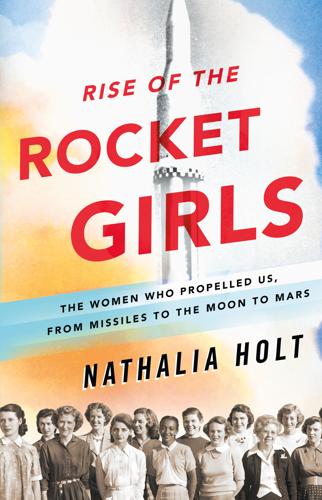
Rise of the Rocket Girls: The Women Who Propelled Us, From Missiles to the Moon to Mars
by
Nathalia Holt
Published 4 Apr 2016
It wasn’t just one big box but eleven separate components that, together, weighed a whopping 20,516 pounds. Notwithstanding its size, the 701 moved IBM into the computer business. At first the company didn’t think it would have many customers for the machine. At a stockholder meeting, IBM’s president, Thomas Watson Jr., explained that they were expecting to sell only five of them, but “we came home with orders for eighteen.” One of those orders was for JPL. Despite a monthly rental price starting at $11,900, the 701 came with no instruction manual. To use the machine one had to learn an obscure numerical code.
…
I pressed the pen to my lips and concentrated, trying to balance my pregnant belly while perched on the wobbly edge of a bar stool. It was the summer of 2010, and my husband and I were trying to come up with names for our daughter’s December arrival. Sitting in a bar in Cambridge, Massachusetts, we brainstormed names, each writing them down privately on a napkin before showing the other, as if we were on some bizarre game show: Name Your Baby! We weren’t having much luck. We both have unusual first names—Nathalia and Larkin—so we wanted to find one that wouldn’t subject our daughter to a lifetime of odd nicknames. When Larkin wrote down Eleanor, I immediately rejected it. It sounded so old-fashioned. I couldn’t imagine naming my daughter that.
…
With the design issues resolved, everyone looked ahead to Ranger 7. Surely, after six miserable failures, this would be the one. It had to be. The launch of Ranger 7 took place on a hot, humid afternoon in July 1964. The control room at JPL was tense. Everyone knew that their jobs, and even the fate of the lab, were in jeopardy. To lighten the mood and distract everyone from the pressure, one of the engineers, Richard Wallace, known as Dick, decided to pass out peanuts. Whether it was the good-luck peanuts or simply the hard-won lessons from six failed missions, the launch went off flawlessly. But it wasn’t time to celebrate yet; the ship had to successfully reach the moon’s surface.

Fire in the Valley: The Birth and Death of the Personal Computer
by
Michael Swaine
and
Paul Freiberger
Published 19 Oct 2014
–Bill Gates Hewlett-Packard and Xerox had made less-than-impressive entries into the personal-computer market, and there was intense curiosity within that industry about how IBM would fare. The megafirm was considered successful in almost everything it had tried. Its reputation had held up at least since the mid-1960s, when IBM owned two-thirds of the computer market. And when IBM chief Thomas J. Watson, Jr., bet the company on a new semiconductor-based computer line that instantly made IBM’s most profitable machines obsolete—and the bet paid off—IBM only appeared all the more infallible. In 1980 a new CEO, Frank Cary, proved willing to risk if not the company, at least some of its pristine reputation on a very un-IBM venture.
…
They had written the core of the BASIC before even meeting anyone from MITS, and, unlike Allen, Gates insisted that he had never been a MITS employee. “Pertec thought they were buying the software as part of the whole deal,” Gates recalled. “And they weren’t. We owned the software. It was all under license.” Suddenly, the whole deal was in jeopardy. Gates later recalled the head of Pertec telling him that if the software were not included in the transaction, Pertec would back out of the deal. If that happened, MITS would fold. The pressure on the boys was tremendous. “They sent out this big-time lawyer,” Gates recalled, and the matter went into arbitration.

Good to Go: What the Athlete in All of Us Can Learn From the Strange Science of Recovery
by
Christie Aschwanden
Published 5 Feb 2019
Irishman Brian Moore is a former middle-distance runner who runs Orreco, a startup company that looks to biomarkers in the blood and other tissues to track how the body is adapting (or maladapting) to training. Moore’s company is built on a shining hope: that data can solve recovery’s most vexing problem. It’s just one of many companies that are betting that biometric data can provide individualized answers about how to manage training and recovery. With help from IBM’s artificial intelligence program, Watson, Orreco is working on ways to use objective measures to help athletes and their coaches distinguish what they need to reach peak performance. “We’re agnostic about where data comes from,” Moore says. “Our product is insights.” That last claim is a common talking point among tech companies, which routinely promise to deliver special knowledge that will change everything.
…
Following the London Marathon in 2007, Hall decided, “I’m not going to take a bunch of time off. I’m just going to keep things rolling.” He’d worked so hard in the buildup to that race that he was afraid that by resting he would lose his hard-won fitness. “By the time the summer came along, I was feeling terrible and getting slower and slower.” With his upcoming Olympic trials marathon in jeopardy, he was finally forced to take a week off to recoup, but it came at a crucial training time. Looking back at it after his retirement, Hall wishes he hadn’t skipped those prescribed rest weeks. If he had it to do over, he says, “I would force myself to take two weeks completely off and get fat and out of shape—that worked every single time I did it.

More: The 10,000-Year Rise of the World Economy
by
Philip Coggan
Published 6 Feb 2020
King, author of Grave New World: The End of Globalization, the Return of History “An engaging and highly accessible narrative about the long historical development of global trade, commerce, and innovation. Philip Coggan writes clearly about how and why it all happened, and gives us cause for optimism in difficult times.” George Magnus, author of Red Flags: Why Xi’s China Is in Jeopardy “Philip Coggan’s More is a monumental work of scholarship that never feels like one while you are reading it. All of human economic history is here, with something you didn’t know on every page, and today’s apparently terrible economic problems put into a clear context. It should be recommended reading for students, economists, anyone who works in business, and anyone with an interest in how our world came to be the way it is.”

The Elusive Quest for Growth: Economists' Adventures and Misadventures in the Tropics
by
William R. Easterly
Published 1 Aug 2002
"^ And Pakistan is imperiled again: ”Pakistan’s projected growth from 146 million today to 345 million by 2050 will shrink its grainland per person from 0.08 hectares at present to 0.03 hectares, an area scarcely the size of a tennis court.”1o The organization Population Action International notes that ”the capacity of farmers to feed the world’s future population is also in jeopardy.”’l The Population Institute warns bluntly of ”The Four Cash for Condoms? 89 Horsemen of the 21st Century Apocalypse: Overpopulation. Deforestation. Water Scarcity. Famine.” As a a result, ”Developed countries will be lookingat staggering disasterrelief budgets as a result ...and only a few years from now.’’12 Not only that but, according to Lester Brown, population grows faster than jobs: ”Inthe absence of an accelerated effort toslow population growth in the years ahead, unemployment could soar to unmanageable levels.”

Big Data: A Revolution That Will Transform How We Live, Work, and Think
by
Viktor Mayer-Schonberger
and
Kenneth Cukier
Published 5 Mar 2013
Dating sites pair up couples on the basis of how their numerous attributes correlate with those of successful previous matches. The “autocorrect” feature in smartphones tracks our actions and adds new words to its spelling dictionary based on what we type. Yet these uses are just the start. From cars that can detect when to swerve or brake to IBM’s Watson computer beating humans on the game show Jeopardy!, the approach will revamp many aspects of the world in which we live. At its core, big data is about predictions. Though it is described as part of the branch of computer science called artificial intelligence, and more specifically, an area called machine learning, this characterization is misleading.
…
For example, using voice-recognition software to characterize complaints to a call center, and comparing that data with the time it takes operators to handle the calls, may yield an imperfect but useful snapshot of the situation. Messiness can also refer to the inconsistency of formatting, for which the data needs to be “cleaned” before being processed. There are a myriad of ways to refer to IBM, notes the big-data expert DJ Patil, from I.B.M. to T. J. Watson Labs, to International Business Machines. And messiness can arise when we extract or process the data, since in doing so we are transforming it, turning it into something else, such as when we perform sentiment analysis on Twitter messages to predict Hollywood box office receipts. Messiness itself is messy.

Before the Storm: Barry Goldwater and the Unmaking of the American Consensus
by
Rick Perlstein
Published 17 Mar 2009
“If this thing comes apart with us—that’s the dilemma. That’s exactly the dilemma.” “It’s damn easy to get into a war,” said the President, “but it’s gonna be awfully hard to extricate yourself if you get in.” Firebugs ginned up their own precinct organizations. They quit school and job to work full-time; marriages were put in jeopardy. Some Goldwater freelancers were more sophisticated than others. “You’ve got to warn the senator right away!” one cried to a Goldwater staffer at a rally in Glendora. “There are men out there taking down every word he says!”—gesturing in the direction of the press corps. One piece of homemade campaign literature that was circulating in California like chewing gum, A Choice Not an Echo, came from one of the sophisticated ones.

The Industries of the Future
by
Alec Ross
Published 2 Feb 2016
Moreover, while weak artificial intelligence, whereby robots simply specialize in a specific function, is currently advancing exponentially, strong artificial intelligence, whereby robots demonstrate humanlike cognition and intelligence, is advancing only linearly. While inventions like IBM’s Watson (the computer designed by IBM that beat Jeopardy! champions Ken Jennings and Brad Rutter) are exciting, scientists need a better understanding of the brain before these advances progress beyond winning a game show. Watson didn’t actually “think”; it was basically a very comprehensive search engine querying a large database. As robotics expert and UC Berkeley professor Ken Goldberg explains, “Robots are going to become increasingly human.

The Friendly Orange Glow: The Untold Story of the PLATO System and the Dawn of Cyberculture
by
Brian Dear
Published 14 Jun 2017
IBM seemed a little bit more hopeful as a partner but in the end disappointed Skinner as well. “They built this machine, which was very good, it was doing what they said it would do, and as a matter of fact they then redesigned it and got a patent based on my patent. But then they stopped it. And one of the engineers there who was dying to see it developed tried hard to get [IBM president] Thomas Watson’s children to try my machine. They had given it to the typewriter division because they had contacts with high schools and he simply said, ‘I can use this money to stay ahead of my competition in typewriters’ and that was that. I don’t think there’s anybody within IBM who knows that that machine is now in the Smithsonian.”
…
“One of the things I learned from the social interaction on PLATO—apart from learning how to be a merely obnoxious jerk as opposed to a totally obnoxious one—was not to take myself too seriously.” Greenberg and Woodhead were gaming addicts, playing Avatar, Empire, and Oubliette. “I’d been thrown out of college for a year—too much PLATO, not enough studying—and decided to try selling software,” says Woodhead. “The PLATO games showed that cool games could be done on computers, so for me the question was, could I do as cool a game on the tiny PCs, in particular when the game would have to be a one-person one? I started work on a game called Paladin for the Apple II, and shortly thereafter by chance discovered that Andy had written a similar game for the Apple in BASIC called Wizardry.
…
“It was pervasive at that point in time,” says Peters. Despite the broad support for PLATO within the School of Music, Peters did find that spending a large amount of one’s career on the system came at a cost. Like PLATO-using professors in other departments, Peters found that his chances at tenure were in jeopardy if all he did was work on PLATO. “I was racing around doing all this work, and I had some of the senior faculty in music education, they just said, ‘Look, this is great, you did some great work, but, it’s not going to get you tenure. If you want to get tenure, you have to write a book.’ ” So Peters went and wrote a textbook, twenty music compositions, and other publications.

The Rise and Fall of American Growth: The U.S. Standard of Living Since the Civil War (The Princeton Economic History of the Western World)
by
Robert J. Gordon
Published 12 Jan 2016
Innovators and tech CEOs both seem positively giddy with optimism.”44 The well-known pair of techno-optimists Erik Brynjolfsson and Andrew McAfee assert that “we’re at an inflection point” between a past of slow technological change and a future of rapid change.45 They appear to believe that Big Blue’s chess victory and Watson’s victory on the TV game show Jeopardy presage an age in which computers outsmart humans in every aspect of human work effort. They remind us that Moore’s Law predicts endless exponential growth of the performance capability of computer chips—but they ignore that chips have fallen behind the predicted pace of Moore’s Law after 2005.
…
Google’s Ngram Viewer is a delightful tool that allows one to look at cultural trends based on the prevalence of key words and phrases that a user can search. 78. O’Brien (2012), p. 189. 79. Munos (2009), p. 962. 80. Vijg (2011), p. 65. 81. Fuchs and Garber (2003), p. 46. 82. The previous two paragraphs summarize and quote Vijg (2011, pp. 63–75). 83. See Cohen (2013) for an account of how data-mining by artificial intelligence such as IBM’s Watson could become a new diagnostic tool. 84. Stevens (1989), pp. 204–20. 85. Stevens (1989), p. 231, 296–301. 86. Starr (1982), p. 368. 87. Yount (2001), p. 9. 88. http://managedhealthcareexecutive.modernmedicine.com/managed-healthcare-executive/content/higher-costs-resulting-medical-arms-race?

The Signal and the Noise: Why So Many Predictions Fail-But Some Don't
by
Nate Silver
Published 31 Aug 2012
Like the moment when, exactly thirteen seconds into “Love Will Tear Us Apart,” the synthesizer overpowers the guitar riff, leaving rock and roll in its dust.43 Except it wasn’t true. Kasparov had been the victim of a large amount of human frailty—and a tiny software bug. How to Make a Chess Master Blink Deep Blue was born at IBM’s Thomas J. Watson Center—a beautiful, crescent-shaped, retro-modern building overlooking the Westchester County foothills. In its lobby are replicas of early computers, like the ones designed by Charles Babbage. While the building shows a few signs of rust—too much wood paneling and too many interior offices—many great scientists have called it home, including the mathematician Benoit Mandelbrot, and Nobel Prize winners in economics and physics.
…
The Weather of Supercomputers The supercomputer labs at the National Center for Atmospheric Research (NCAR) in Boulder, Colorado, literally produce their own weather. They are hot: the 77 trillion calculations that the IBM Bluefire supercomputer makes every second generate a substantial amount of radiant energy. They are windy: all that heat must be cooled, lest the nation’s ability to forecast its weather be placed into jeopardy, and so a series of high-pressure fans blast oxygen on the computers at all times. And they are noisy: the fans are loud enough that hearing protection is standard operating equipment. The Bluefire is divided into eleven cabinets, each about eight feet tall and two feet wide with a bright green racing stripe running down the side.

Artificial Intelligence: A Modern Approach
by
Stuart Russell
and
Peter Norvig
Published 14 Jul 2019
Soon after, the availability of tens of millions of images in the ImageNet database (Deng et al., 2009) sparked a revolution in the field of computer vision. The availability of big data and the shift towards machine learning helped AI recover commercial attractiveness (Havenstein, 2005; Halevy et al., 2009). Big data was a crucial factor in the 2011 victory of IBM’s Watson system over human champions in the Jeopardy! quiz game, an event that had a major impact on the public’s perception of AI. 1.3.8Deep learning (2011–present) The term deep learning refers to machine learning using multiple layers of simple, adjustable computing elements. Experiments were carried out with such networks as far back as the 1970s, and in the form of convolutional neural networks they found some success in hand-written digit recognition in the 1990s (LeCun et al., 1995).
…
It will usually be the case that an agent prefers more money to less, all other things being equal. We say that the agent exhibits a monotonic preference for more money. This does not mean that money behaves as a utility function, because it says nothing about preferences between lotteries involving money. Suppose you have triumphed over the other competitors in a television game show. The host now offers you a choice: either you can take the $1,000,000 prize or you can gamble it on the flip of a coin. If the coin comes up heads, you end up with nothing, but if it comes up tails, you get $2,500,000. If you’re like most people, you would decline the gamble and pocket the million.
…
R., 222, 1114 Galstyan, A., 1060, 1106 Galton, F., 1095 Gamba, A., 836, 1096 Gamba perceptrons, 836 Gamberini, L., 836, 1096 gambling, 26, 521 game, 28 assistance, 52, 613, 866 backgammon, 210, 224, 855, 866 billiards, 225 of chance, 212–214 checkers, 37, 80, 223, 870, 871 chess, 23, 32, 39, 48, 64, 125, 193, 201–204, 222 cooperative, 616 dice, 217 Diplomacy, 197 Go, 207 of imperfect information, 192 incomplete information, 551 inspection game, 596 Kriegspiel, 214 multiplayer, 197–198 normal form, 595 optimal decisions in, 194–201 Othello, 224 partially observable, 214–218 of perfect information, 193 physical, 225 poker, 224, 638 principal-agent, 638 repeated, 598, 604 Reversi, 224 Scrabble, 225 Settlers of Catan, 197 stochastic, 210 Tetris, 562, 571 Yahtzee, 214 zero-sum, 193, 600 game playing, 192–221 game show, 524 game theory, 28, 590, 635 cooperative, 616 non-cooperative, 595–615 Gammage, C., 48, 1113 GAN (generative adversarial network), 831, 838, 1022 Ganchev, K., 904, 1085 Gandomi, A., 737, 1096 Ganguli, S., 837, 838, 1092, 1109 Gannon, L, 474, 1112 Gao, J., 670, 1096 Gao, Q., 47, 834, 901, 916, 1117 Gao, Y., 873, 1100 Garda, E.